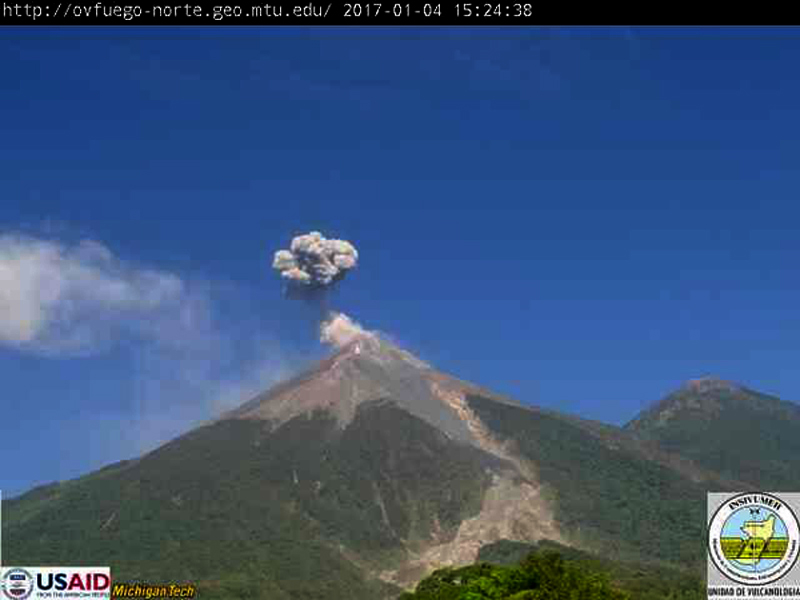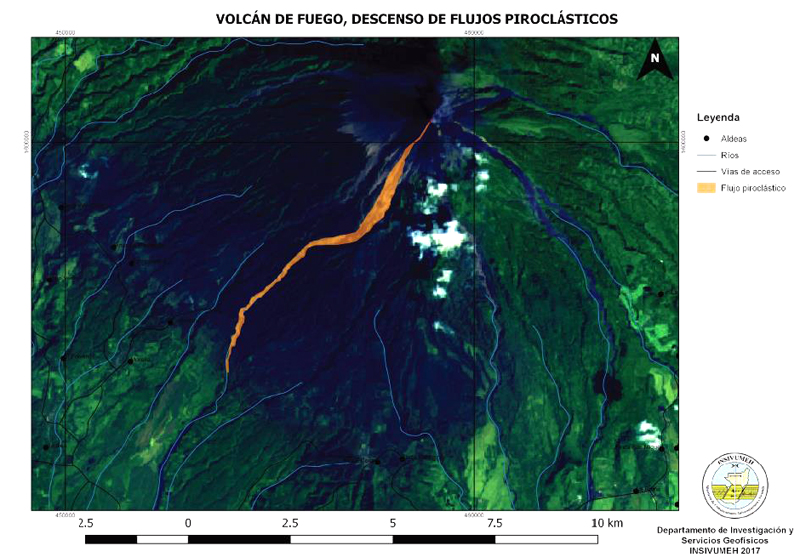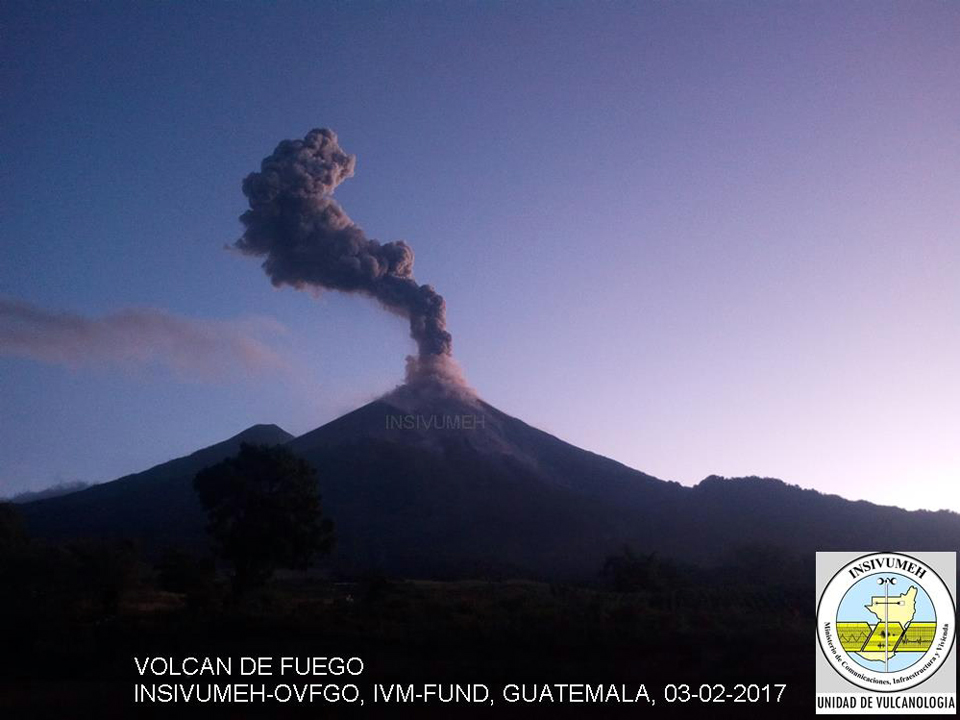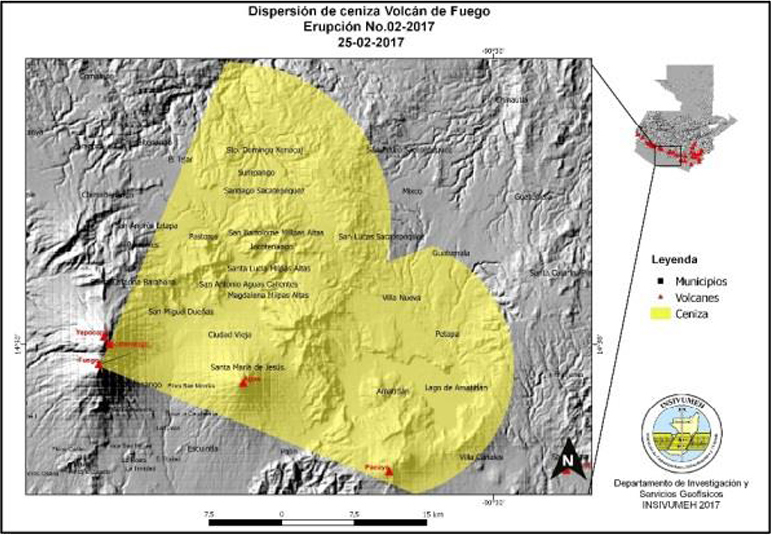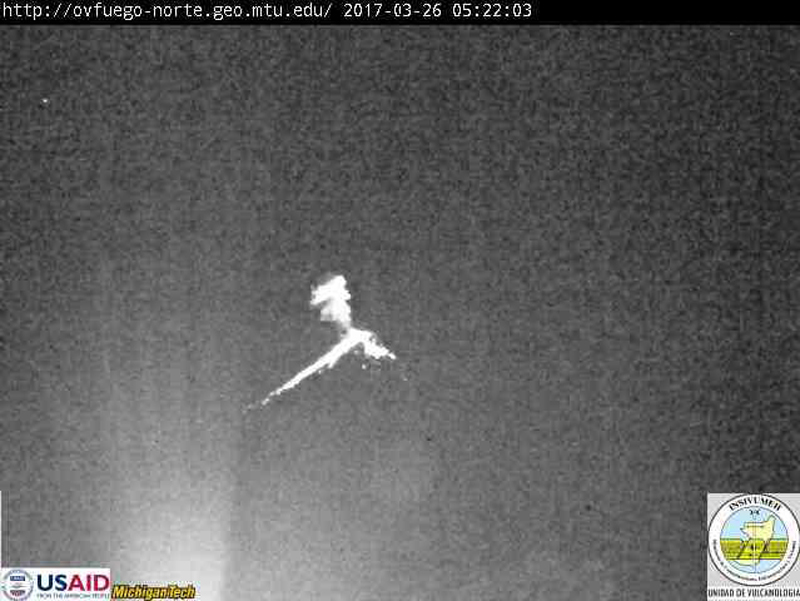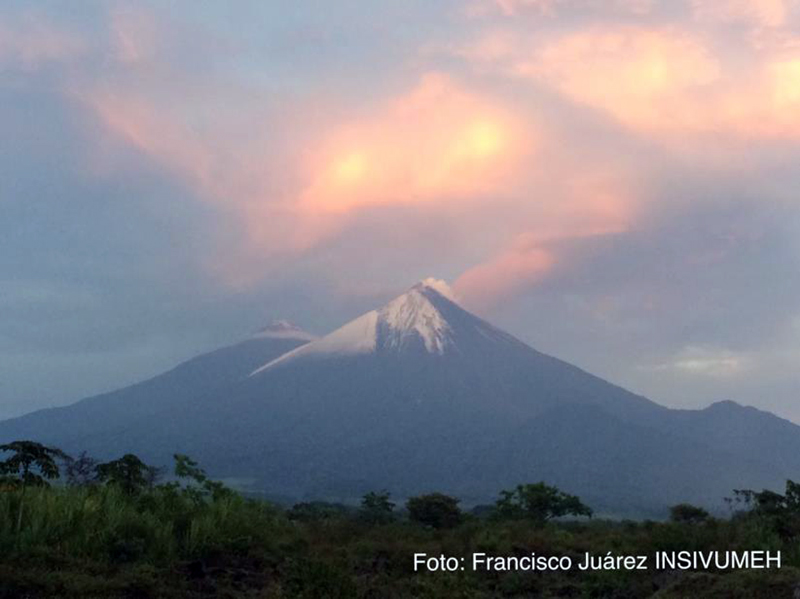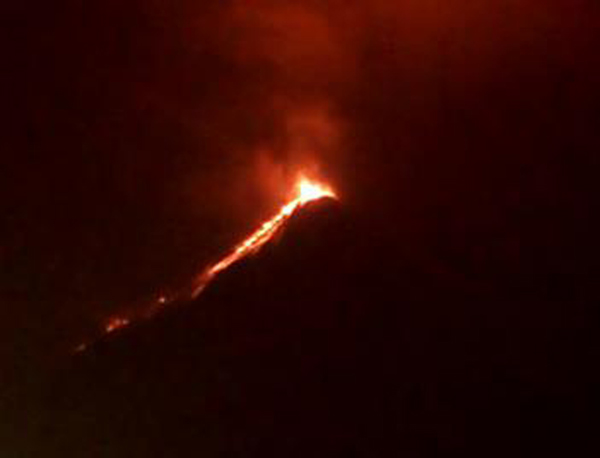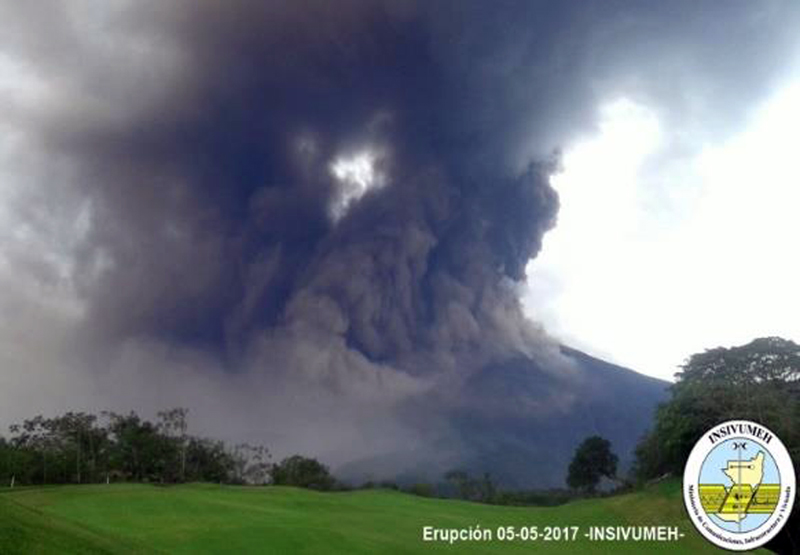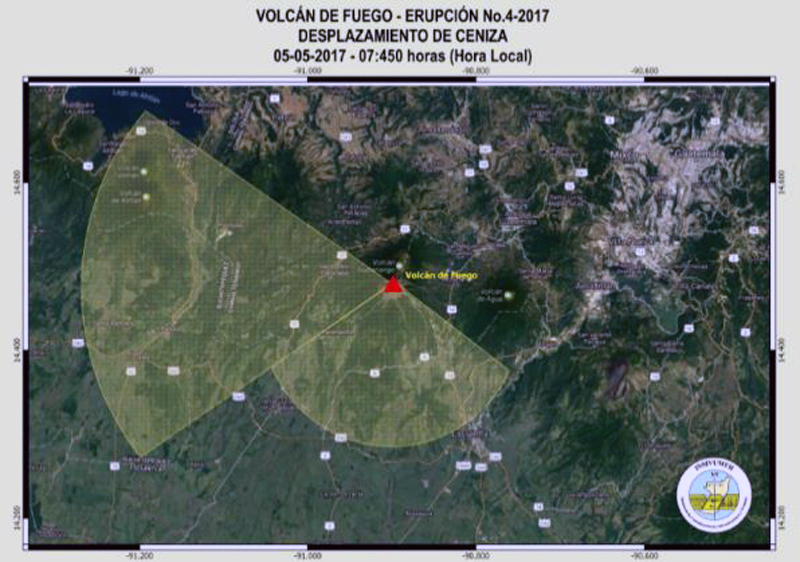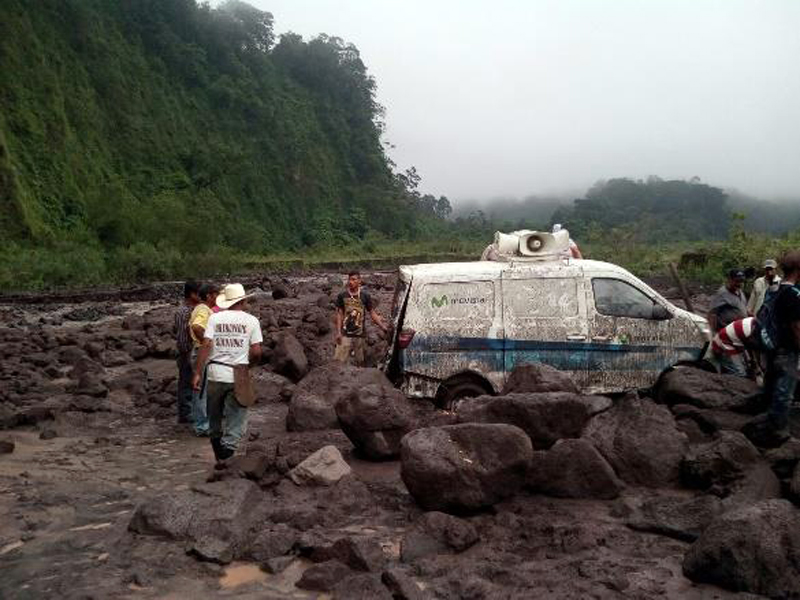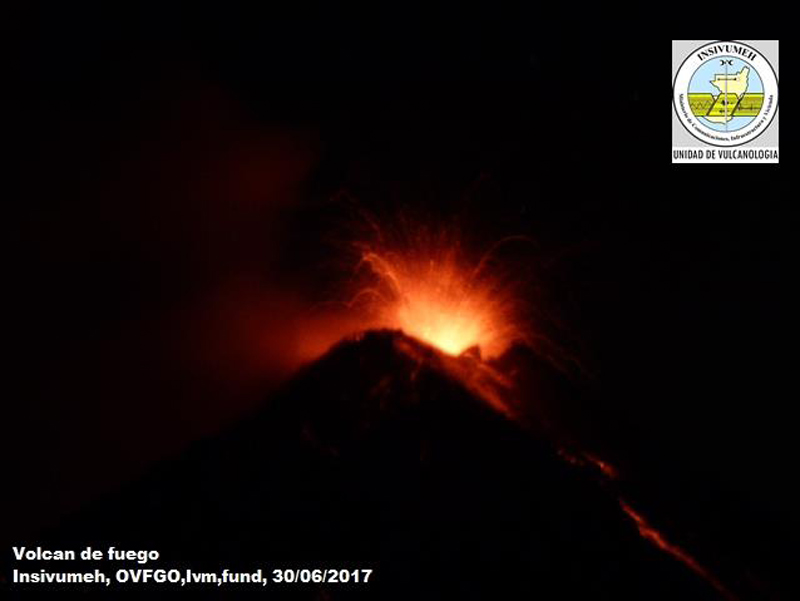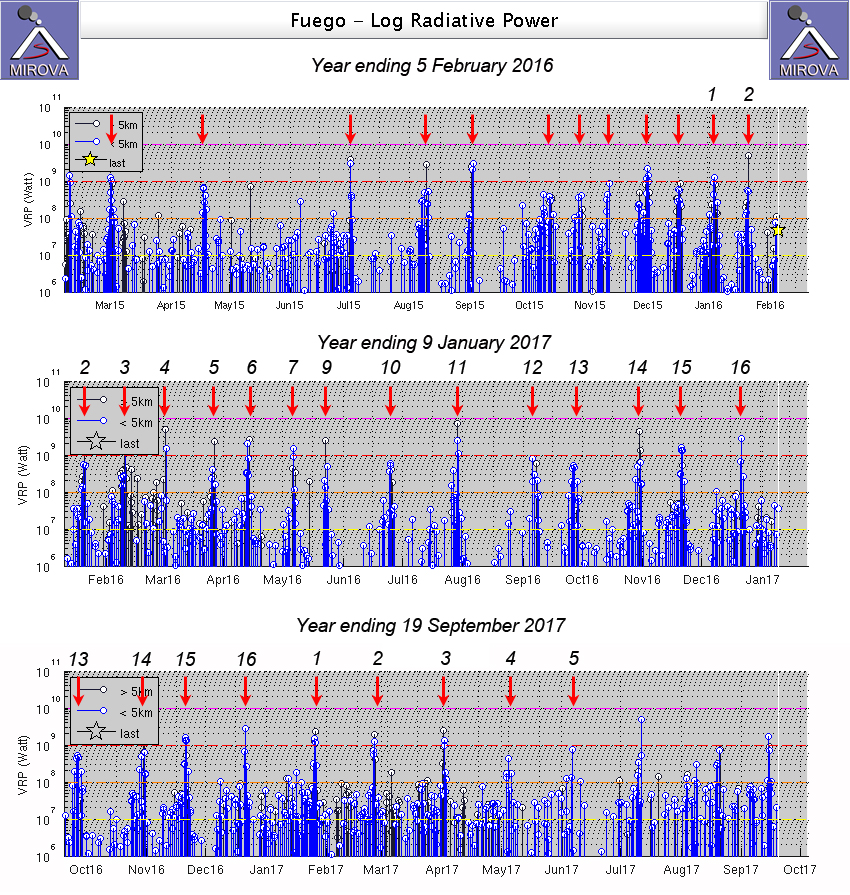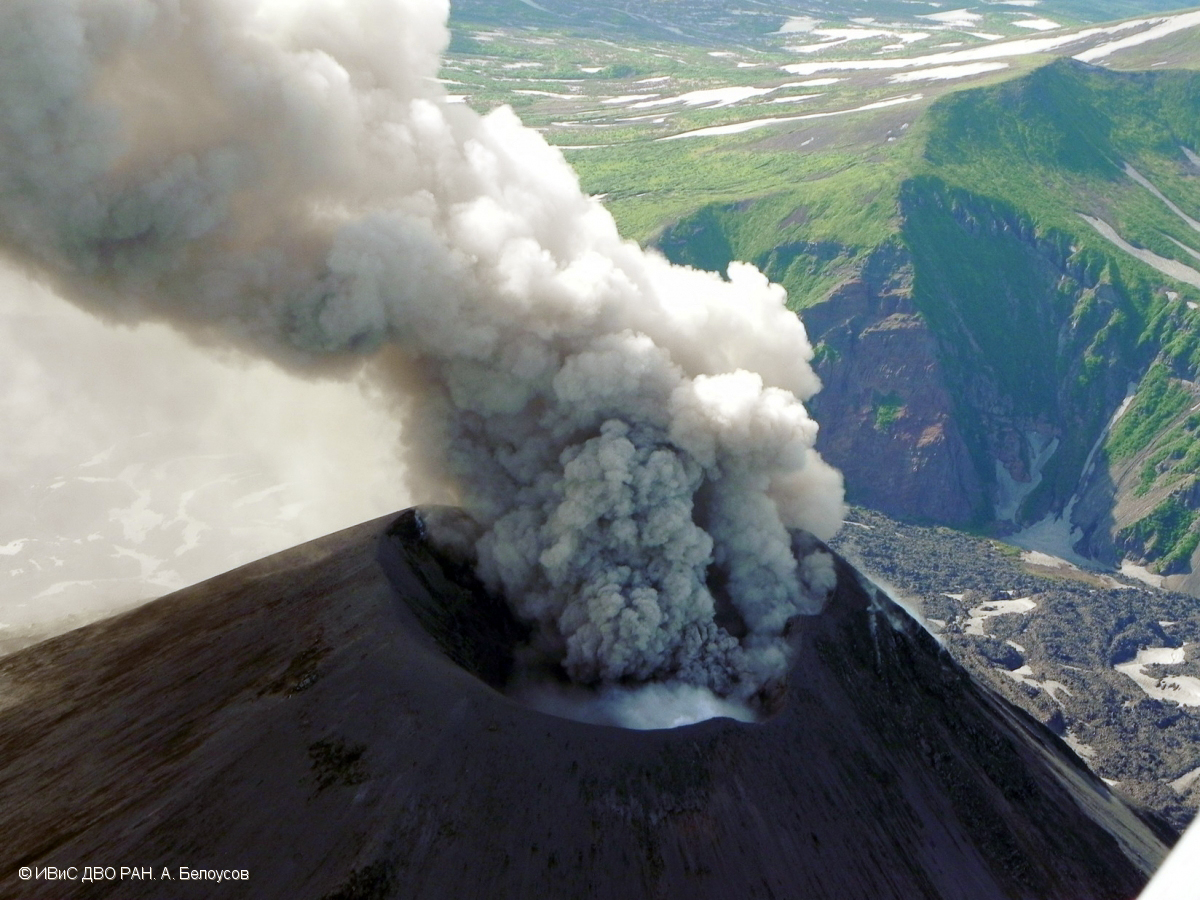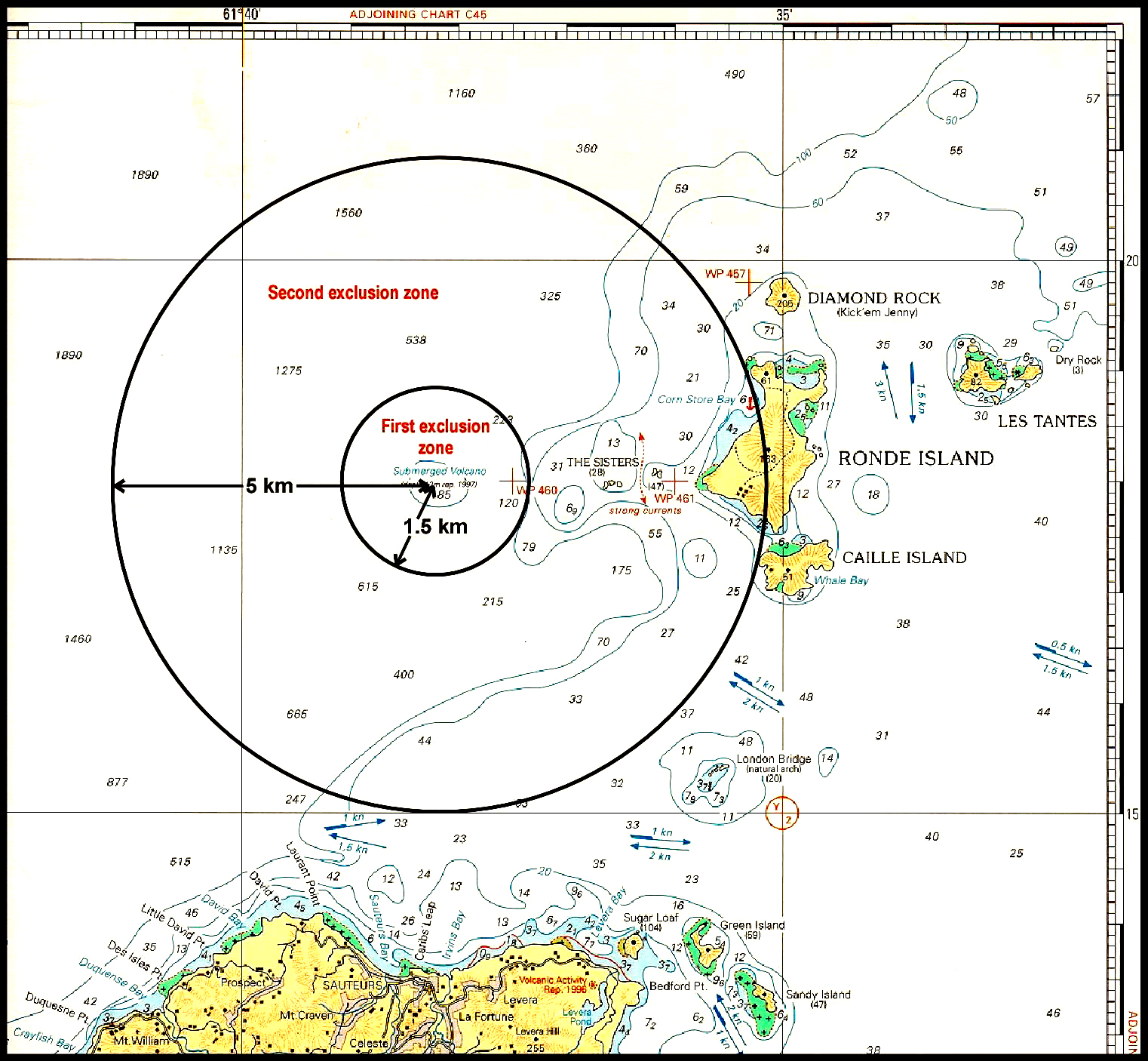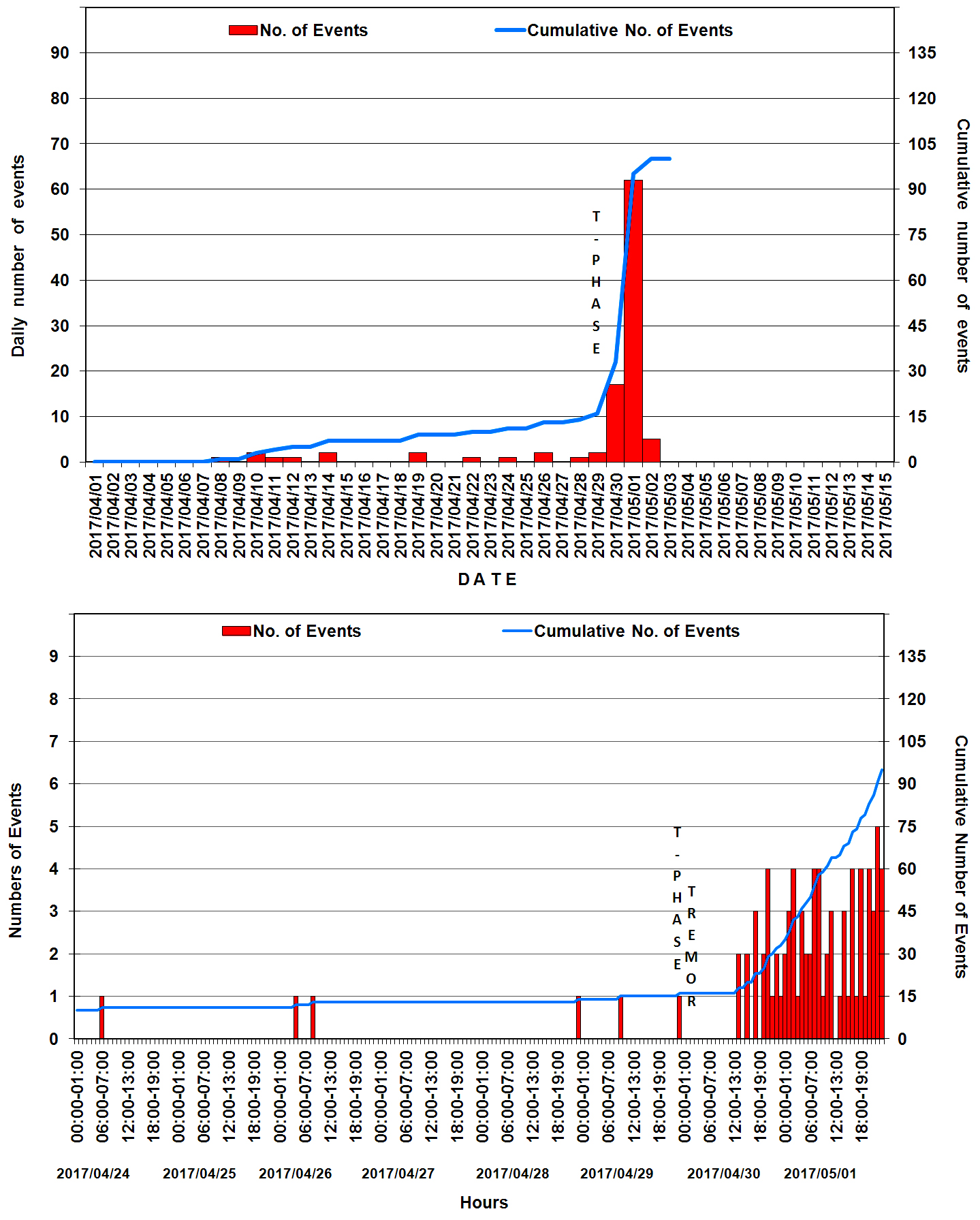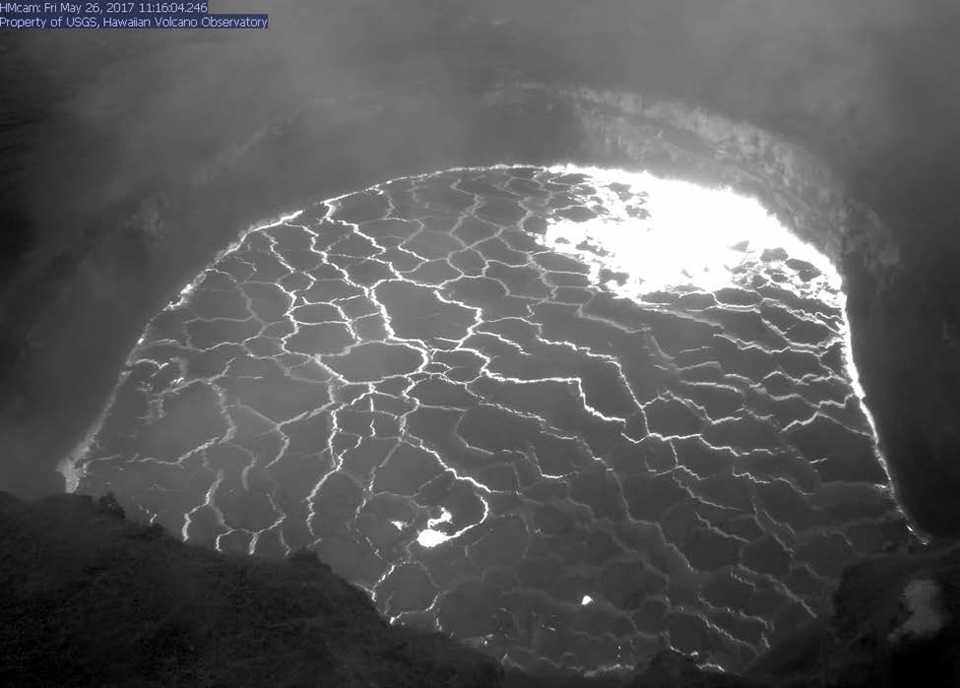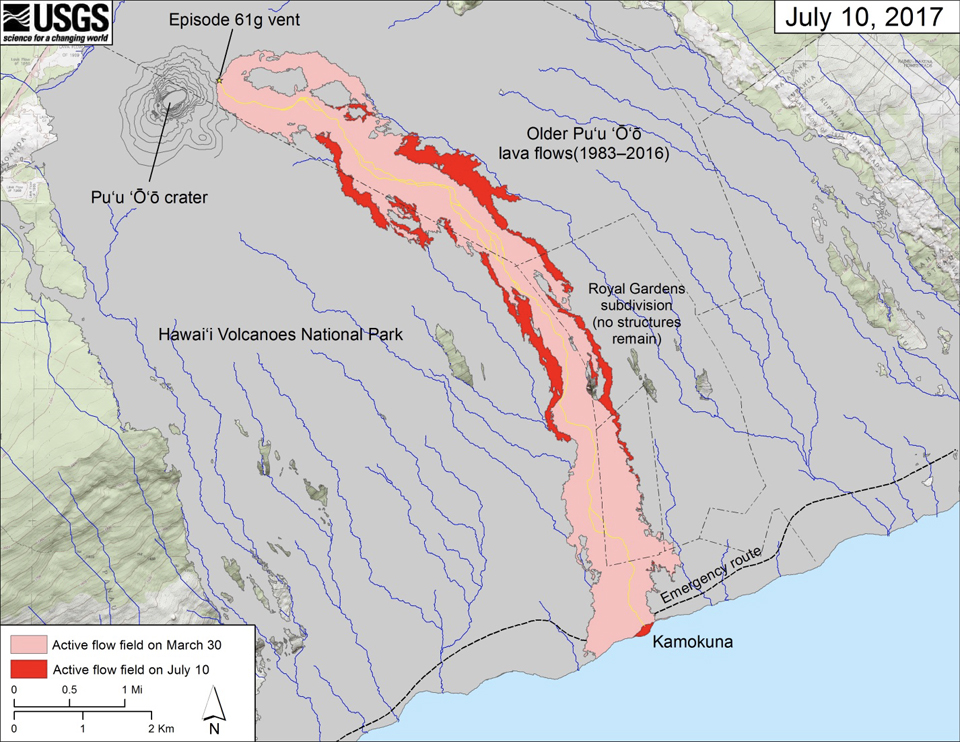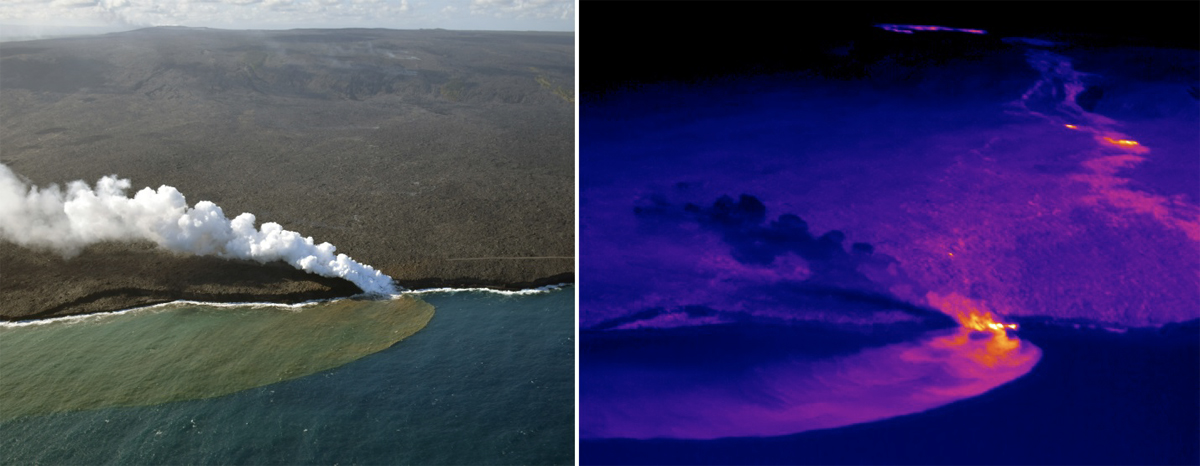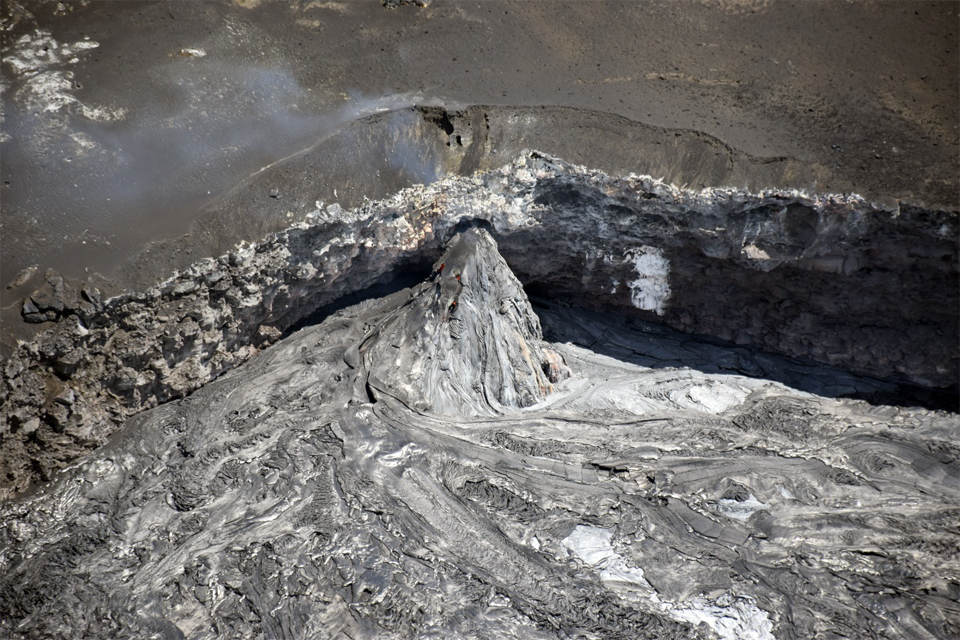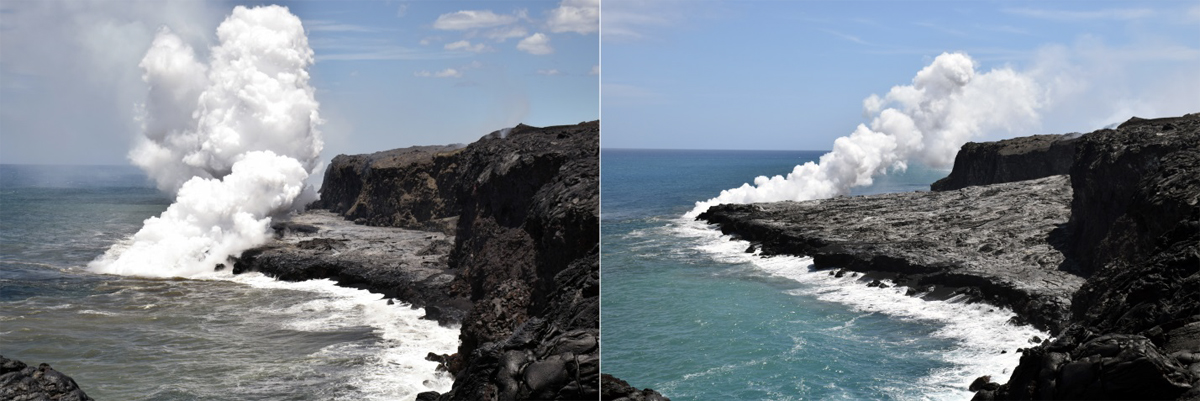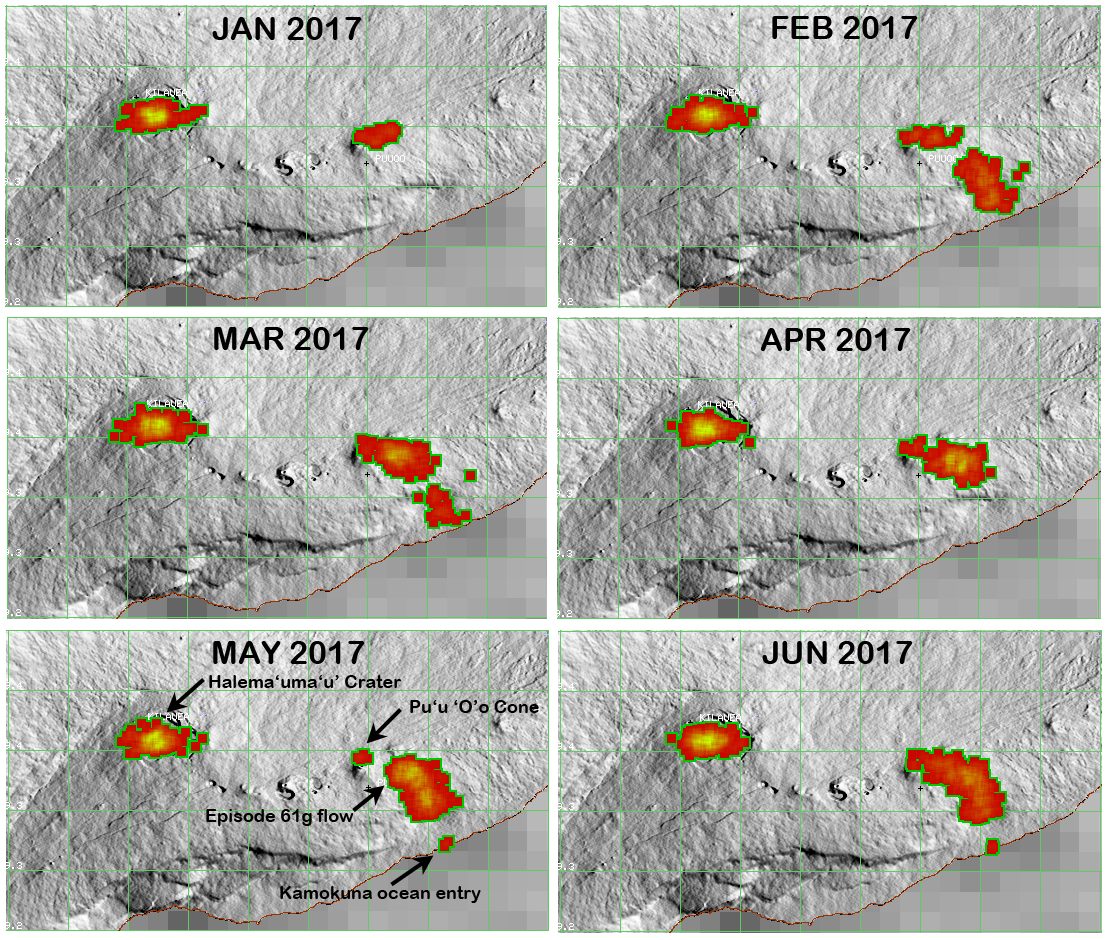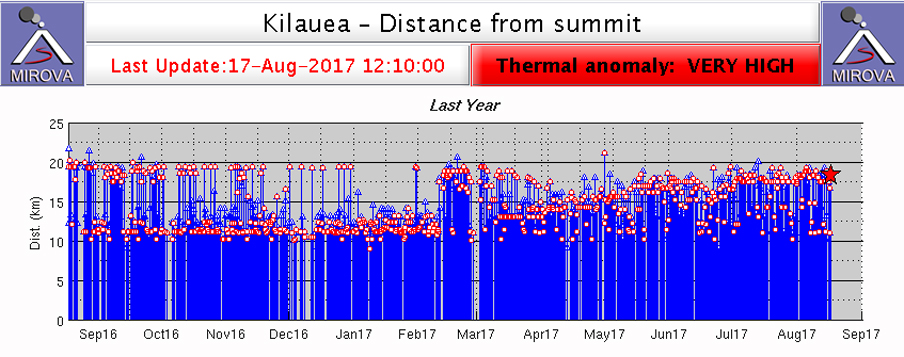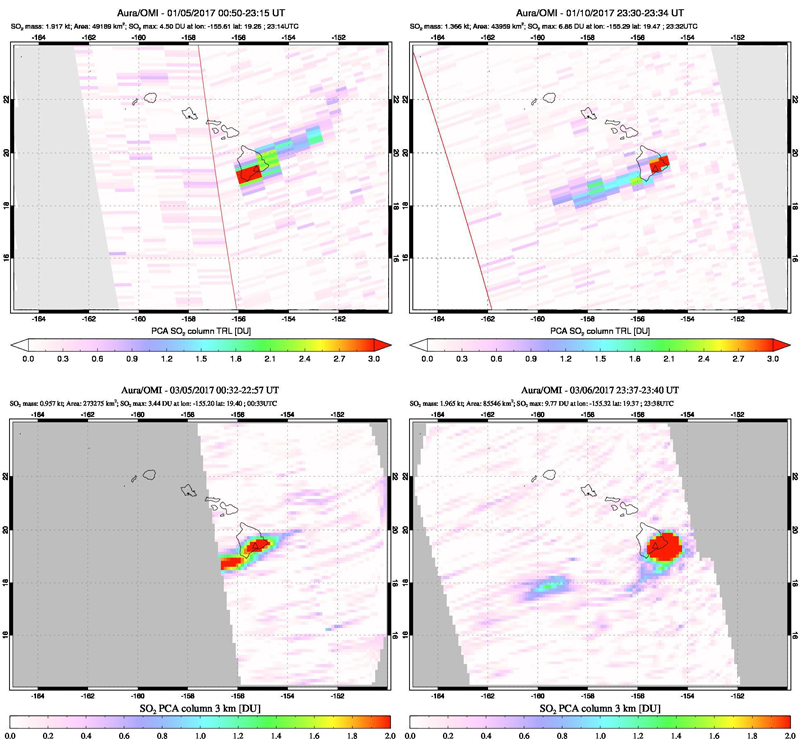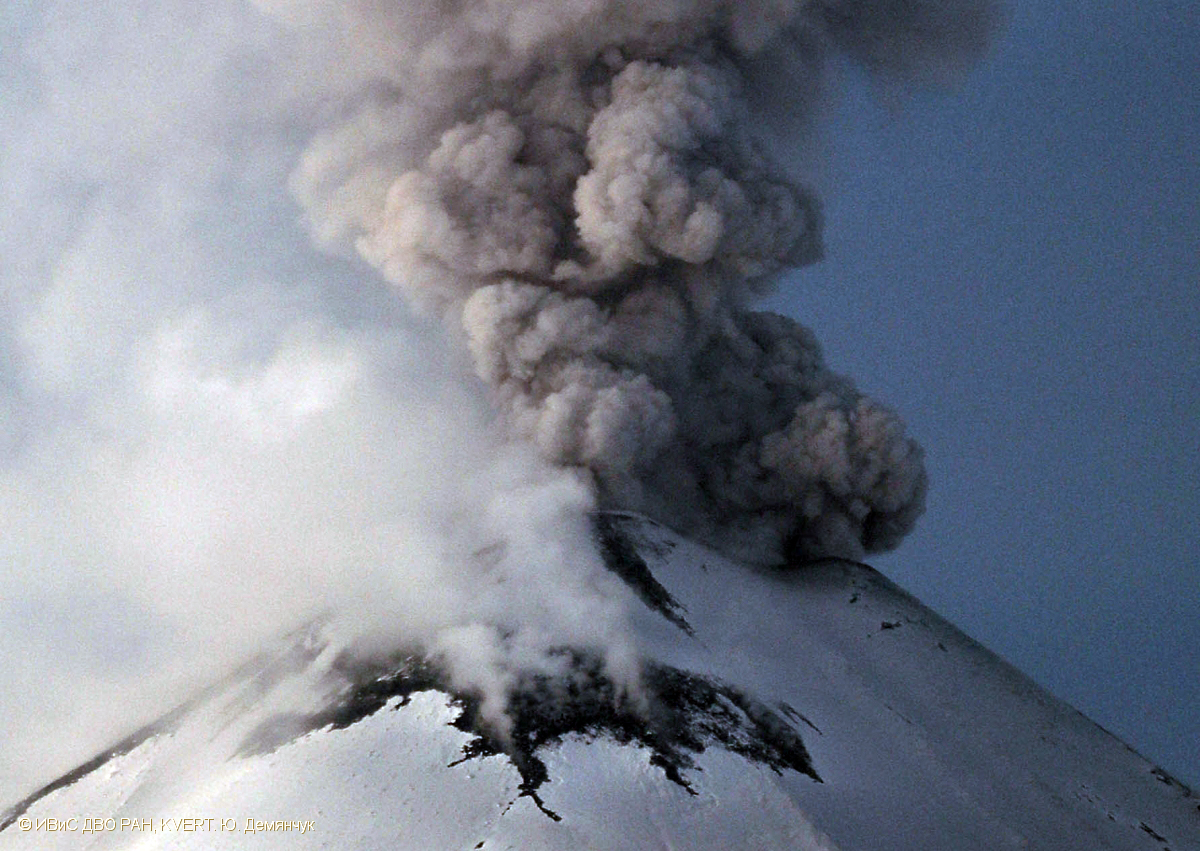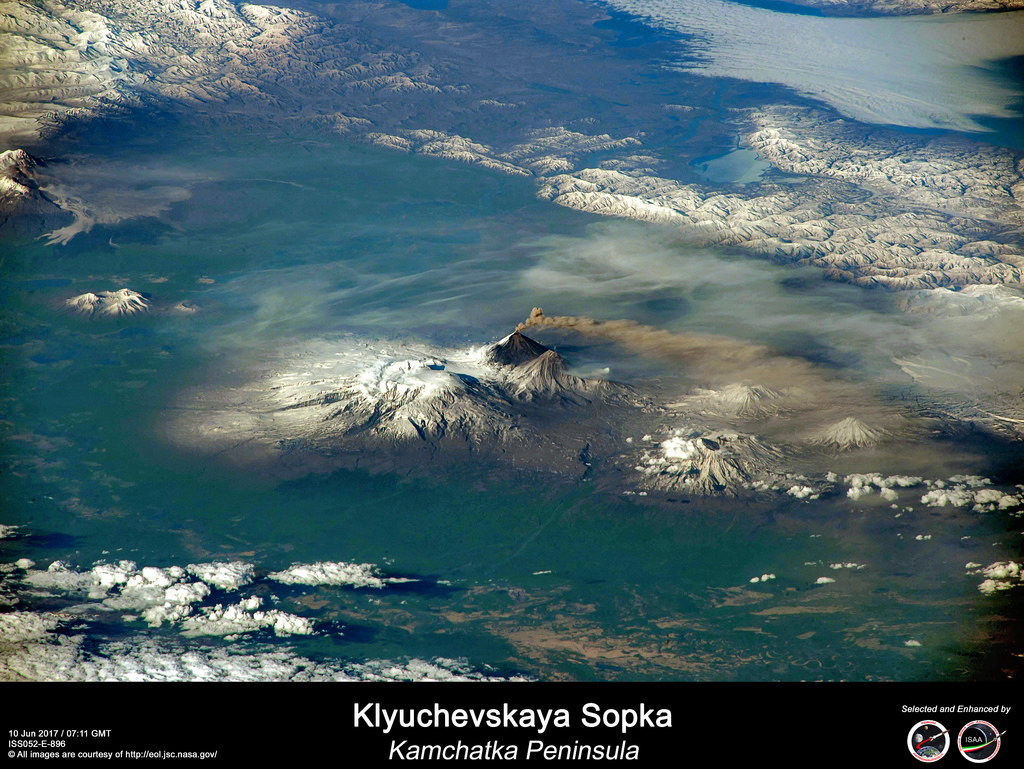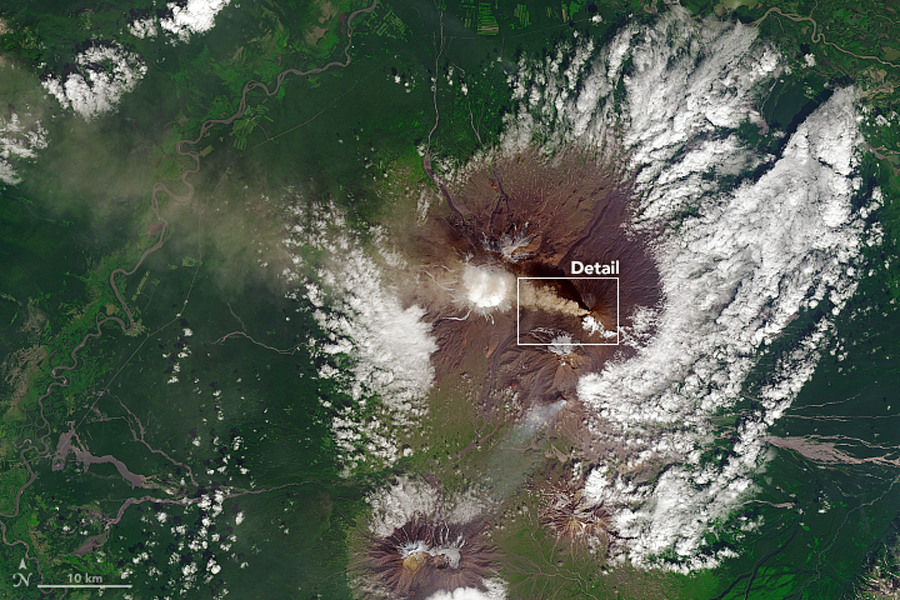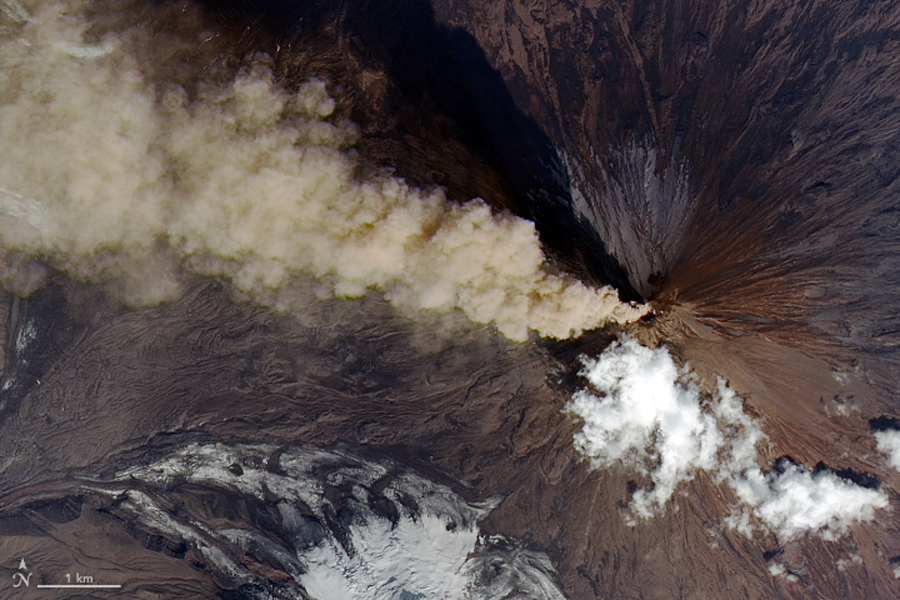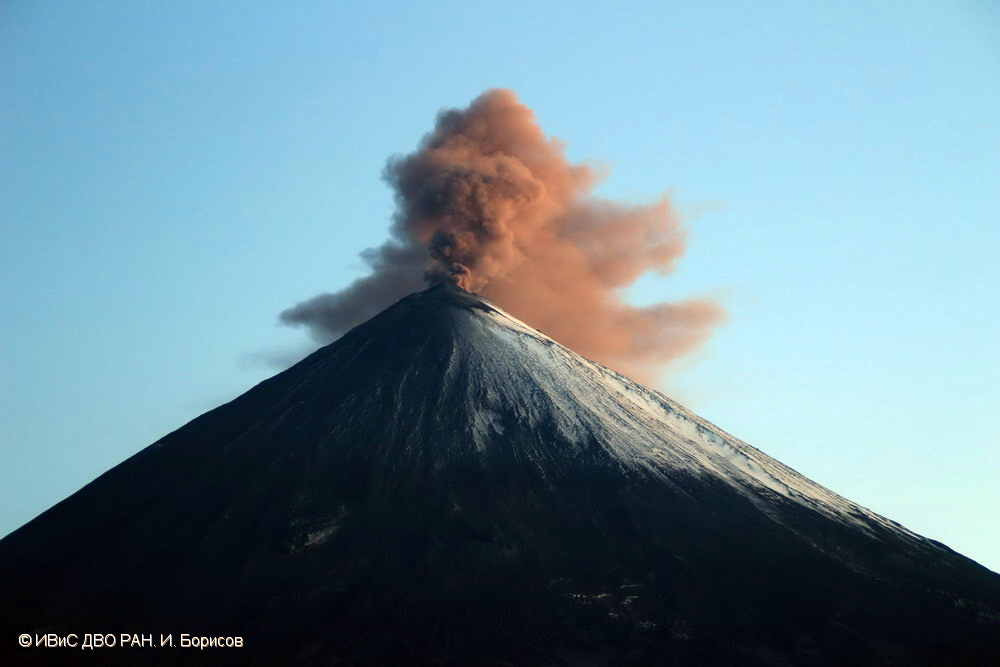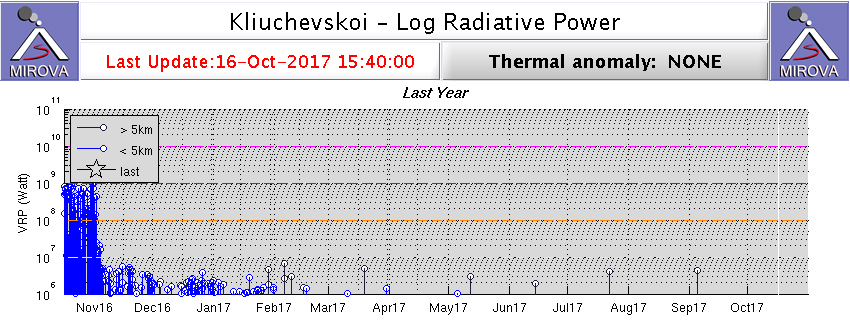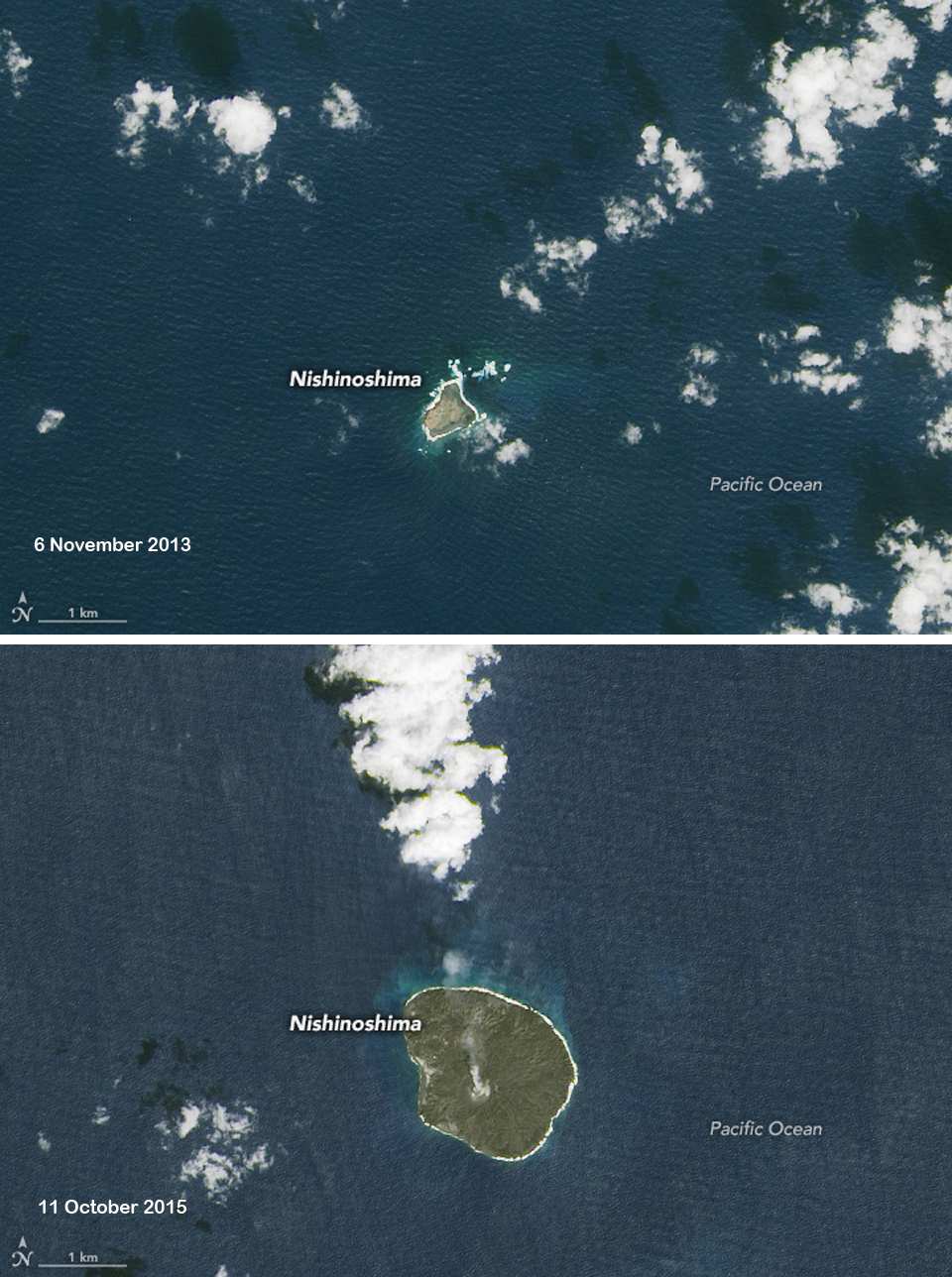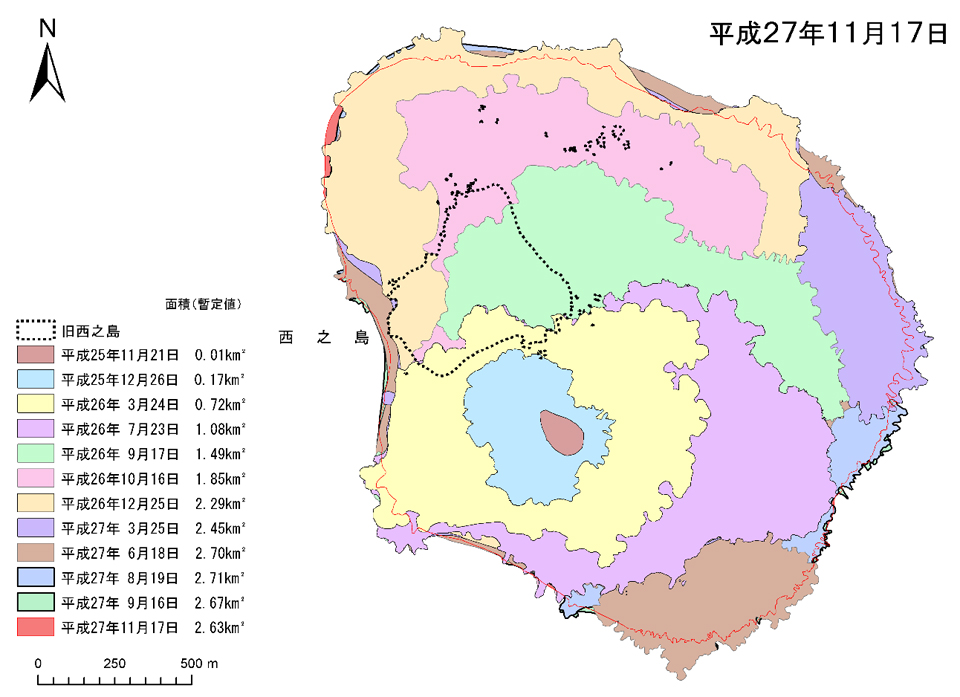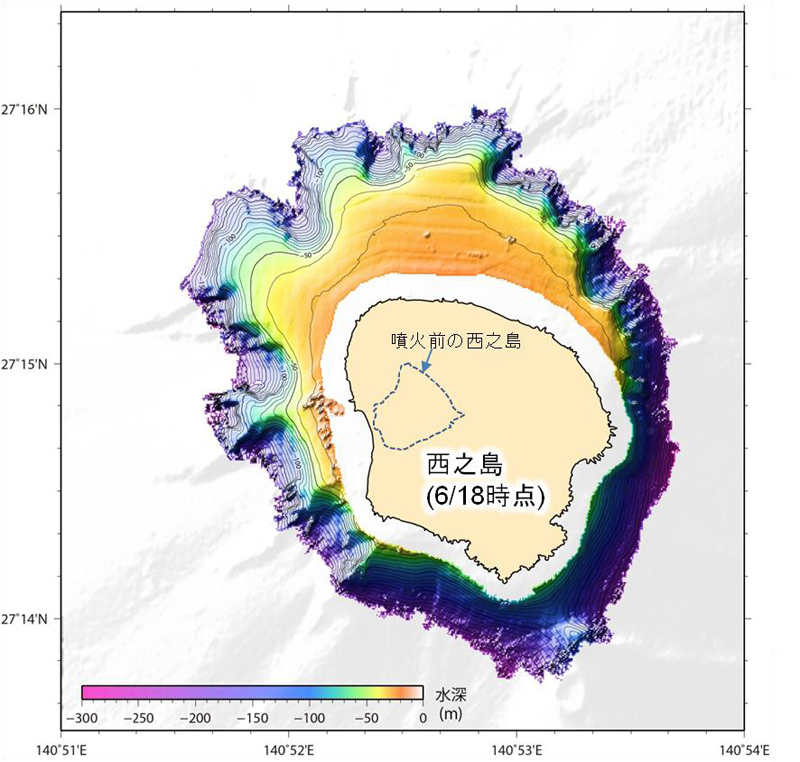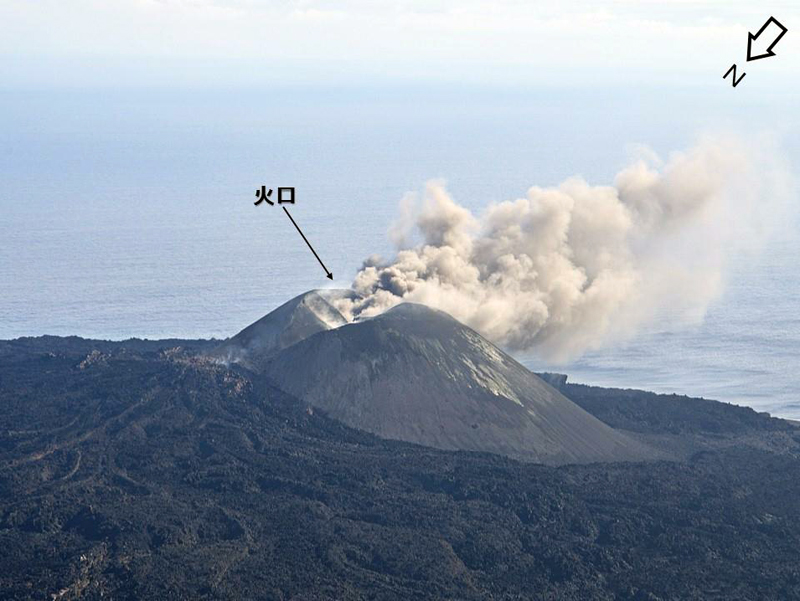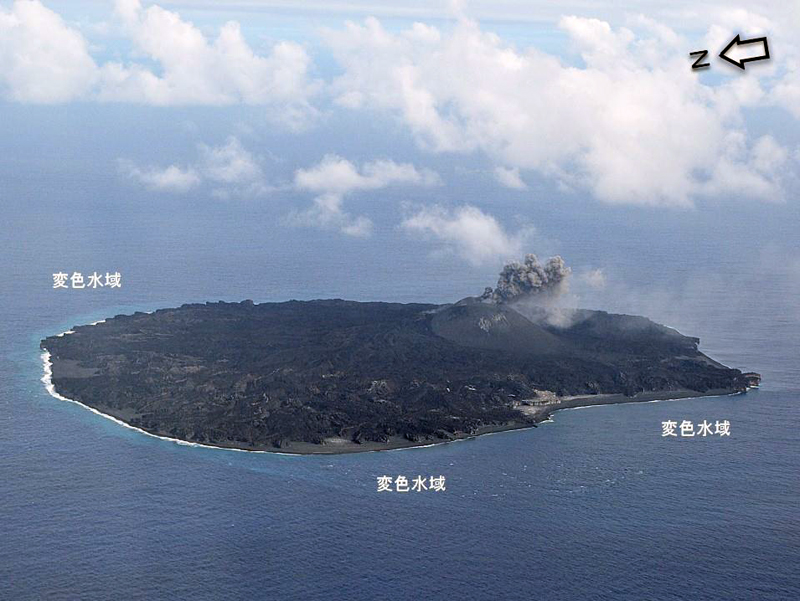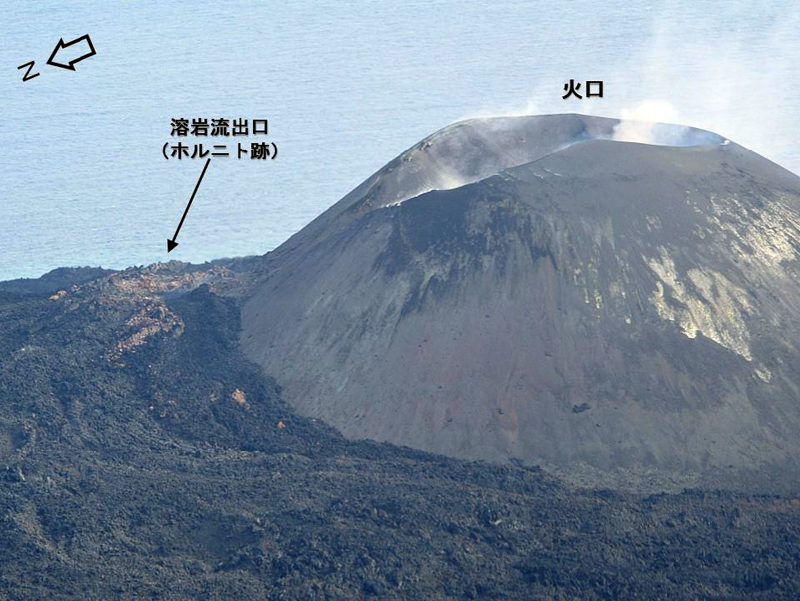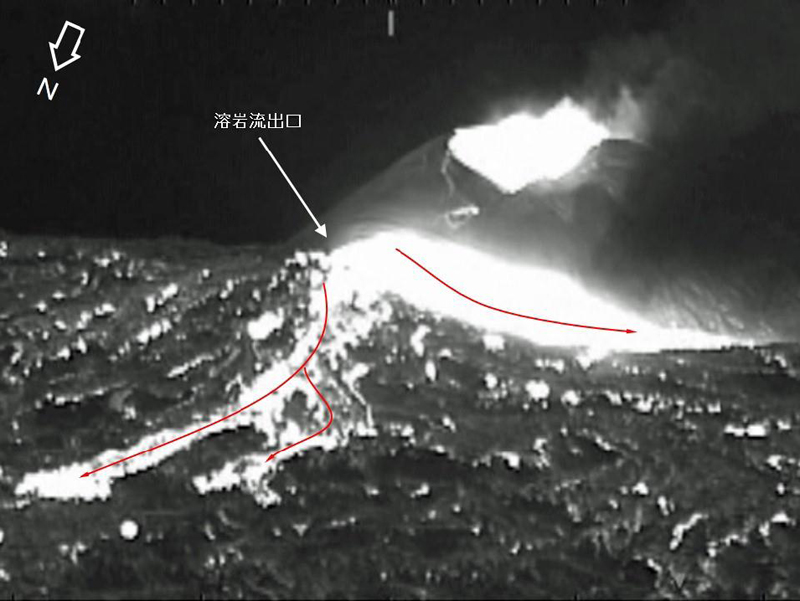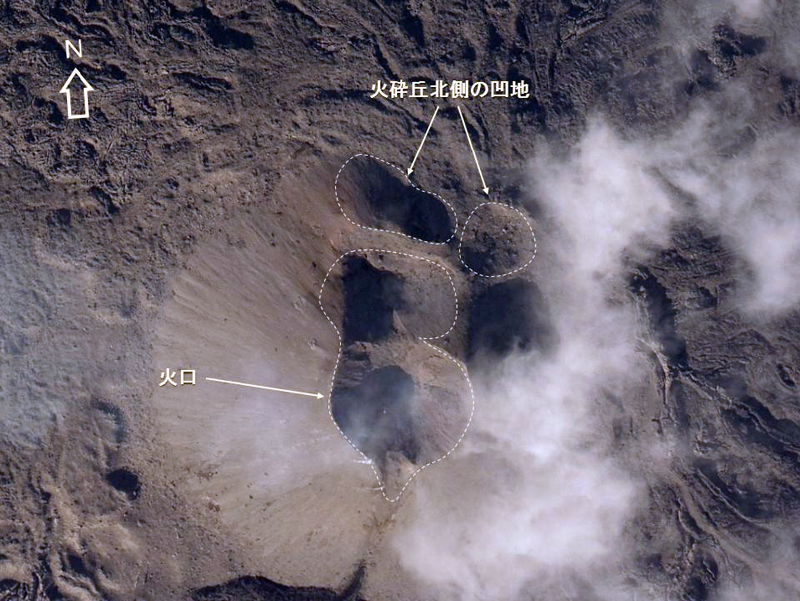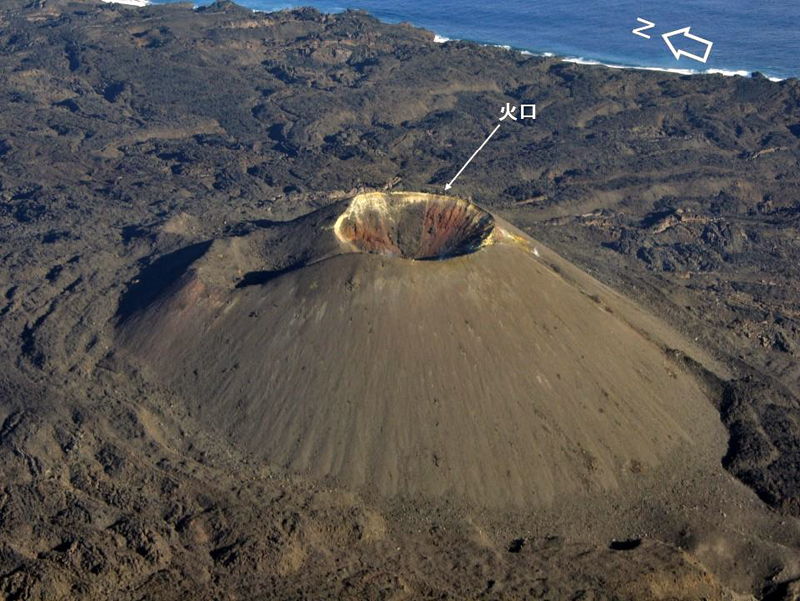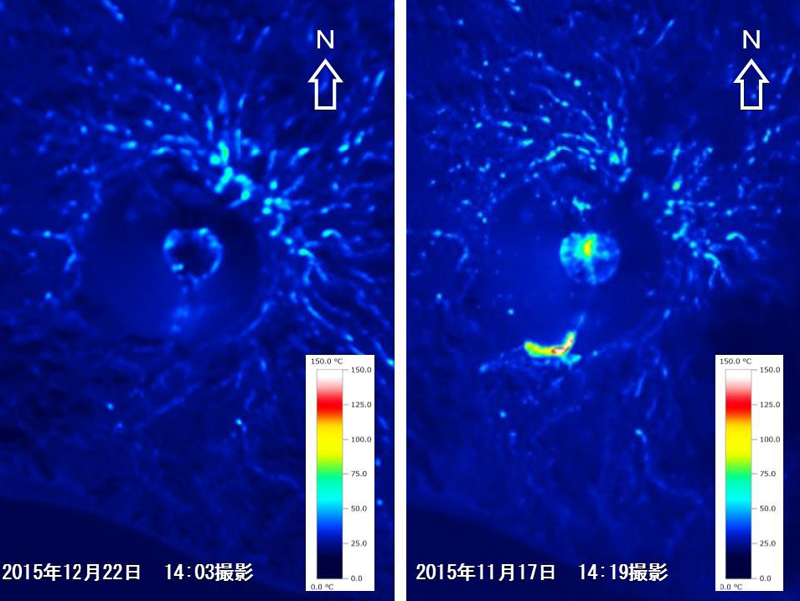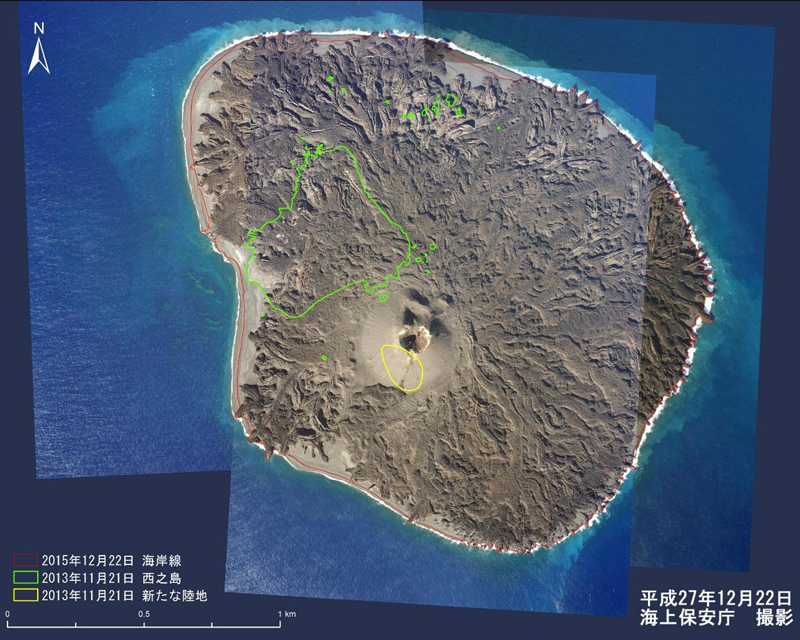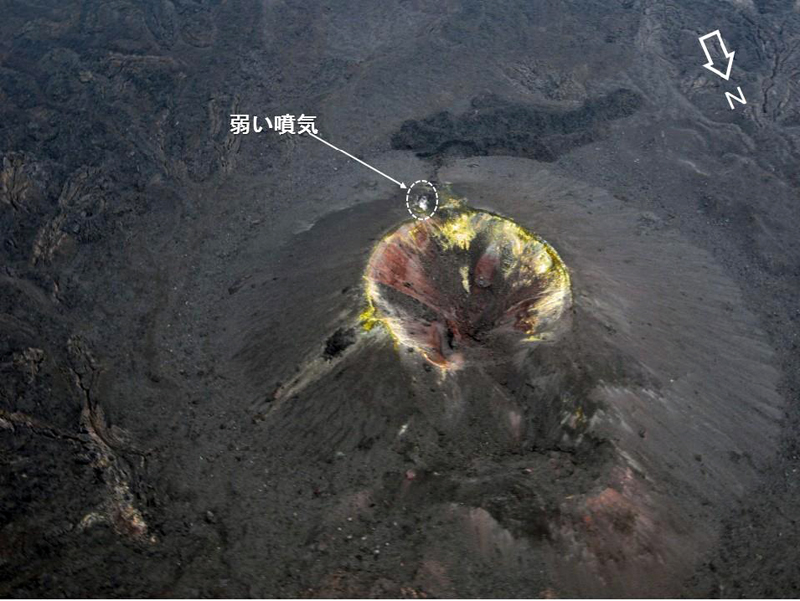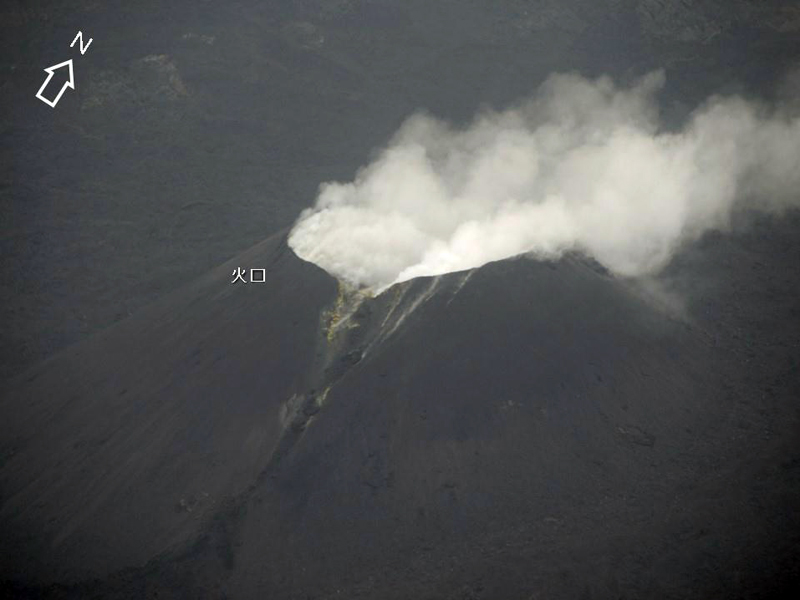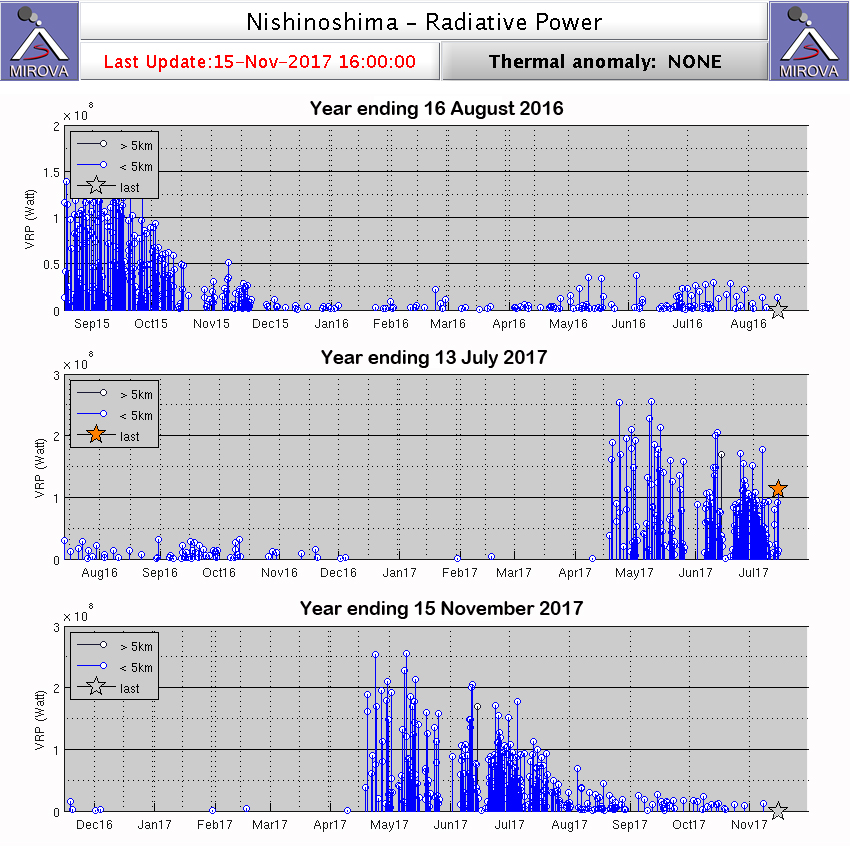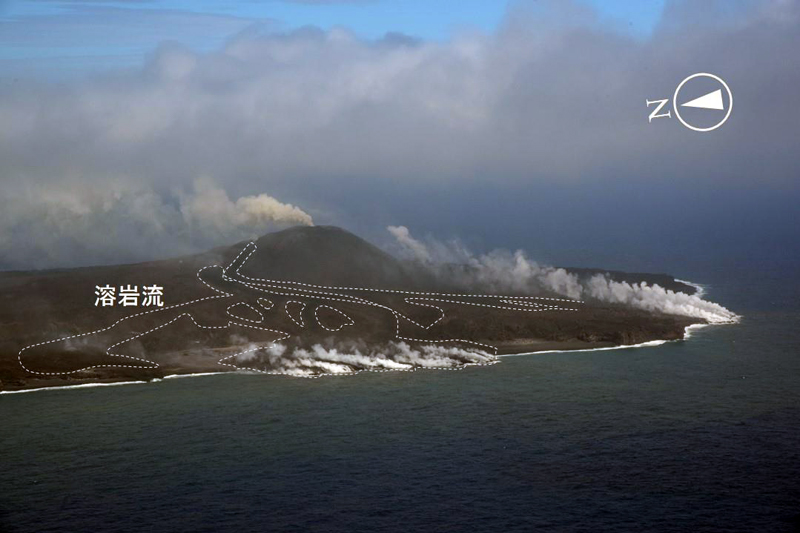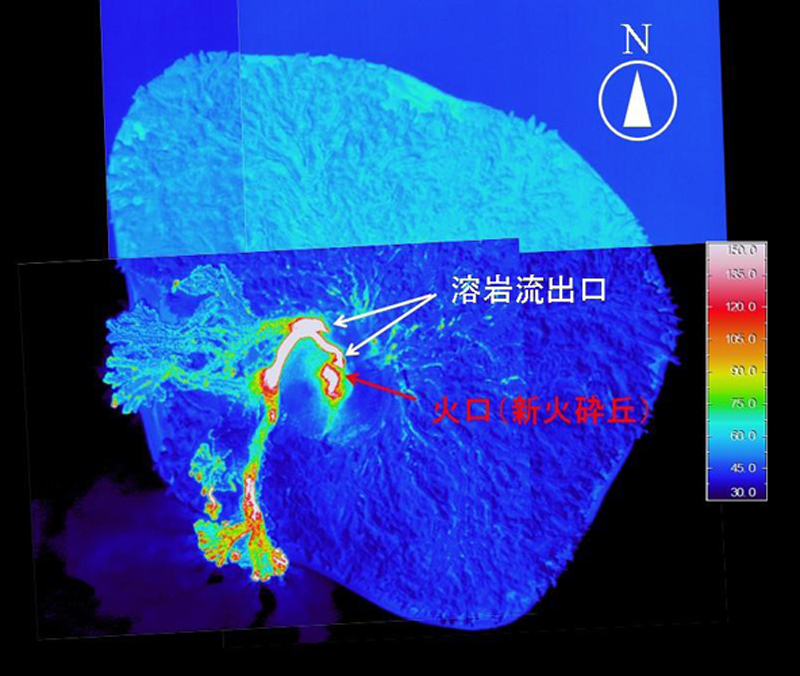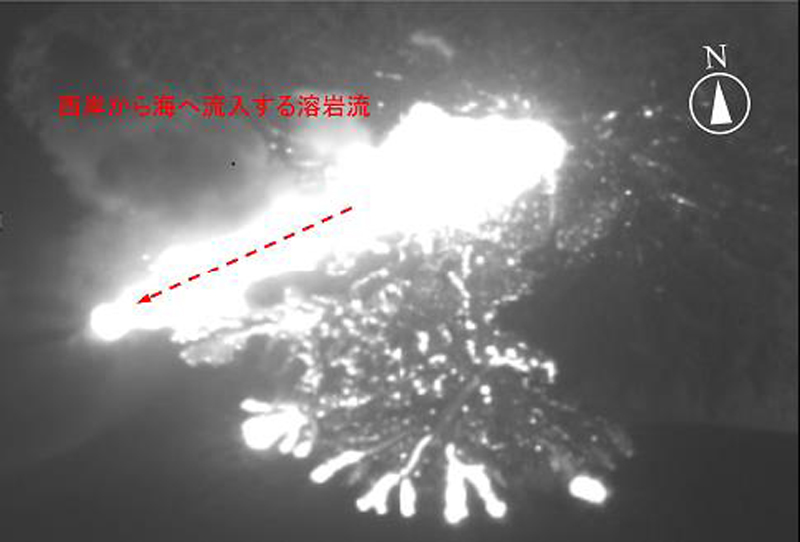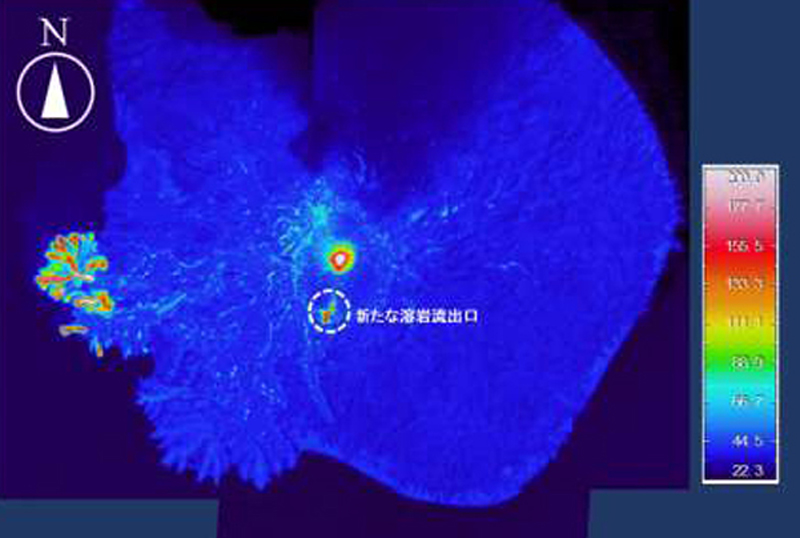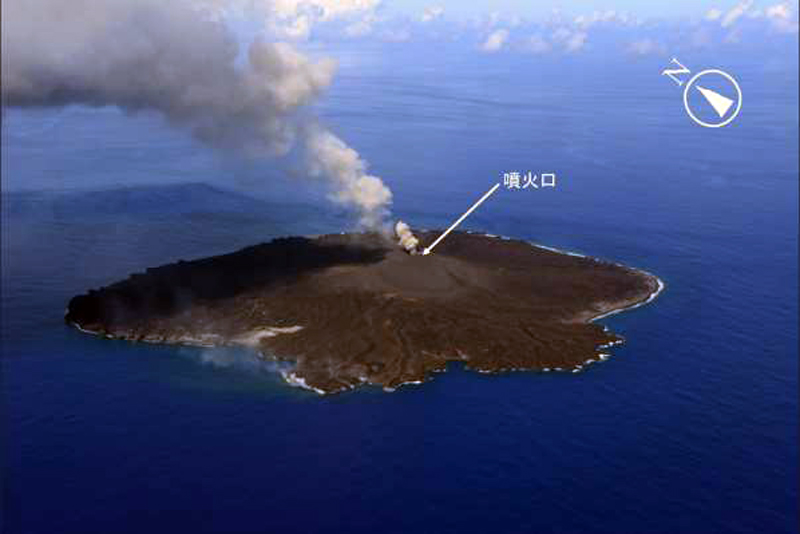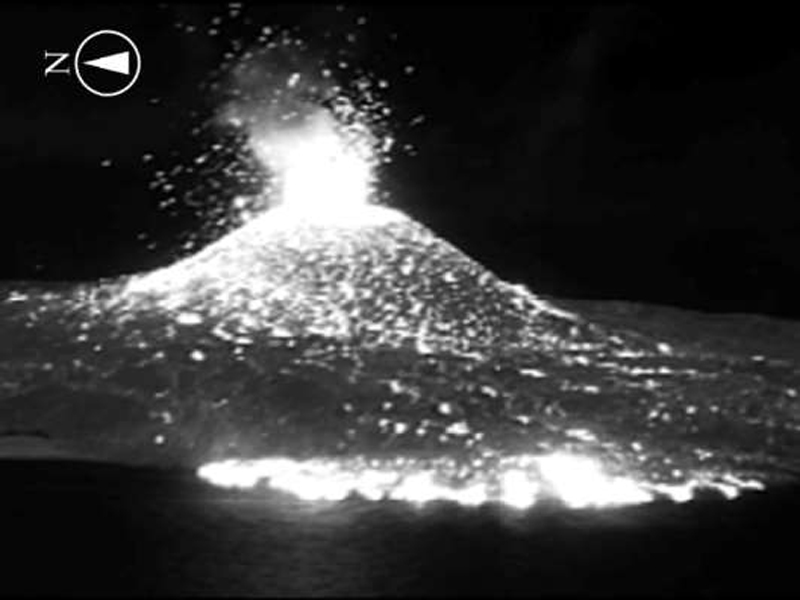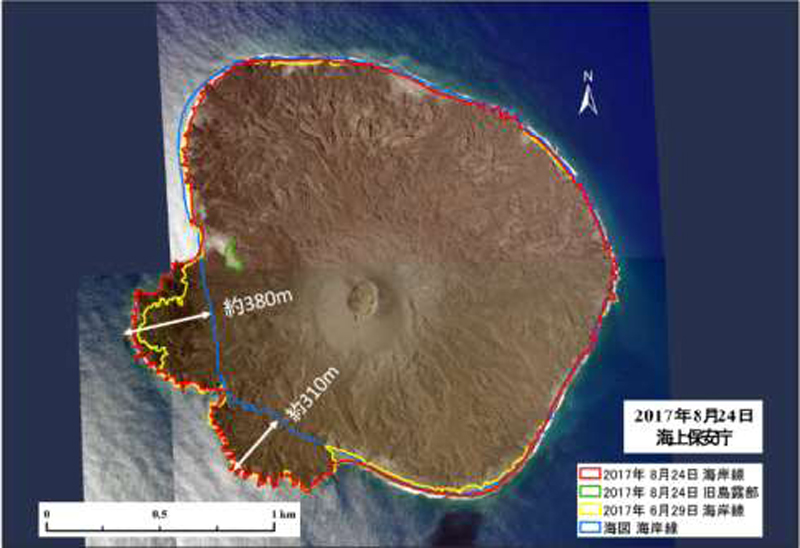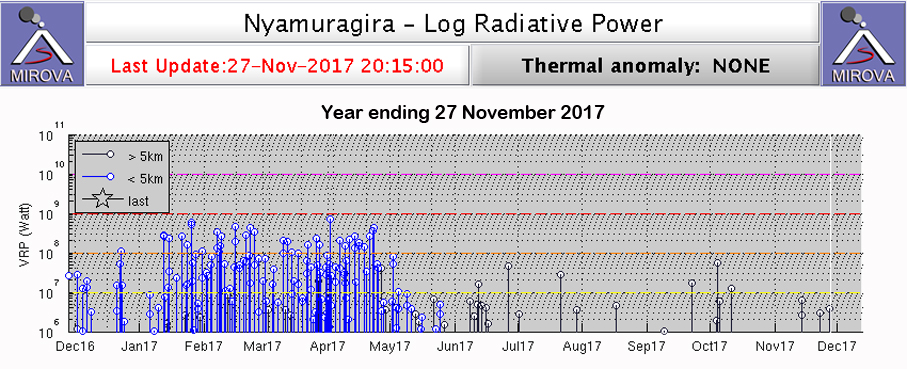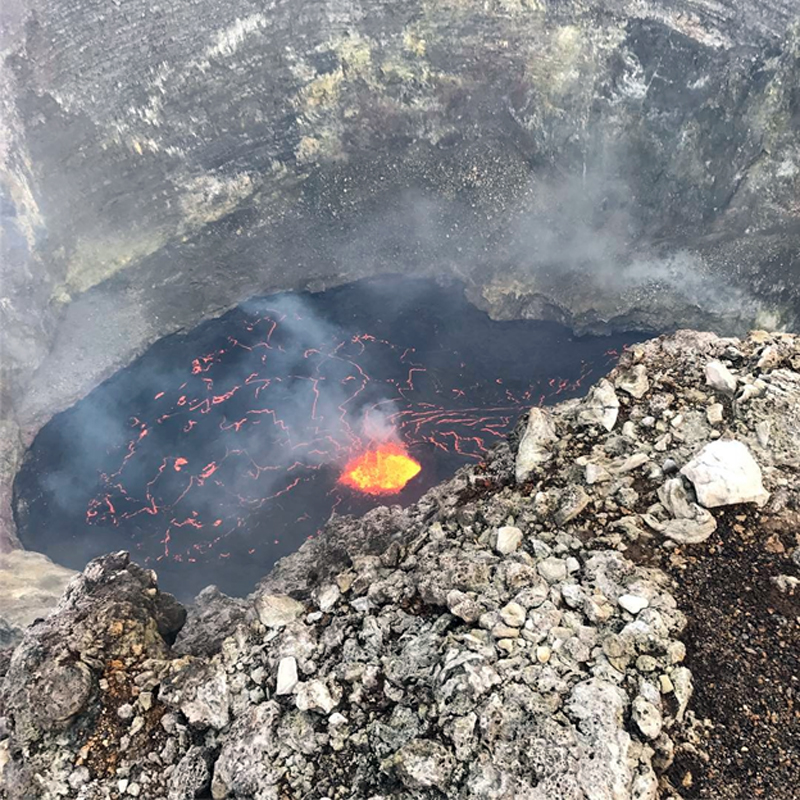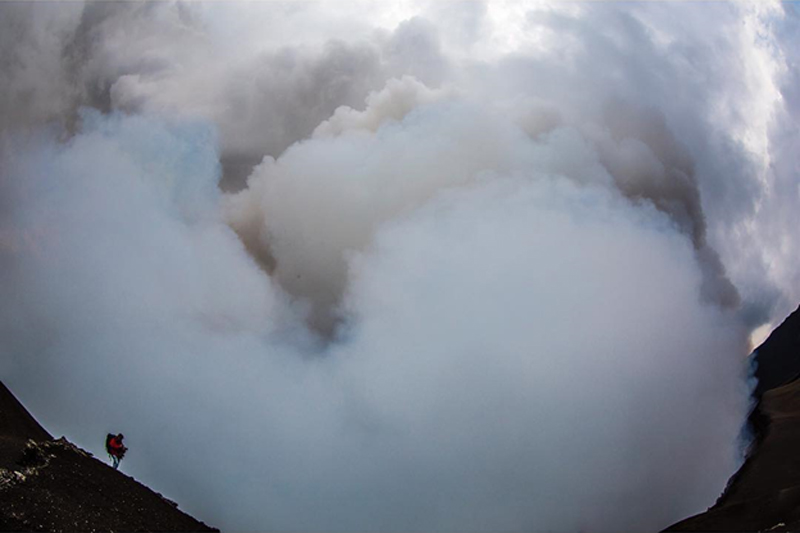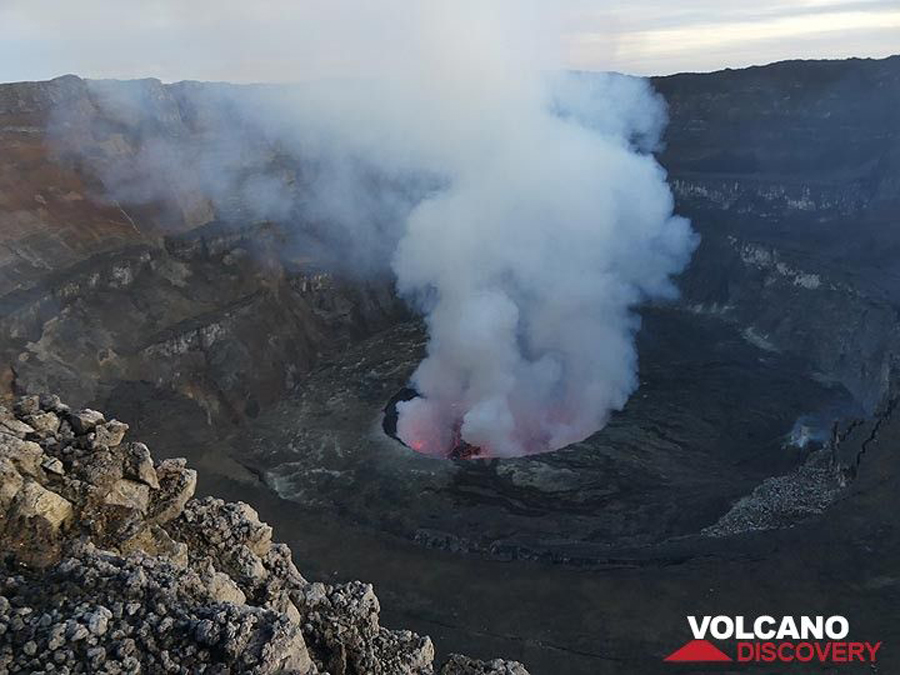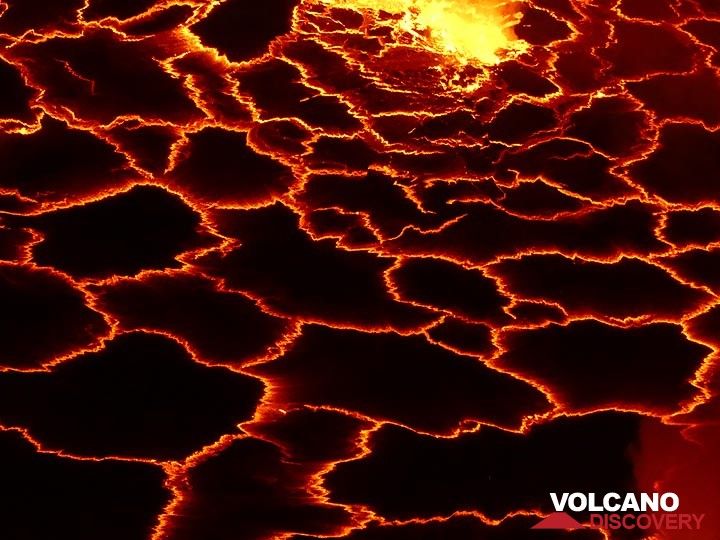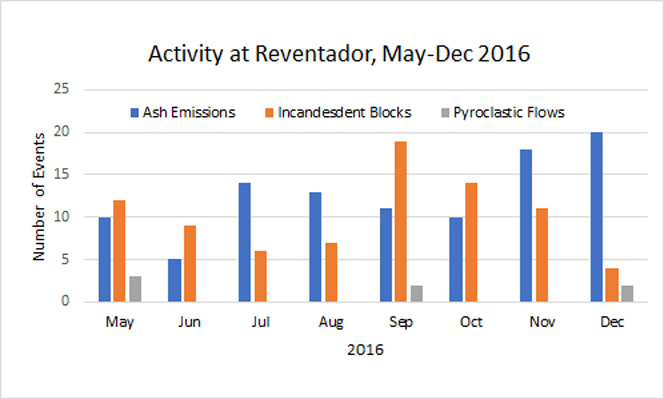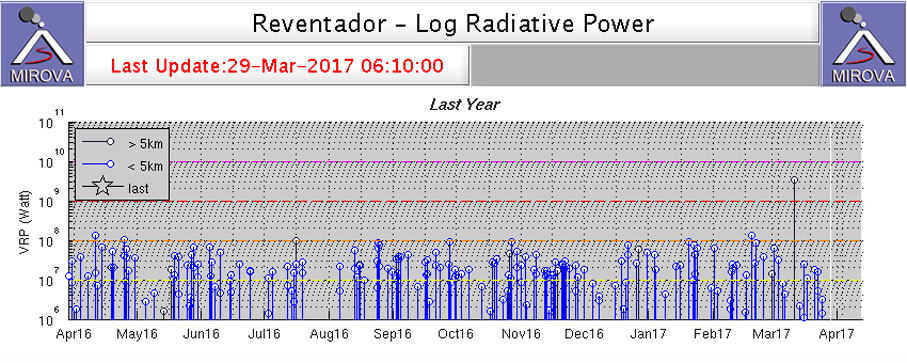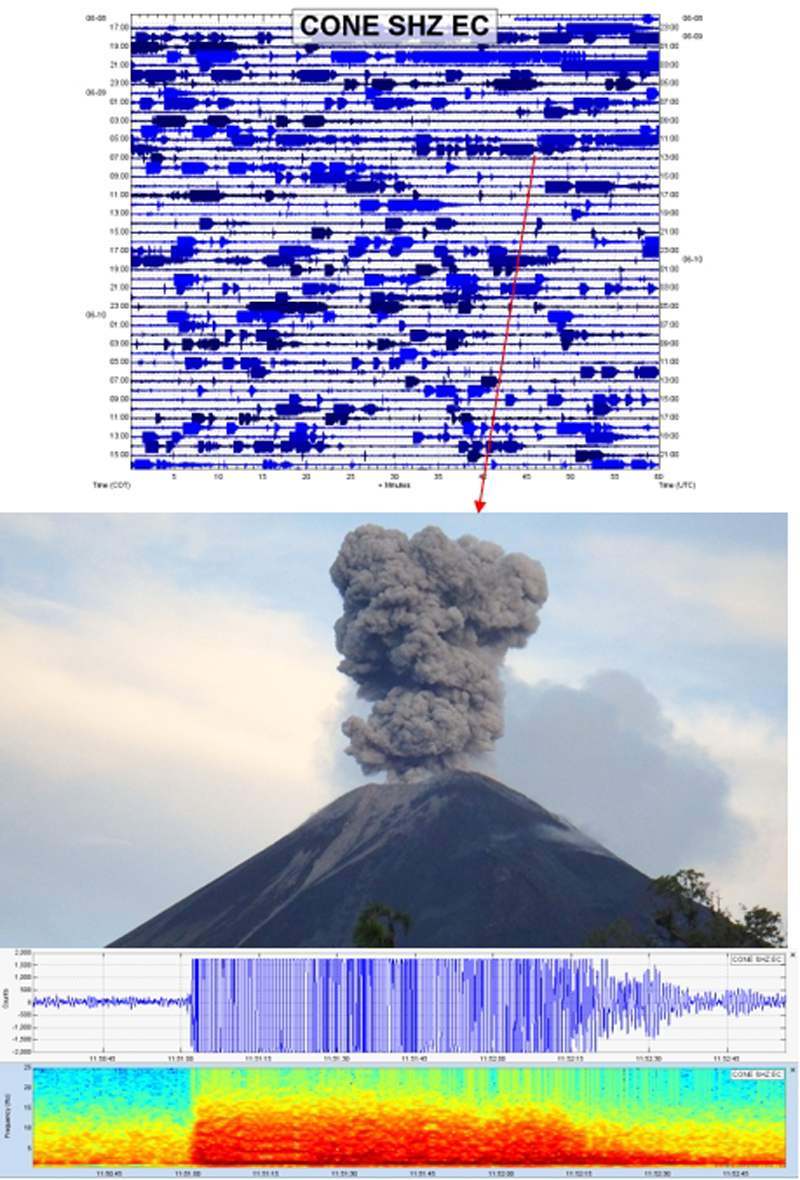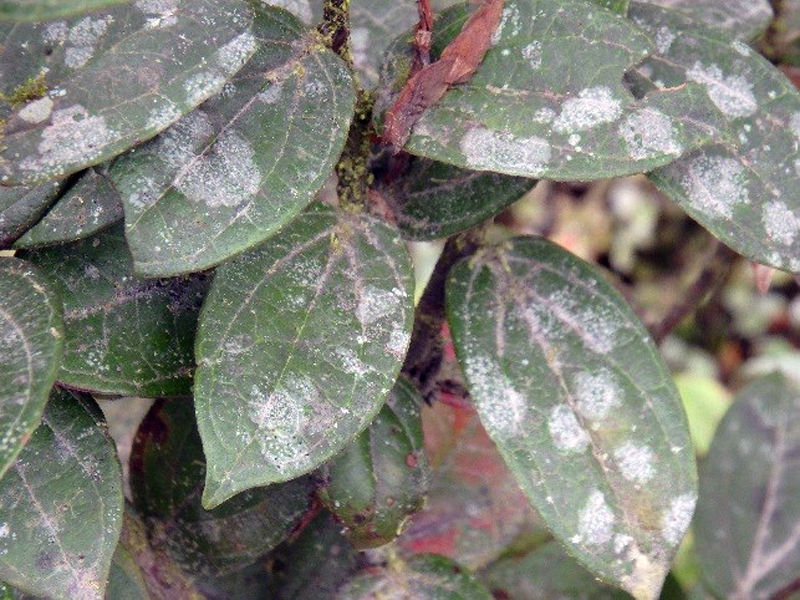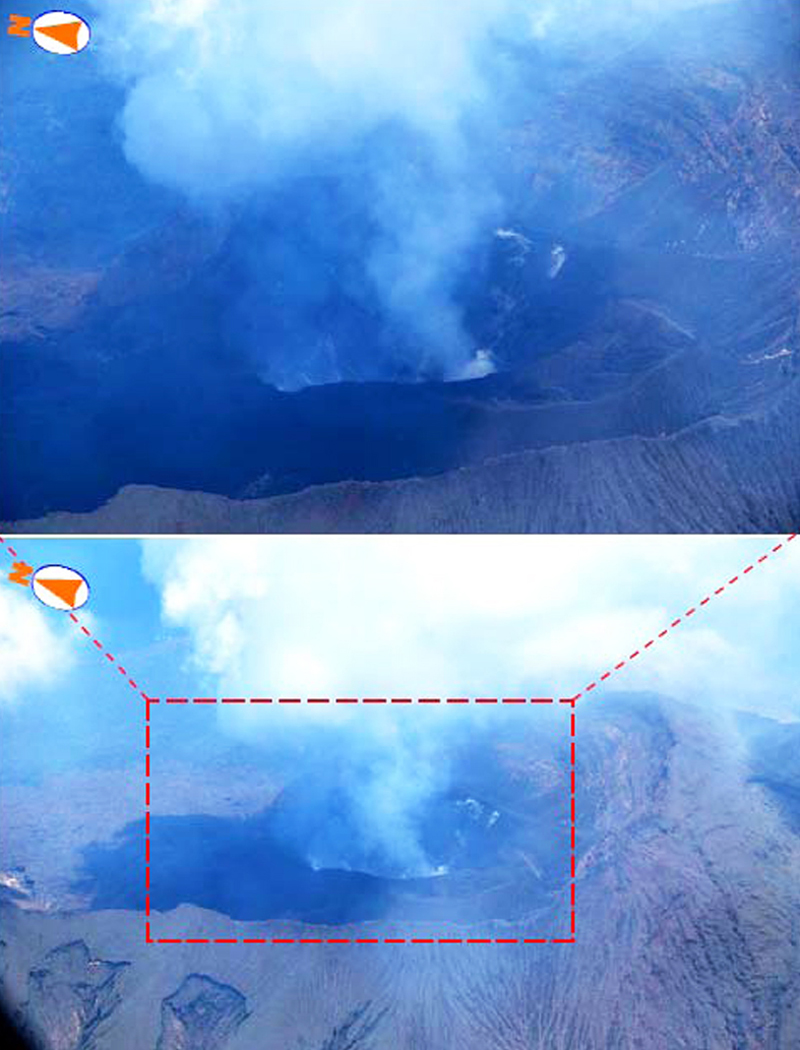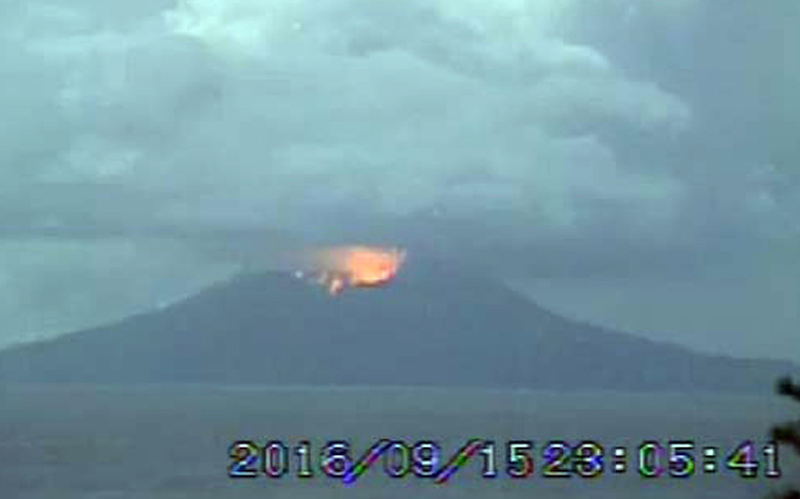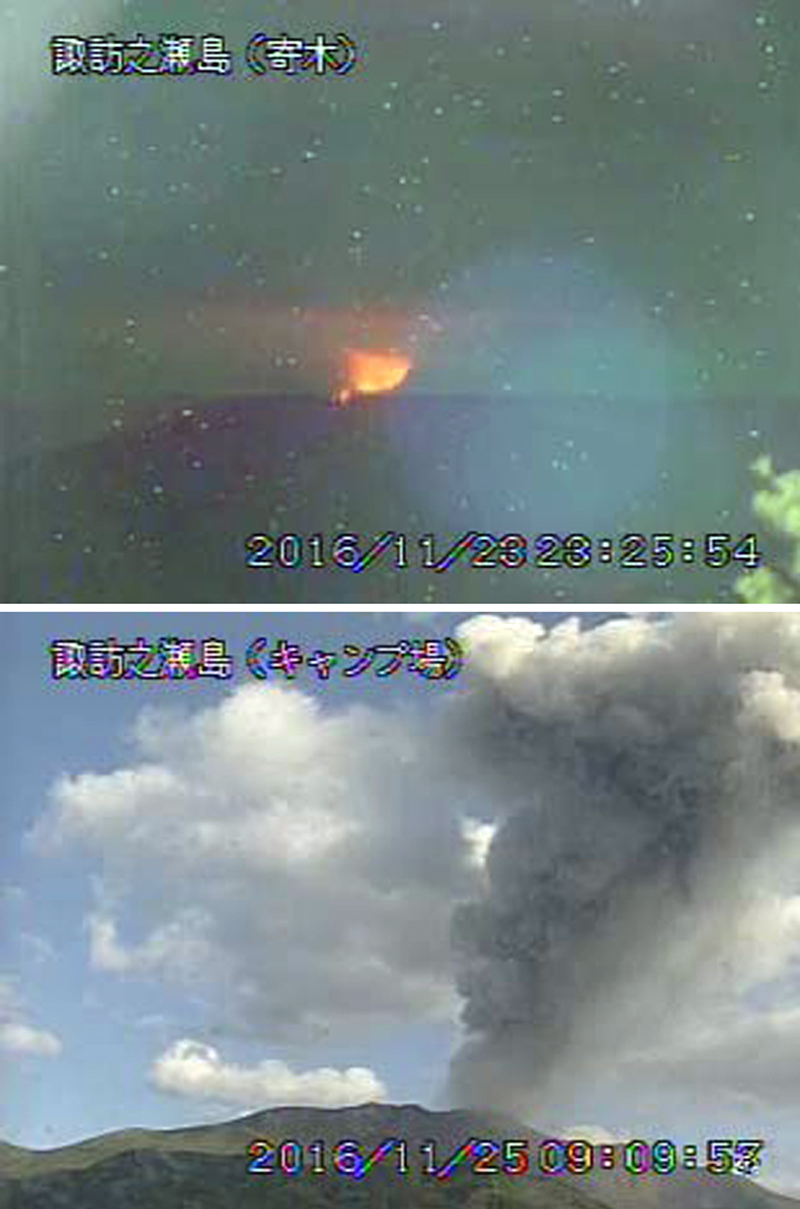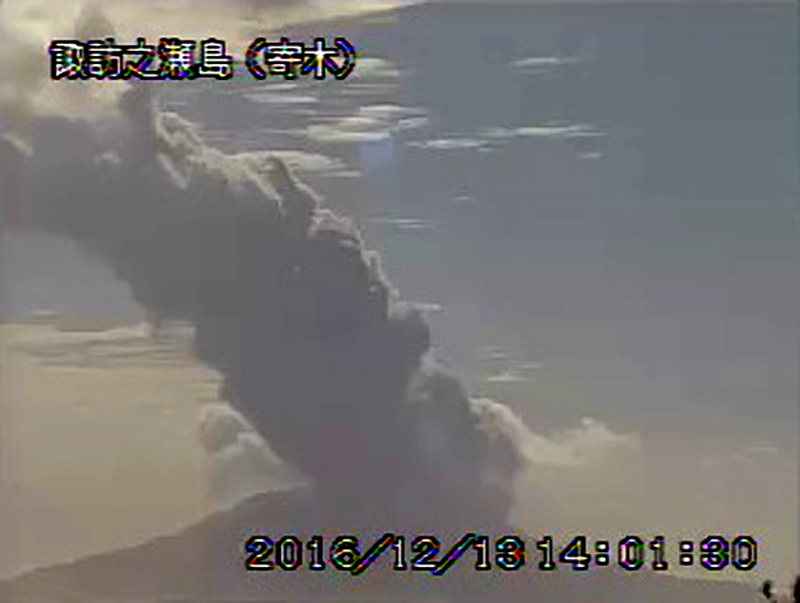Recently Published Bulletin Reports
Erebus (Antarctica) Lava lake remains active; most thermal alerts recorded since 2019
Rincon de la Vieja (Costa Rica) Frequent phreatic explosions during July-December 2023
Bezymianny (Russia) Explosion on 18 October 2023 sends ash plume 8 km high; lava flows and incandescent avalanches
Kilauea (United States) Low-level lava effusions in the lava lake at Halema’uma’u during July-December 2022
Nyamulagira (DR Congo) Lava flows and thermal activity during May-October 2023
Bagana (Papua New Guinea) Explosions, ash plumes, ashfall, and lava flows during April-September 2023
Mayon (Philippines) Lava flows, pyroclastic flows, ash emissions, and seismicity during April-September 2023
Nishinoshima (Japan) Eruption plumes and gas-and-steam plumes during May-August 2023
Krakatau (Indonesia) White gas-and-steam plumes and occasional ash plumes during May-August 2023
Villarrica (Chile) Strombolian activity, gas-and-ash emissions, and crater incandescence during April-September 2023
Merapi (Indonesia) Frequent incandescent avalanches during April-September 2023
Ebeko (Russia) Moderate explosive activity with ash plumes continued during June-November 2023
Erebus (Antarctica) — January 2024  Cite this Report
Cite this Report
Erebus
Antarctica
77.53°S, 167.17°E; summit elev. 3794 m
All times are local (unless otherwise noted)
Lava lake remains active; most thermal alerts recorded since 2019
The lava lake in the summit crater of Erebus has been active since at least 1972. Located in Antarctica overlooking the McMurdo Station on Ross Island, it is the southernmost active volcano on the planet. Because of the remote location, activity is primarily monitored by satellites. This report covers activity during 2023.
The number of thermal alerts recorded by the Hawai'i Institute of Geophysics and Planetology’s MODVOLC Thermal Alerts System increased considerably in 2023 compared to the years 2020-2022 (table 9). In contrast to previous years, the MODIS instruments aboard the Aqua and Terra satellites captured data from Erebus every month during 2023. Consistent with previous years, the lowest number of anomalous pixels were recorded in January, November, and December.
Table 9. Number of monthly MODIS-MODVOLC thermal alert pixels recorded at Erebus during 2017-2023. See BGVN 42:06 for data from 2000 through 2016. The table was compiled using data provided by the HIGP – MODVOLC Thermal Alerts System.
| Year |
Jan |
Feb |
Mar |
Apr |
May |
Jun |
Jul |
Aug |
Sep |
Oct |
Nov |
Dec |
SUM |
| 2017 |
0 |
21 |
9 |
0 |
0 |
1 |
11 |
61 |
76 |
52 |
0 |
3 |
234 |
| 2018 |
0 |
21 |
58 |
182 |
55 |
17 |
137 |
172 |
103 |
29 |
0 |
0 |
774 |
| 2019 |
2 |
21 |
162 |
151 |
55 |
56 |
75 |
53 |
29 |
19 |
1 |
0 |
624 |
| 2020 |
0 |
2 |
16 |
18 |
4 |
4 |
1 |
3 |
18 |
3 |
1 |
6 |
76 |
| 2021 |
0 |
9 |
1 |
0 |
2 |
56 |
46 |
47 |
35 |
52 |
5 |
3 |
256 |
| 2022 |
1 |
13 |
55 |
22 |
15 |
32 |
39 |
19 |
31 |
11 |
0 |
0 |
238 |
| 2023 |
2 |
33 |
49 |
82 |
41 |
32 |
70 |
64 |
42 |
17 |
5 |
11 |
448 |
Sentinel-2 infrared images showed one or two prominent heat sources within the summit crater, accompanied by adjacent smaller sources, similar to recent years (see BGVN 46:01, 47:02, and 48:01). A unique image was obtained on 25 November 2023 by the OLI-2 (Operational Land Imager-2) on Landsat 9, showing the upper part of the volcano surrounded by clouds (figure 32).
Geologic Background. Mount Erebus, the world's southernmost historically active volcano, overlooks the McMurdo research station on Ross Island. It is the largest of three major volcanoes forming the crudely triangular Ross Island. The summit of the dominantly phonolitic volcano has been modified by one or two generations of caldera formation. A summit plateau at about 3,200 m elevation marks the rim of the youngest caldera, which formed during the late-Pleistocene and within which the modern cone was constructed. An elliptical 500 x 600 m wide, 110-m-deep crater truncates the summit and contains an active lava lake within a 250-m-wide, 100-m-deep inner crater; other lava lakes are sometimes present. The glacier-covered volcano was erupting when first sighted by Captain James Ross in 1841. Continuous lava-lake activity with minor explosions, punctuated by occasional larger Strombolian explosions that eject bombs onto the crater rim, has been documented since 1972, but has probably been occurring for much of the volcano's recent history.
Information Contacts: Hawai'i Institute of Geophysics and Planetology (HIGP) - MODVOLC Thermal Alerts System, School of Ocean and Earth Science and Technology (SOEST), Univ. of Hawai'i, 2525 Correa Road, Honolulu, HI 96822, USA (URL: http://modis.higp.hawaii.edu/); Copernicus Browser, Copernicus Data Space Ecosystem, European Space Agency (URL: https://dataspace.copernicus.eu/browser/); NASA Earth Observatory, EOS Project Science Office, NASA Goddard Space Flight Center, Goddard, Maryland, USA (URL: https://earthobservatory.nasa.gov/images/152134/erebus-breaks-through).
Rincon de la Vieja (Costa Rica) — January 2024  Cite this Report
Cite this Report
Rincon de la Vieja
Costa Rica
10.83°N, 85.324°W; summit elev. 1916 m
All times are local (unless otherwise noted)
Frequent phreatic explosions during July-December 2023
Rincón de la Vieja is a volcanic complex in Costa Rica with a hot convecting acid lake that exhibits frequent weak phreatic explosions, gas-and-steam emissions, and occasional elevated sulfur dioxide levels (BGVN 45:10, 46:03, 46:11). The current eruption period began June 2021. This report covers activity during July-December 2023 and is based on weekly bulletins and occasional daily reports from the Observatorio Vulcanologico Sismologica de Costa Rica-Universidad Nacional (OVSICORI-UNA).
Numerous weak phreatic explosions continued during July-December 2023, along with gas-and-steam emissions and plumes that rose as high as 3 km above the crater rim. Many weekly OVSICORI-UNA bulletins included the previous week's number of explosions and emissions (table 9). For many explosions, the time of explosion was given (table 10). Frequent seismic activity (long-period earthquakes, volcano-tectonic earthquakes, and tremor) accompanied the phreatic activity.
Table 9. Number of reported weekly phreatic explosions and gas-and-steam emissions at Rincón de la Vieja, July-December 2023. Counts are reported for the week before the Weekly Bulletin date; not all reports included these data. Courtesy of OVSICORI-UNA.
| OVSICORI Weekly Bulletin |
Number of explosions |
Number of emissions |
| 28 Jul 2023 |
6 |
14 |
| 4 Aug 2023 |
10 |
12 |
| 1 Sep 2023 |
13 |
11 |
| 22 Sep 2023 |
12 |
13 |
| 29 Sep 2023 |
6 |
11 |
| 6 Oct 2023 |
12 |
5 |
| 13 Oct 2023 |
7 |
9 |
| 20 Oct 2023 |
1 |
15 |
| 27 Oct 2023 |
3 |
23 |
| 3 Nov 2023 |
3 |
10 |
| 17 Nov 2023 |
0 |
Some |
| 24 Nov 2023 |
0 |
14 |
| 8 Dec 2023 |
4 |
16 |
| 22 Dec 2023 |
8 |
18 |
Table 10. Summary of activity at Rincón de la Vieja during July-December 2023. Weak phreatic explosions and gas emissions are noted where the time of explosion was indicated in the weekly or daily bulletins. Height of plumes or emissions are distance above the crater rim. Courtesy of OVSICORI-UNA.
| Date |
Time |
Description of Activity |
| 1 Jul 2023 |
0156 |
Explosion. |
| 2 Jul 2023 |
0305 |
Explosion. |
| 4 Jul 2023 |
0229, 0635 |
Event at 0635 produced a gas-and-steam plume that rose 700 m and drifted W; seen by residents in Liberia (21 km SW). |
| 9 Jul 2023 |
1843 |
Explosion. |
| 21 Jul 2023 |
0705 |
Explosion. |
| 26 Jul 2023 |
1807 |
Explosion. |
| 28 Jul 2023 |
0802 |
Explosion generated a gas-and-steam plume that rose 500 m. |
| 30 Jul 2023 |
1250 |
Explosion. |
| 31 Jul 2023 |
2136 |
Explosion. |
| 11 Aug 2023 |
0828 |
Explosion. |
| 18 Aug 2023 |
1304 |
Explosion. |
| 21 Aug 2023 |
1224 |
Explosion generated gas-and-steam plumes rose 500-600 m. |
| 22 Aug 2023 |
0749 |
Explosion generated gas-and-steam plumes rose 500-600 m. |
| 24 Aug 2023 |
1900 |
Explosion. |
| 25 Aug 2023 |
0828 |
Event produced a steam-and-gas plume that rose 3 km and drifted NW. |
| 27-28 Aug 2023 |
0813 |
Four small events; the event at 0813 on 28 August lasted two minutes and generated a steam-and-gas plume that rose 2.5 km. |
| 1 Sep 2023 |
1526 |
Explosion generated plume that rose 2 km and ejected material onto the flanks. |
| 2-3 Sep 2023 |
- |
Small explosions detected in infrasound data. |
| 4 Sep 2023 |
1251 |
Gas-and-steam plume rose 1 km and drifted W. |
| 7 Nov 2023 |
1113 |
Explosion. |
| 8 Nov 2023 |
0722 |
Explosion. |
| 12 Nov 2023 |
0136 |
Small gas emissions. |
| 14 Nov 2023 |
0415 |
Small gas emissions. |
According to OVSICORI-UNA, during July-October the average weekly sulfur dioxide (SO2) flux ranged from 68 to 240 tonnes/day. However, in mid-November the flux increased to as high as 334 tonnes/day, the highest value measured in recent years. The high SO2 flux in mid-November was also detected by the TROPOMI instrument on the Sentinel-5P satellite (figure 43).
Geologic Background. Rincón de la Vieja, the largest volcano in NW Costa Rica, is a remote volcanic complex in the Guanacaste Range. The volcano consists of an elongated, arcuate NW-SE-trending ridge constructed within the 15-km-wide early Pleistocene Guachipelín caldera, whose rim is exposed on the south side. Sometimes known as the "Colossus of Guanacaste," it has an estimated volume of 130 km3 and contains at least nine major eruptive centers. Activity has migrated to the SE, where the youngest-looking craters are located. The twin cone of Santa María volcano, the highest peak of the complex, is located at the eastern end of a smaller, 5-km-wide caldera and has a 500-m-wide crater. A Plinian eruption producing the 0.25 km3 Río Blanca tephra about 3,500 years ago was the last major magmatic eruption. All subsequent eruptions, including numerous historical eruptions possibly dating back to the 16th century, have been from the prominent active crater containing a 500-m-wide acid lake located ENE of Von Seebach crater.
Information Contacts: Observatorio Vulcanológico Sismológica de Costa Rica-Universidad Nacional (OVSICORI-UNA), Apartado 86-3000, Heredia, Costa Rica (URL: http://www.ovsicori.una.ac.cr/); NASA Global Sulfur Dioxide Monitoring Page, Atmospheric Chemistry and Dynamics Laboratory, NASA Goddard Space Flight Center (NASA/GSFC), 8800 Greenbelt Road, Goddard MD 20771, USA (URL: https://so2.gsfc.nasa.gov/).
Bezymianny (Russia) — November 2023  Cite this Report
Cite this Report
Bezymianny
Russia
55.972°N, 160.595°E; summit elev. 2882 m
All times are local (unless otherwise noted)
Explosion on 18 October 2023 sends ash plume 8 km high; lava flows and incandescent avalanches
Bezymianny, located on Russia’s Kamchatka Peninsula, has had eruptions since 1955 characterized by dome growth, explosions, pyroclastic flows, ash plumes, and ashfall. Activity during November 2022-April 2023 included gas-and-steam emissions, lava dome collapses generating avalanches, and persistent thermal activity. Similar eruptive activity continued from May through October 2023, described here based on information from weekly and daily reports of the Kamchatka Volcano Eruptions Response Team (KVERT), notices from Tokyo VAAC (Volcanic Ash Advisory Center), and from satellite data.
Overall activity decreased after the strong period of activity in late March through April 2023, which included ash explosions during 29 March and 7-8 April 2023 that sent plumes as high as 10-12 km altitude, along with dome growth and lava flows (BGVN 48:05). This reduced activity can be seen in the MIROVA thermal detection system graph (figure 56), which was consistent with data from the MODVOLC thermal detection system and with Sentinel-2 satellite images that showed persistent hotspots in the summit crater when conditions allowed observations. A renewed period of strong activity began in mid-October 2023.
Activity increased significantly on 17 October 2023 when large collapses began during 0700-0830 on the E flanks of the lava dome and continued to after 0930 the next day (figure 57). Ash plumes rose to an altitude of 4.5-5 km, extending 220 km NNE by 18 October. A large explosion at 1630 on 18 October produced an ash plume that rose to an altitude of 11 km (8 km above the summit) and drifted NNE and then NW, extending 900 km NW within two days at an altitude of 8 km. Minor ashfall was noted in Kozyrevsk (45 km WNW). At 0820 on 20 October an ash plume was identified in satellite images drifting 100 km ENE at altitudes of 4-4.5 km.
Lava flows and hot avalanches from the dome down the SE flank continued over the next few days, including 23 October when clear conditions allowed good observations (figures 58 and 59). A large thermal anomaly was observed over the volcano through 24 October, and in the summit crater on 30 October (figure 60). Strong fumarolic activity continued, with numerous avalanches and occasional incandescence. By the last week of October, volcanic activity had decreased to a level consistent with that earlier in the reporting period.
Aviation warnings were frequently updated during 17-20 October. KVERT issued a Volcano Observatory Notice for Aviation (VONA) on 17 October at 1419 and 1727 (0219 and 0527 UTC) raising the Aviation Color Code (ACC) from Yellow to Orange (second highest level). The next day, KVERT issued a VONA at 1705 (0505 UTC) raising the ACC to Red (highest level) but lowered it back to Orange at 2117 (0917 UTC). After another decrease to Yellow and back to Orange, the ACC was reduced to Yellow on 20 October at 1204 (0004 UTC). In addition, the Tokyo VAAC issued a series of Volcanic Ash Advisories beginning on 16 October and continuing through 30 October.
Geologic Background. The modern Bezymianny, much smaller than its massive neighbors Kamen and Kliuchevskoi on the Kamchatka Peninsula, was formed about 4,700 years ago over a late-Pleistocene lava-dome complex and an edifice built about 11,000-7,000 years ago. Three periods of intensified activity have occurred during the past 3,000 years. The latest period, which was preceded by a 1,000-year quiescence, began with the dramatic 1955-56 eruption. This eruption, similar to that of St. Helens in 1980, produced a large open crater that was formed by collapse of the summit and an associated lateral blast. Subsequent episodic but ongoing lava-dome growth, accompanied by intermittent explosive activity and pyroclastic flows, has largely filled the 1956 crater.
Information Contacts: Kamchatka Volcanic Eruptions Response Team (KVERT), Far Eastern Branch, Russian Academy of Sciences, 9 Piip Blvd., Petropavlovsk-Kamchatsky, 683006, Russia (URL: http://www.kscnet.ru/ivs/kvert/); Kamchatka Volcanological Station, Kamchatka Branch of Geophysical Survey, (KB GS RAS), Klyuchi, Kamchatka Krai, Russia (URL: http://volkstat.ru/); Tokyo Volcanic Ash Advisory Center (VAAC), 1-3-4 Otemachi, Chiyoda-ku, Tokyo 100-8122, Japan (URL: http://ds.data.jma.go.jp/svd/vaac/data/); Hawai'i Institute of Geophysics and Planetology (HIGP) - MODVOLC Thermal Alerts System, School of Ocean and Earth Science and Technology (SOEST), Univ. of Hawai'i, 2525 Correa Road, Honolulu, HI 96822, USA (URL: http://modis.higp.hawaii.edu/); MIROVA (Middle InfraRed Observation of Volcanic Activity), a collaborative project between the Universities of Turin and Florence (Italy) supported by the Centre for Volcanic Risk of the Italian Civil Protection Department (URL: http://www.mirovaweb.it/); Copernicus Browser, Copernicus Data Space Ecosystem, European Space Agency (URL: https://dataspace.copernicus.eu/browser/).chr
Kilauea (United States) — January 2023  Cite this Report
Cite this Report
Kilauea
United States
19.421°N, 155.287°W; summit elev. 1222 m
All times are local (unless otherwise noted)
Low-level lava effusions in the lava lake at Halema’uma’u during July-December 2022
Kīlauea is the southeastern-most volcano in Hawaii and overlaps the E flank of the Mauna Loa volcano. Its East Rift Zone (ERZ) has been intermittently active for at least 2,000 years. An extended eruption period began in January 1983 and was characterized by open lava lakes and lava flows from the summit caldera and the East Rift Zone. During May 2018 magma migrated into the Lower East Rift Zone (LERZ) and opened 24 fissures along a 6-km-long NE-trending fracture zone that produced lava flows traveling in multiple directions. As lava emerged from the fissures, the lava lake at Halema'uma'u drained and explosions sent ash plumes to several kilometers altitude (BGVN 43:10).
The current eruption period started during September 2021 and has recently been characterized by lava effusions, spatter, and sulfur dioxide emissions in the active Halema’uma’u lava lake (BGVN 47:08). Lava effusions, some spatter, and sulfur dioxide emissions have continued during this reporting period of July through December 2022 using daily reports, volcanic activity notices, and abundant photo, map, and video data from the US Geological Survey's (USGS) Hawaiian Volcano Observatory (HVO).
Summary of activity during July-December 2022. Low-level effusions have continued at the western vent of the Halema’uma’u crater during July through early December 2022. Occasional weak ooze-outs (also called lava break outs) would occur along the margins of the crater floor. The overall level of the active lava lake throughout the reporting period gradually increased due to infilling, however it stagnated in mid-September (table 13). During September through November, activity began to decline, though lava effusions persisted at the western vent. By 9 December, the active part of the lava lake had completely crusted over, and incandescence was no longer visible.
Table 13. Summary of measurements taken during overflights at Kīlauea that show a gradual increase in the active lava lake level and the volume of lava effused since 29 September 2021. Lower activity was reported during September-October. Data collected during July-December 2022. Courtesy of HVO.
| Date: |
Level of the active lava lake (m): |
Cumulative volume of lava effused (million cubic meters): |
| 7 Jul 2022 |
130 |
95 |
| 19 Jul 2022 |
133 |
98 |
| 4 Aug 2022 |
136 |
102 |
| 16 Aug 2022 |
137 |
104 |
| 12 Sep 2022 |
143 |
111 |
| 5 Oct 2022 |
143 |
111 |
| 28 Oct 2022 |
143 |
111 |
Activity during July 2022. Lava effusions were reported from the western vent in the Halema’uma’u crater, along with occasional weak ooze-outs along the margins of the crater floor. The height of the lava lake was variable due to deflation-inflation tilt events; for example, the lake level dropped approximately 3-4 m during a summit deflation-inflation event reported on 1 July. Webcam images taken during the night of 6-12 July showed intermittent low-level spattering at the western vent that rose less than 10 m above the vent (figure 519). Measurements made during an overflight on 7 July indicated that the crater floor was infilled about 130 m and that 95 million cubic meters of lava had been effused since 29 September 2021. A single, relatively small lava ooze-out was active to the S of the lava lake. Around midnight on 8 July there were two brief periods of lava overflow onto the lake margins. On 9 July lava ooze-outs were reported near the SE and NE edges of the crater floor and during 10-11 July they occurred near the E, NE, and NW edges. On 16 July crater incandescence was reported, though the ooze-outs and spattering were not visible. On 18 July overnight webcam images showed incandescence in the western vent complex and two ooze-outs were reported around 0000 and 0200 on 19 July. By 0900 there were active ooze-outs along the SW edge of the crater floor. Measurements made from an overflight on 19 July indicated that the crater floor was infilled about 133 m and 98 million cubic meters of lava had erupted since 29 September 2021 (figure 520). On 20 July around 1600 active ooze-outs were visible along the N edge of the crater, which continued through the next day. Extensive ooze-outs occurred along the W margin during 24 July until 1900; on 26 July minor ooze-outs were noted along the N margin. Minor spattering was visible on 29 July along the E margin of the lake. The sulfur dioxide emission rates ranged 650-2,800 tons per day (t/d), the higher of which was measured on 8 July (figure 519).
Activity during August 2022. The eruption continued in the Halema’uma’u crater at the western vent. According to HVO the lava in the active lake remained at the level of the bounding levees. Occasional minor ooze-outs were observed along the margins of the crater floor. Strong nighttime crater incandescence was visible after midnight on 6 August over the western vent cone. During 6-7 August scattered small lava lobes were active along the crater floor and incandescence persisted above the western vent through 9 August. During 7-9 August HVO reported a single lava effusion source was active along the NW margin of the crater floor. Measurements from an overflight on 4 August indicated that the crater floor was infilled about 136 m total and that 102 million cubic meters of lava had been erupted since the start of the eruption. Lava breakouts were reported along the N, NE, E, S, and W margins of the crater during 10-16 August. Another overflight survey conducted on 16 August indicated that the crater floor infilled about 137 m and 104 million cubic meters of lava had been erupted since September 2021. Measured sulfur dioxide emissions rates ranged 1,150-2,450 t/d, the higher of which occurred on 8 August.
Activity during September 2022. During September, lava effusion continued from the western vent into the active lava lake and onto the crater floor. Intermittent minor ooze-outs were reported through the month. A small ooze-out was visible on the W crater floor margin at 0220 on 2 September, which showed decreasing surface activity throughout the day, but remained active through 3 September. On 3 September around 1900 a lava outbreak occurred along the NW margin of the crater floor but had stopped by the evening of 4 September. Field crews monitoring the summit lava lake on 9 September observed spattering on the NE margin of the lake that rose no higher than 10 m, before falling back onto the lava lake crust (figure 521). Overflight measurements on 12 September indicated that the crater floor was infilled a total of 143 m and 111 million cubic meters of lava had been erupted since September 2021. Extensive breakouts in the W and N part of the crater floor were reported at 1600 on 20 September and continued into 26 September. The active part of the lava lake dropped by 10 m while other parts of the crater floor dropped by several meters. Summit tiltmeters recorded a summit seismic swarm of more than 80 earthquakes during 1500-1800 on 21 September, which occurred about 1.5 km below Halema’uma’u; a majority of these were less than Mw 2. By 22 September the active part of the lava lake was infilled about 2 m. On 23 September the western vent areas exhibited several small spatter cones with incandescent openings, along with weak, sporadic spattering (figure 522). The sulfur dioxide emission rate ranged from 930 t/d to 2,000 t/d, the higher of which was measured on 6 September.
Activity during October 2022. Activity during October declined slightly compared to previous months, though lava effusions persisted from the western vent into the active lava lake and onto the crater floor during October (figure 523). Slight variations in the lava lake were noted throughout the month. HVO reported that around 0600 on 3 October the level of the lava lake has lowered slightly. Overflight measurements taken on 5 October indicated that the crater floor was infilled a total of about 143 m and that 111 million cubic meters of lava had been effused since September 2021. During 6-7 October the lake gradually rose 0.5 m. Sulfur dioxide measurements made on 22 October had an emission rate of 700 t/d. Another overflight taken on 28 October showed that there was little to no change in the elevation of the crater floor: the crater floor was infilled a total of 143 m and 111 million cubic meters of lava had erupted since the start of the eruption.
Activity during November 2022. Activity remained low during November, though HVO reported that lava from the western vent continued to effuse into the active lava lake and onto the crater floor throughout the month. The rate of sulfur dioxide emissions during November ranged from 300-600 t/d, the higher amount of which occurred on 9 November.
Activity during December 2022. Similar low activity was reported during December, with lava effusing from the western vent into the active lava lake and onto the crater floor. During 4-5 December the active part of the lava lake was slightly variable in elevation and fluctuated within 1 m. On 9 December HVO reported that lava was no longer erupting from the western vent in the Halema’uma’u crater and that sulfur dioxide emissions had returned to near pre-eruption background levels; during 10-11 December, the lava lake had completely crusted over, and no incandescence was visible (figure 524). Time lapse camera images covering the 4-10 December showed that the crater floor showed weak deflation and no inflation. Some passive events of crustal overturning were reported during 14-15 December, which brought fresh incandescent lava to the lake surface. The sulfur dioxide emission rate was approximately 200 t/d on 14 December. A smaller overturn event on 17 December and another that occurred around 0000 and into the morning of 20 December were also detected. A small seismic swarm was later detected on 30 December.
Geologic Background. Kilauea overlaps the E flank of the massive Mauna Loa shield volcano in the island of Hawaii. Eruptions are prominent in Polynesian legends; written documentation since 1820 records frequent summit and flank lava flow eruptions interspersed with periods of long-term lava lake activity at Halemaumau crater in the summit caldera until 1924. The 3 x 5 km caldera was formed in several stages about 1,500 years ago and during the 18th century; eruptions have also originated from the lengthy East and Southwest rift zones, which extend to the ocean in both directions. About 90% of the surface of the basaltic shield volcano is formed of lava flows less than about 1,100 years old; 70% of the surface is younger than 600 years. The long-term eruption from the East rift zone between 1983 and 2018 produced lava flows covering more than 100 km2, destroyed hundreds of houses, and added new coastline.
Information Contacts: Hawaiian Volcano Observatory (HVO), U.S. Geological Survey, PO Box 51, Hawai'i National Park, HI 96718, USA (URL: http://hvo.wr.usgs.gov/).
Nyamulagira (DR Congo) — November 2023  Cite this Report
Cite this Report
Nyamulagira
DR Congo
1.408°S, 29.2°E; summit elev. 3058 m
All times are local (unless otherwise noted)
Lava flows and thermal activity during May-October 2023
Nyamulagira (also known as Nyamuragira) is a shield volcano in the Democratic Republic of Congo with the summit truncated by a small 2 x 2.3 km caldera with walls up to about 100 m high. Documented eruptions have occurred within the summit caldera, as well as from numerous flank fissures and cinder cones. The current eruption period began in April 2018 and has more recently been characterized by summit crater lava flows and thermal activity (BGVN 48:05). This report describes lava flows and variable thermal activity during May through October 2023, based on information from the Observatoire Volcanologique de Goma (OVG) and various satellite data.
Lava lake activity continued during May. The MIROVA (Middle InfraRed Observation of Volcanic Activity) system recorded moderate-to-strong thermal activity throughout the reporting period; activity was more intense during May and October and relatively weaker from June through September (figure 95). The MODVOLC thermal algorithm, detected a total of 209 thermal alerts. There were 143 hotspots detected during May, eight during June, nine during September, and 49 during October. This activity was also reflected in infrared satellite images, where a lava flow was visible in the NW part of the crater on 7 May and strong activity was seen in the center of the crater on 4 October (figure 96). Another infrared satellite image taken on 12 May showed still active lava flows along the NW margin of the crater. According to OVG lava effusions were active during 7-29 May and moved to the N and NW parts of the crater beginning on 9 May. Strong summit crater incandescence was visible from Goma (27 km S) during the nights of 17, 19, and 20 May (figure 97). On 17 May there was an increase in eruptive activity, which peaked at 0100 on 20 May. Notable sulfur dioxide plumes drifted NW and W during 19-20 May (figure 98). Drone footage acquired in partnership with the USGS (United States Geological Survey) on 20 May captured images of narrow lava flows that traveled about 100 m down the W flank (figure 99). Data from the Rumangabo seismic station indicated a decreasing trend in activity during 17-21 May. Although weather clouds prevented clear views of the summit, a strong thermal signature on the NW flank was visible in an infrared satellite image on 22 May, based on an infrared satellite image. On 28 May the lava flows on the upper W flank began to cool and solidify. By 29 May seismicity returned to levels similar to those recorded before the 17 May increase. Lava effusion continued but was confined to the summit crater; periodic crater incandescence was observed.
Low-level activity was noted during June through October. On 1 June OVG reported that seismicity remained at lower levels and that crater incandescence had been absent for three days, though infrared satellite imagery showed continued lava effusion in the summit crater. The lava flows on the flanks covered an estimated 0.6 km2. Satellite imagery continued to show thermal activity confined to the lava lake through October (figure 96), although no lava flows or significant sulfur dioxide emissions were reported.
Geologic Background. Africa's most active volcano, Nyamulagira (also known as Nyamuragira), is a massive high-potassium basaltic shield about 25 km N of Lake Kivu and 13 km NNW of the steep-sided Nyiragongo volcano. The summit is truncated by a small 2 x 2.3 km caldera that has walls up to about 100 m high. Documented eruptions have occurred within the summit caldera, as well as from the numerous flank fissures and cinder cones. A lava lake in the summit crater, active since at least 1921, drained in 1938, at the time of a major flank eruption. Recent lava flows extend down the flanks more than 30 km from the summit as far as Lake Kivu; extensive lava flows from this volcano have covered 1,500 km2 of the western branch of the East African Rift.
Information Contacts: Observatoire Volcanologique de Goma (OVG), Departement de Geophysique, Centre de Recherche en Sciences Naturelles, Lwiro, D.S. Bukavu, DR Congo; Hawai'i Institute of Geophysics and Planetology (HIGP) - MODVOLC Thermal Alerts System, School of Ocean and Earth Science and Technology (SOEST), Univ. of Hawai'i, 2525 Correa Road, Honolulu, HI 96822, USA (URL: http://modis.higp.hawaii.edu/); MIROVA (Middle InfraRed Observation of Volcanic Activity), a collaborative project between the Universities of Turin and Florence (Italy) supported by the Centre for Volcanic Risk of the Italian Civil Protection Department (URL: http://www.mirovaweb.it/); NASA Global Sulfur Dioxide Monitoring Page, Atmospheric Chemistry and Dynamics Laboratory, NASA Goddard Space Flight Center (NASA/GSFC), 8800 Greenbelt Road, Goddard, Maryland, USA (URL: https://so2.gsfc.nasa.gov/); Copernicus Browser, Copernicus Data Space Ecosystem, European Space Agency (URL: https://dataspace.copernicus.eu/browser/); Charles Balagizi, Goma Volcano Observatory, Departement de Geophysique, Centre de Recherche en Sciences Naturelles, Lwiro, D.S. Bukavu, DR Congo.
Bagana (Papua New Guinea) — October 2023  Cite this Report
Cite this Report
Bagana
Papua New Guinea
6.137°S, 155.196°E; summit elev. 1855 m
All times are local (unless otherwise noted)
Explosions, ash plumes, ashfall, and lava flows during April-September 2023
The remote volcano of Bagana is located in central Bougainville Island, Papua New Guinea. Recorded eruptions date back to 1842 and activity has consisted of effusive activity that has built a small lava dome in the summit crater and occasional explosions that produced pyroclastic flows. The most recent eruption has been ongoing since February 2000 and has produced occasional explosions, ash plumes, and lava flows. More recently, activity has been characterized by ongoing effusive activity and ash emissions (BGVN 48:04). This report updates activity from April through September 2023 that has consisted of explosions, ash plumes, ashfall, and lava flows, using information from the Darwin Volcanic Ash Advisory Center (VAAC) and satellite data.
An explosive eruption was reported on 7 July that generated a large gas-and-ash plume to high altitudes and caused significant ashfall in local communities; the eruption plume had reached upper tropospheric (16-18 km altitude) altitudes by 2200, according to satellite images. Sulfur dioxide plumes were detected in satellite images on 8 July and indicated that the plume was likely a mixture of gas, ice, and ash. A report issued by the Autonomous Bougainville Government (ABG) (Torokina District, Education Section) on 10 July noted that significant ash began falling during 2000-2100 on 7 July and covered most areas in the Vuakovi, Gotana (9 km SW), Koromaketo, Laruma (25 km W) and Atsilima (27 km NW) villages. Pyroclastic flows also occurred, according to ground-based reports; small deposits confined to one drainage were inspected by RVO during an overflight on 17 July and were confirmed to be from the 7 July event. Ashfall continued until 10 July and covered vegetation, which destroyed bushes and gardens and contaminated rivers and streams.
RVO reported another eruption on 14 July. The Darwin VAAC stated that an explosive event started around 0830 on 15 July and produced an ash plume that rose to 16.5 km altitude by 1000 and drifted N, according to satellite images. The plume continued to drift N and remained visible through 1900, and by 2150 it had dissipated.
Ashfall likely from both the 7 and 15 July events impacted about 8,111 people in Torokina (20 km SW), including Tsito/Vuakovi, Gotana, Koromaketo, Kenaia, Longkogari, Kenbaki, Piva (13 km SW), and Atsinima, and in the Tsitovi district, according to ABG. Significant ashfall was also reported in Ruruvu (22 km N) in the Wakunai District of Central Bougainville, though the thickness of these deposits could not be confirmed. An evacuation was called for the villages in Wakunai, where heavy ashfall had contaminated water sources; the communities of Ruruvu, Togarau, Kakarapaia, Karauturi, Atao, and Kuritaturi were asked to evacuate to a disaster center at the Wakunai District Station, and communities in Torokina were asked to evacuate to the Piva District station. According to a news article, more than 7,000 people needed temporary accommodations, with about 1,000 people in evacuation shelters. Ashfall had deposited over a broad area, contaminating water supplies, affecting crops, and collapsing some roofs and houses in rural areas. Schools were temporarily shut down. Intermittent ash emissions continued through the end of July and drifted NNW, NW, and SW. Fine ashfall was reported on the coast of Torokina, and ash plumes also drifted toward Laruma and Atsilima.
A small explosive eruption occurred at 2130 on 28 July that ejected material from the crater vents, according to reports from Torokina, in addition to a lava flow that contained two lobes. A second explosion was detected at 2157. Incandescence from the lava flow was visible from Piva as it descended the W flank around 2000 on 29 July (figure 47). The Darwin VAAC reported that a strong thermal anomaly was visible in satellite images during 30-31 July and that ash emissions rose to 2.4 km altitude and drifted WSW on 30 July. A ground report from RVO described localized emissions at 0900 on 31 July.
The Darwin VAAC reported that ash plumes were identified in satellite imagery at 0800 and 1220 on 12 August and rose to 2.1 km and 3 km altitude and drifted NW and W, respectively. A news report stated that aid was sent to more than 6,300 people that were adversely affected by the eruption. Photos taken during 17-19 August showed ash emissions rising no higher than 1 km above the summit and drifting SE. A small explosion generated an ash plume during the morning of 19 August. Deposits from small pyroclastic flows were also captured in the photos. Satellite images captured lava flows and pyroclastic flow deposits. Two temporary seismic stations were installed near Bagana on 17 August at distances of 7 km WSW (Vakovi station) and 11 km SW (Kepox station). The Kepox station immediately started to record continuous, low-frequency background seismicity.
Satellite data. Little to no thermal activity was detected during April through mid-July 2023; only one anomaly was recorded during early April and one during early June, according to MIROVA (Middle InfraRed Observation of Volcanic Activity) data (figure 48). Thermal activity increased in both power and frequency during mid-July through September, although there were still some short gaps in detected activity. MODVOLC also detected increased thermal activity during August; thermal hotspots were detected a total of five times on 19, 20, and 27 August. Weak thermal anomalies were also captured in infrared satellite images on clear weather days throughout the reporting period on 7, 12, and 17 April, 27 May, 1, 6, 16, and 31 July, and 19 September (figure 48); a strong thermal anomaly was visible on 31 July. Distinct sulfur dioxide plumes that drifted generally NW were intermittently captured by the TROPOMI instrument on the Sentinel-5P satellite and sometimes exceeded two Dobson Units (DUs) (figure 49).
Geologic Background. Bagana volcano, in a remote portion of central Bougainville Island, is frequently active. This massive symmetrical cone was largely constructed by an accumulation of viscous andesitic lava flows. The entire edifice could have been constructed in about 300 years at its present rate of lava production. Eruptive activity is characterized by non-explosive effusion of viscous lava that maintains a small lava dome in the summit crater, although occasional explosive activity produces pyroclastic flows. Lava flows with tongue-shaped lobes up to 50 m thick and prominent levees descend the flanks on all sides.
Information Contacts: Rabaul Volcano Observatory (RVO), Geohazards Management Division, Department of Mineral Policy and Geohazards Management (DMPGM), PO Box 3386, Kokopo, East New Britain Province, Papua New Guinea; Darwin Volcanic Ash Advisory Centre (VAAC), Bureau of Meteorology, Northern Territory Regional Office, PO Box 40050, Casuarina, NT 0811, Australia (URL: http://www.bom.gov.au/info/vaac/); MIROVA (Middle InfraRed Observation of Volcanic Activity), a collaborative project between the Universities of Turin and Florence (Italy) supported by the Centre for Volcanic Risk of the Italian Civil Protection Department (URL: http://www.mirovaweb.it/); Hawai'i Institute of Geophysics and Planetology (HIGP) - MODVOLC Thermal Alerts System, School of Ocean and Earth Science and Technology (SOEST), Univ. of Hawai'i, 2525 Correa Road, Honolulu, HI 96822, USA (URL: http://modis.higp.hawaii.edu/); NASA Global Sulfur Dioxide Monitoring Page, Atmospheric Chemistry and Dynamics Laboratory, NASA Goddard Space Flight Center (NASA/GSFC), 8800 Greenbelt Road, Goddard, Maryland, USA (URL: https://so2.gsfc.nasa.gov/); Copernicus Browser, Copernicus Data Space Ecosystem, European Space Agency (URL: https://dataspace.copernicus.eu/browser/); Autonomous Bougainville Government, P.O Box 322, Buka, AROB, PNG (URL: https://abg.gov.pg/); Andrew Tupper (Twitter: @andrewcraigtupp); Simon Carn, Geological and Mining Engineering and Sciences, Michigan Technological University, 1400 Townsend Drive, Houghton, MI 49931, USA (URL: http://www.volcarno.com/, Twitter: @simoncarn); Radio NZ (URL: https://www.rnz.co.nz/news/pacific/494464/more-than-7-000-people-in-bougainville-need-temporary-accommodation-after-eruption); USAID, 1300 Pennsylvania Ave, NW, Washington DC 20004, USA (URL: https://www.usaid.gov/pacific-islands/press-releases/aug-08-2023-united-states-provides-immediate-emergency-assistance-support-communities-affected-mount-bagana-volcanic-eruptions).
Mayon (Philippines) — October 2023  Cite this Report
Cite this Report
Mayon
Philippines
13.257°N, 123.685°E; summit elev. 2462 m
All times are local (unless otherwise noted)
Lava flows, pyroclastic flows, ash emissions, and seismicity during April-September 2023
Mayon is located in the Philippines and has steep upper slopes capped by a small summit crater. Historical eruptions date back to 1616 CE that have been characterized by Strombolian eruptions, lava flows, pyroclastic flows, and mudflows. Eruptions mostly originated from a central conduit. Pyroclastic flows and mudflows have commonly descended many of the approximately 40 drainages that surround the volcano. The most recent eruption occurred during June through October 2022 and consisted of lava dome growth and gas-and-steam emissions (BGVN 47:12). A new eruption was reported during late April 2023 and has included lava flows, pyroclastic density currents, ash emissions, and seismicity. This report covers activity during April through September 2023 based on daily bulletins from the Philippine Institute of Volcanology and Seismology (PHIVOLCS).
During April through September 2023, PHIVOLCS reported near-daily rockfall events, frequent volcanic earthquakes, and sulfur dioxide measurements. Gas-and-steam emissions rose 100-900 m above the crater and drifted in different directions. Nighttime crater incandescence was often visible during clear weather and was accompanied by incandescent avalanches of material. Activity notably increased during June when lava flows were reported on the S, SE, and E flanks (figure 52). The MIROVA graph (Middle InfraRed Observation of Volcanic Activity) showed strong thermal activity coincident with these lava flows, which remained active through September (figure 53). According to the MODVOLC thermal algorithm, a total of 110 thermal alerts were detected during the reporting period: 17 during June, 40 during July, 27 during August, and 26 during September. During early June, pyroclastic density currents (PDCs) started to occur more frequently.
Low activity was reported during much of April and May; gas-and-steam emissions rose 100-900 m above the crater and generally drifted in different directions. A total of 52 rockfall events and 18 volcanic earthquakes were detected during April and 147 rockfall events and 13 volcanic events during May. Sulfur dioxide flux measurements ranged between 400-576 tons per day (t/d) during April, the latter of which was measured on 29 April and between 162-343 t/d during May, the latter of which was measured on 13 May.
Activity during June increased, characterized by lava flows, pyroclastic density currents (PDCs), crater incandescence and incandescent rockfall events, gas-and-steam emissions, and continued seismicity. Weather clouds often prevented clear views of the summit, but during clear days, moderate gas-and-steam emissions rose 100-2,500 m above the crater and drifted in multiple directions. A total of 6,237 rockfall events and 288 volcanic earthquakes were detected. The rockfall events often deposited material on the S and SE flanks within 700-1,500 m of the summit crater and ash from the events drifted SW, S, SE, NE, and E. Sulfur dioxide emissions ranged between 149-1,205 t/d, the latter of which was measured on 10 June. Short-term observations from EDM and electronic tiltmeter monitoring indicated that the upper slopes were inflating since February 2023. Longer-term ground deformation parameters based on EDM, precise leveling, continuous GPS, and electronic tilt monitoring indicated that the volcano remained inflated, especially on the NW and SE flanks. At 1000 on 5 June the Volcano Alert Level (VAL) was raised to 2 (on a 0-5 scale). PHIVOLCS noted that although low-level volcanic earthquakes, ground deformation, and volcanic gas emissions indicated unrest, the steep increase in rockfall frequency may indicate increased dome activity.
A total of 151 dome-collapse PDCs occurred during 8-9 and 11-30 June, traveled 500-2,000 m, and deposited material on the S flank within 2 km of the summit crater. During 8-9 June the VAL was raised to 3. At approximately 1947 on 11 June lava flow activity was reported; two lobes traveled within 500 m from the crater and deposited material on the S (Mi-isi), SE (Bonga), and E (Basud) flanks. Weak seismicity accompanied the lava flow and slight inflation on the upper flanks. This lava flow remained active through 30 June, moving down the S and SE flank as far as 2.5 km and 1.8 km, respectively and depositing material up to 3.3 km from the crater. During 15-16 June traces of ashfall from the PDCs were reported in Sitio Buga, Nabonton, City of Ligao and Purok, and San Francisco, Municipality of Guinobatan. During 28-29 June there were two PDCs generated by the collapse of the lava flow front, which generated a light-brown ash plume 1 km high. Satellite monitors detected significant concentrations of sulfur dioxide beginning on 29 June. On 30 June PDCs primarily affected the Basud Gully on the E flank, the largest of which occurred at 1301 and lasted eight minutes, based on the seismic record. Four PDCs generated between 1800 and 2000 that lasted approximately four minutes each traveled 3-4 km on the E flank and generated an ash plume that rose 1 km above the crater and drifted N and NW. Ashfall was recorded in Tabaco City.
Similar strong activity continued during July; slow lava effusion remained active on the S and SE flanks and traveled as far as 2.8 km and 2.8 km, respectively and material was deposited as far as 4 km from the crater. There was a total of 6,983 rockfall events and 189 PDCs that affected the S, SE, and E flanks. The volcano network detected a total of 2,124 volcanic earthquakes. Continuous gas-and-steam emissions rose 200-2,000 m above the crater and drifted in multiple directions. Sulfur dioxide emissions averaged 792-4,113 t/d, the latter of which was measured on 28 July. During 2-4 July three PDCs were generated from the collapse of the lava flow and resulting light brown plumes rose 200-300 m above the crater. Continuous tremor pulses were reported beginning at 1547 on 3 July through 7 July at 1200, at 2300 on 8 July and going through 0300 on 10 July, and at 2300 on 16 July, as recorded by the seismic network. During 6-9 July there were 10 lava flow-collapse-related PDCs that generated light brown plumes 300-500 m above the crater. During 10-11 July light ashfall was reported in some areas of Mabinit, Legazpi City, Budiao and Salvacion, Daraga, and Camalig, Albay. By 18 July the lava flow advanced 600 m on the E flank as well.
During 1733 on 18 July and 0434 on 19 July PHIVOLCS reported 30 “ashing” events, which are degassing events accompanied by audible thunder-like sounds and entrained ash at the crater, which produced short, dark plumes that drifted SW. These events each lasted 20-40 seconds, and plume heights ranged from 150-300 m above the crater, as recorded by seismic, infrasound, visual, and thermal monitors. Three more ashing events occurred during 19-20 July. Short-term observations from electronic tilt and GPS monitoring indicate deflation on the E lower flanks in early July and inflation on the NW middle flanks during the third week of July. Longer-term ground deformation parameters from EDM, precise leveling, continuous GPS, and electronic tilt monitoring indicated that the volcano was still generally inflated relative to baseline levels. A short-lived lava pulse lasted 28 seconds at 1956 on 21 July, which was accompanied by seismic and infrasound signals. By 22 July, the only lava flow that remained active was on the SE flank, and continued to extend 3.4 km, while those on the S and E flanks weakened markedly. One ashing event was detected during 30-31 July, whereas there were 57 detected during 31 July-1 August; according to PHIVOLCS beginning at approximately 1800 on 31 July eruptive activity was dominated by phases of intermittent ashing, as well as increased in the apparent rates of lava effusion from the summit crater. The ashing phases consisted of discrete events recorded as low-frequency volcanic earthquakes (LFVQ) typically 30 seconds in duration, based on seismic and infrasound signals. Gray ash plume rose 100 m above the crater and generally drifted NE. Shortly after these ashing events began, new lava began to effuse rapidly from the crater, feeding the established flowed on the SE, E, and E flanks and generating frequent rockfall events.
Intensified unrest persisted during August. There was a total of 4,141 rockfall events, 2,881 volcanic earthquakes, which included volcanic tremor events, 32 ashing events, and 101 PDCs detected throughout the month. On clear weather days, gas-and-steam emissions rose 300-1,500 m above the crater and drifted in different directions (figure 54). Sulfur dioxide emissions averaged 735-4,756 t/d, the higher value of which was measured on 16 August. During 1-2 August the rate of lava effusion decreased, but continued to feed the flows on the SE, S, and E flanks, maintaining their advances to 3.4 km, 2.8 km, and 1.1 km from the crater, respectively (figure 55). Rockfall and PDCs generated by collapses at the lava flow margins and from the summit dome deposited material within 4 km of the crater. During 3-4 August there were 10 tremor events detected that lasted 1-4 minutes. Short-lived lava pulse lasted 35 seconds and was accompanied by seismic and infrasound signals at 0442 on 6 August. Seven collapses were recorded at the front of the lava flow during 12-14 August.
During September, similar activity of slow lava effusion, PDCs, gas-and-steam emissions, and seismicity continued. There was a total of 4,452 rockfall events, 329 volcanic earthquakes, which included volcanic tremor events, two ashing events, and 85 PDCs recorded throughout the month. On clear weather days, gas-and-steam emissions rose 100-1,500 m above the crater and drifted in multiple directions. Sulfur dioxide emissions averaged 609-2,252 t/d, the higher average of which was measured on 6 September. Slow lava effusion continued advancing on the SE, S, and E flanks, maintaining lengths of 3.4 km, 2.8 km, and 1.1 km, respectively. Rockfall and PDC events generated by collapses along the lava flow margins and at the summit dome deposited material within 4 km of the crater.
Geologic Background. Symmetrical Mayon, which rises above the Albay Gulf NW of Legazpi City, is the most active volcano of the Philippines. The steep upper slopes are capped by a small summit crater. Recorded eruptions since 1616 CE range from Strombolian to basaltic Plinian, with cyclical activity beginning with basaltic eruptions, followed by longer periods of andesitic lava flows. Eruptions occur predominately from the central conduit and have also produced lava flows that travel far down the flanks. Pyroclastic density currents and mudflows have commonly swept down many of the approximately 40 ravines that radiate from the summit and have often damaged populated lowland areas. A violent eruption in 1814 killed more than 1,200 people and devastated several towns.
Information Contacts: Philippine Institute of Volcanology and Seismology (PHIVOLCS), Department of Science and Technology, University of the Philippines Campus, Diliman, Quezon City, Philippines (URL: http://www.phivolcs.dost.gov.ph/); MIROVA (Middle InfraRed Observation of Volcanic Activity), a collaborative project between the Universities of Turin and Florence (Italy) supported by the Centre for Volcanic Risk of the Italian Civil Protection Department (URL: http://www.mirovaweb.it/); Hawai'i Institute of Geophysics and Planetology (HIGP) - MODVOLC Thermal Alerts System, School of Ocean and Earth Science and Technology (SOEST), Univ. of Hawai'i, 2525 Correa Road, Honolulu, HI 96822, USA (URL: http://modis.higp.hawaii.edu/); Copernicus Browser, Copernicus Data Space Ecosystem, European Space Agency (URL: https://dataspace.copernicus.eu/browser/); William Rogers, Legazpi City, Albay Province, Philippines.
Nishinoshima (Japan) — October 2023  Cite this Report
Cite this Report
Nishinoshima
Japan
27.247°N, 140.874°E; summit elev. 100 m
All times are local (unless otherwise noted)
Eruption plumes and gas-and-steam plumes during May-August 2023
Nishinoshima, located about 1,000 km S of Tokyo, is a small island in the Ogasawara Arc in Japan. The island is the summit of a massive submarine volcano that has prominent submarine peaks to the S, W, and NE. Eruptions date back to 1973 and the current eruption period began in October 2022. Recent activity has consisted of small ash plumes and fumarolic activity (BGVN 48:07). This report covers activity during May through August 2023, using information from monthly reports of the Japan Meteorological Agency (JMA) monthly reports and satellite data.
Activity during May through June was relatively low. The Japan Coast Guard (JCG) did overflights on 14 and 22 June and reported white gas-and-steam emissions rising 600 m and 1,200 m from the central crater of the pyroclastic cone, respectively (figure 125). In addition, multiple white gas-and-steam emissions rose from the inner rim of the W side of the crater and from the SE flank of the pyroclastic cone. Discolored brown-to-green water was observed around almost the entire perimeter of the island; on 22 June light green discolored water was observed off the S coast of the island.
Observations from the Himawari meteorological satellite confirmed an eruption on 9 and 10 July. An eruption plume rose 1.6 km above the crater and drifted N around 1300 on 9 July. Satellite images acquired at 1420 and 2020 on 9 July and at 0220 on 10 July showed continuing emissions that rose 1.3-1.6 km above the crater and drifted NE and N. The Tokyo VAAC reported that an ash plume seen by a pilot and identified in a satellite image at 0630 on 21 July rose to 3 km altitude and drifted S.
Aerial observations conducted by JCG on 8 August showed a white-and-gray plume rising from the central crater of the pyroclastic cone, and multiple white gas-and-steam emissions were rising from the inner edge of the western crater and along the NW-SE flanks of the island (figure 126). Brown-to-green discolored water was also noted around the perimeter of the island.
Intermittent low-to-moderate power thermal anomalies were recorded in the MIROVA graph (Middle InfraRed Observation of Volcanic Activity), showing an increase in both frequency and power beginning in July (figure 127). This increase in activity coincides with eruptive activity on 9 and 10 July, characterized by eruption plumes. According to the MODVOLC thermal alert algorithm, one thermal hotspot was recorded on 20 July. Weak thermal anomalies were also detected in infrared satellite imagery, accompanied by strong gas-and-steam plumes (figure 128).
Geologic Background. The small island of Nishinoshima was enlarged when several new islands coalesced during an eruption in 1973-74. Multiple eruptions that began in 2013 completely covered the previous exposed surface and continued to enlarge the island. The island is the summit of a massive submarine volcano that has prominent peaks to the S, W, and NE. The summit of the southern cone rises to within 214 m of the ocean surface 9 km SSE.
Information Contacts: Japan Meteorological Agency (JMA), 1-3-4 Otemachi, Chiyoda-ku, Tokyo 100-8122, Japan (URL: http://www.jma.go.jp/jma/indexe.html); Tokyo Volcanic Ash Advisory Center (VAAC), 1-3-4 Otemachi, Chiyoda-ku, Tokyo 100-8122, Japan (URL: http://ds.data.jma.go.jp/svd/vaac/data/); MIROVA (Middle InfraRed Observation of Volcanic Activity), a collaborative project between the Universities of Turin and Florence (Italy) supported by the Centre for Volcanic Risk of the Italian Civil Protection Department (URL: http://www.mirovaweb.it/); Copernicus Browser, Copernicus Data Space Ecosystem, European Space Agency (URL: https://dataspace.copernicus.eu/browser/).
Krakatau (Indonesia) — October 2023  Cite this Report
Cite this Report
Krakatau
Indonesia
6.1009°S, 105.4233°E; summit elev. 285 m
All times are local (unless otherwise noted)
White gas-and-steam plumes and occasional ash plumes during May-August 2023
Krakatau is located in the Sunda Strait between Java and Sumatra, Indonesia. Caldera collapse during the catastrophic 1883 eruption destroyed Danan and Perbuwatan cones and left only a remnant of Rakata. The post-collapse cone of Anak Krakatau (Child of Krakatau) was constructed within the 1883 caldera at a point between the former Danan and Perbuwatan cones; it has been the site of frequent eruptions since 1927. The current eruption period began in May 2021 and has recently consisted of Strombolian eruptions and ash plumes (BGVN 48:07). This report describes lower levels of activity consisting of ash and white gas-and-steam plumes during May through August 2023, based on information provided by the Indonesian Center for Volcanology and Geological Hazard Mitigation, referred to as Pusat Vulkanologi dan Mitigasi Bencana Geologi (PVMBG), MAGMA Indonesia, and satellite data.
Activity was relatively low during May and June. Daily white gas-and-steam emissions rose 25-200 m above the crater and drifted in different directions. Five ash plumes were detected at 0519 on 10 May, 1241 on 11 May, 0920 on 12 May, 2320 on 12 May, and at 0710 on 13 May, and rose 1-2.5 km above the crater and drifted SW. A webcam image taken on 12 May showed ejection of incandescent material above the vent. A total of nine ash plumes were detected during 6-11 June: at 1434 and 00220 on 6 and 7 June the ash plumes rose 500 m above the crater and drifted NW, at 1537 on 8 June the ash plume rose 1 km above the crater and drifted SW, at 0746 and at 0846 on 9 June the ash plumes rose 800 m and 3 km above the crater and drifted SW, respectively, at 0423, 1431, and 1750 on 10 June the ash plumes rose 2 km, 1.5 km, and 3.5 km above the crater and drifted NW, respectively, and at 0030 on 11 June an ash plume rose 2 km above the crater and drifted NW. Webcam images taken on 10 and 11 June at 0455 and 0102, respectively, showed incandescent material ejected above the vent. On 19 June an ash plume at 0822 rose 1.5 km above the crater and drifted SE.
Similar low activity of white gas-and-steam emissions and few ash plumes were reported during July and August. Daily white gas-and-steam emissions rose 25-300 m above the crater and drifted in multiple directions. Three ash plumes were reported at 0843, 0851, and 0852 on 20 July that rose 500-2,000 m above the crater and drifted NW.
The MIROVA (Middle InfraRed Observation of Volcanic Activity) graph of MODIS thermal anomaly data showed intermittent low-to-moderate power thermal anomalies during May through August 2023 (figure 140). Although activity was often obscured by weather clouds, a thermal anomaly was visible in an infrared satellite image of the crater on 12 May, accompanied by an eruption plume that drifted SW (figure 141).
Geologic Background. The renowned Krakatau (frequently mis-named as Krakatoa) volcano lies in the Sunda Strait between Java and Sumatra. Collapse of an older edifice, perhaps in 416 or 535 CE, formed a 7-km-wide caldera. Remnants of that volcano are preserved in Verlaten and Lang Islands; subsequently the Rakata, Danan, and Perbuwatan cones were formed, coalescing to create the pre-1883 Krakatau Island. Caldera collapse during the catastrophic 1883 eruption destroyed Danan and Perbuwatan, and left only a remnant of Rakata. This eruption caused more than 36,000 fatalities, most as a result of tsunamis that swept the adjacent coastlines of Sumatra and Java. Pyroclastic surges traveled 40 km across the Sunda Strait and reached the Sumatra coast. After a quiescence of less than a half century, the post-collapse cone of Anak Krakatau (Child of Krakatau) was constructed within the 1883 caldera at a point between the former Danan and Perbuwatan cones. Anak Krakatau has been the site of frequent eruptions since 1927.
Information Contacts: Pusat Vulkanologi dan Mitigasi Bencana Geologi (PVMBG, also known as Indonesian Center for Volcanology and Geological Hazard Mitigation, CVGHM), Jalan Diponegoro 57, Bandung 40122, Indonesia (URL: http://www.vsi.esdm.go.id/); MAGMA Indonesia, Kementerian Energi dan Sumber Daya Mineral (URL: https://magma.esdm.go.id/v1); MIROVA (Middle InfraRed Observation of Volcanic Activity), a collaborative project between the Universities of Turin and Florence (Italy) supported by the Centre for Volcanic Risk of the Italian Civil Protection Department (URL: http://www.mirovaweb.it/); Copernicus Browser, Copernicus Data Space Ecosystem, European Space Agency (URL: https://dataspace.copernicus.eu/browser/).
Villarrica (Chile) — October 2023  Cite this Report
Cite this Report
Villarrica
Chile
39.42°S, 71.93°W; summit elev. 2847 m
All times are local (unless otherwise noted)
Strombolian activity, gas-and-ash emissions, and crater incandescence during April-September 2023
Villarrica, in central Chile, consists of a 2-km-wide caldera that formed about 3,500 years ago and is located at the base of the presently active cone at the NW margin of a 6-km-wide caldera. Historical eruptions eruptions date back to 1558 and have been characterized by mild-to-moderate explosive activity with occasional lava effusions. The current eruption period began in December 2014 and has recently consisted of nighttime crater incandescence, ash emissions, and seismicity (BGVN 48:04). This report covers activity during April through September 2023 and describes occasional Strombolian activity, gas-and-ash emissions, and nighttime crater incandescence. Information for this report primarily comes from the Southern Andes Volcano Observatory (Observatorio Volcanológico de Los Andes del Sur, OVDAS), part of Chile's National Service of Geology and Mining (Servicio Nacional de Geología y Minería, SERNAGEOMIN) and satellite data.
Seismicity during April consisted of long period (LP) events and tremor (TRE); a total of 9,413 LP-type events and 759 TR-type events were detected throughout the month. Nighttime crater incandescence persisted and was visible in the degassing column. Sulfur dioxide data was obtained using Differential Absorption Optical Spectroscopy Equipment (DOAS) that showed an average value of 1,450 ± 198 tons per day (t/d) during 1-15 April and 1,129 ± 201 t/d during 16-30 April, with a maximum daily value of 2,784 t/d on 9 April. Gas-and-steam emissions of variable intensities rose above the active crater as high as 1.3 km above the crater on 13 April. Strombolian explosions were not observed and there was a slight decrease in the lava lake level.
There were 14,123 LP-type events and 727 TR-type events detected during May. According to sulfur dioxide measurements taken with DOAS equipment, the active crater emitted an average value of 1,826 ± 482 t/d during 1-15 May and 912 ± 41 t/d during 16-30 May, with a daily maximum value of 5,155 t/d on 13 May. Surveillance cameras showed continuous white gas-and-steam emissions that rose as high as 430 m above the crater on 27 May. Nighttime incandescence illuminated the gas column less than 300 m above the crater rim was and no pyroclastic emissions were reported. A landslide was identified on 13 May on the E flank of the volcano 50 m from the crater rim and extending 300 m away; SERNAGEOMIN noted that this event may have occurred on 12 May. During the morning of 27 and 28 May minor Strombolian explosions characterized by incandescent ejecta were recorded at the crater rim; the last reported Strombolian explosions had occurred at the end of March.
Seismic activity during June consisted of five volcano-tectonic (VT)-type events, 21,606 LP-type events, and 2,085 TR-type events. The average value of sulfur dioxide flux obtained by DOAS equipment was 1,420 ± 217 t/d during 1-15 June and 2,562 ± 804 t/d, with a maximum daily value of 4,810 t/d on 17 June. White gas-and-steam emissions rose less than 480 m above the crater; frequent nighttime crater incandescence was reflected in the degassing plume. On 12 June an emission rose 100 m above the crater and drifted NNW. On 15 June one or several emissions resulted in ashfall to the NE as far as 5.5 km from the crater, based on a Skysat satellite image. Several Strombolian explosions occurred within the crater; activity on 15 June was higher energy and ejected blocks 200-300 m on the NE slope. Surveillance cameras showed white gas-and-steam emissions rising 480 m above the crater on 16 June. On 19 and 24 June low-intensity Strombolian activity was observed, ejecting material as far as 200 m from the center of the crater to the E.
During July, seismicity included 29,319 LP-type events, 3,736 TR-type events, and two VT-type events. DOAS equipment recorded two days of sulfur dioxide emissions of 4,220 t/d and 1,009 t/d on 1 and 13 July, respectively. Constant nighttime incandescence was also recorded and was particularly noticeable when accompanied by eruptive columns on 12 and 16 July. Minor explosive events were detected in the crater. According to Skysat satellite images taken on 12, 13, and 16 July, ashfall deposits were identified 155 m S of the crater. According to POVI, incandescence was visible from two vents on the crater floor around 0336 on 12 July. Gas-and-ash emissions rose as high as 1.2 km above the crater on 13 July and drifted E and NW. A series of gas-and-steam pulses containing some ash deposited material on the upper E flank around 1551 on 13 July. During 16-31 July, average sulfur dioxide emissions of 1,679 ± 406 t/d were recorded, with a maximum daily value of 2,343 t/d on 28 July. Fine ash emissions were also reported on 16, 17, and 23 July.
Seismicity persisted during August, characterized by 27,011 LP-type events, 3,323 TR-type events, and three VT-type events. The average value of sulfur dioxide measurements taken during 1-15 August was 1,642 ± 270 t/d and 2,207 ± 4,549 t/d during 16-31 August, with a maximum daily value of 3,294 t/d on 27 August. Nighttime crater incandescence remained visible in degassing columns. White gas-and-steam emissions rose 480 m above the crater on 6 August. According to a Skysat satellite image from 6 August, ash accumulation was observed proximal to the crater and was mainly distributed toward the E slope. White gas-and-steam emissions rose 320 m above the crater on 26 August. Nighttime incandescence and Strombolian activity that generated ash emissions were reported on 27 August.
Seismicity during September was characterized by five VT-type events, 12,057 LP-type events, and 2,058 TR-type events. Nighttime incandescence persisted. On 2 September an ash emission rose 180 m above the crater and drifted SE at 1643 (figure 125) and a white gas-and-steam plume rose 320 m above the crater. According to the Buenos Aires VAAC, periods of continuous gas-and-ash emissions were visible in webcam images from 1830 on 2 September to 0110 on 3 September. Strombolian activity was observed on 2 September and during the early morning of 3 September, the latter event of which generated an ash emission that rose 60 m above the crater and drifted 100 m from the center of the crater to the NE and SW. Ashfall was reported to the SE and S as far as 750 m from the crater. The lava lake was active during 3-4 September and lava fountaining was visible for the first time since 26 March 2023, according to POVI. Fountains captured in webcam images at 2133 on 3 September and at 0054 on 4 September rose as high as 60 m above the crater rim and ejected material onto the upper W flank. Sulfur dioxide flux of 1,730 t/d and 1,281 t/d was measured on 3 and 4 September, respectively, according to data obtained by DOAS equipment.
Strong Strombolian activity and larger gas-and-ash plumes were reported during 18-20 September. On 18 September activity was also associated with energetic LP-type events and notable sulfur dioxide fluxes (as high as 4,277 t/d). On 19 September Strombolian activity and incandescence were observed. On 20 September at 0914 ash emissions rose 50 m above the crater and drifted SSE, accompanied by Strombolian activity that ejected material less than 100 m SSE, causing fall deposits on that respective flank. SERNAGEOMIN reported that a Planet Scope satellite image taken on 20 September showed the lava lake in the crater, measuring 32 m x 35 m and an area of 0.001 km2. Several ash emissions were recorded at 0841, 0910, 1251, 1306, 1312, 1315, and 1324 on 23 September and rose less than 150 m above the crater. The sulfur dioxide flux value was 698 t/d on 23 September and 1,097 t/d on 24 September. On 24 September the Volcanic Alert Level (VAL) was raised to Orange (the third level on a four-color scale). SENAPRED maintained the Alert Level at Yellow (the middle level on a three-color scale) for the communities of Villarrica, Pucón (16 km N), Curarrehue, and Panguipulli.
During 24-25 September there was an increase in seismic energy (observed at TR-events) and acoustic signals, characterized by 1 VT-type event, 213 LP-type events, and 124 TR-type events. Mainly white gas-and-steam emissions, in addition to occasional fine ash emissions were recorded. During the early morning of 25 September Strombolian explosions were reported and ejected material 250 m in all directions, though dominantly toward the NW. On 25 September the average value of sulfur dioxide flux was 760 t/d. Seismicity during 25-30 September consisted of five VT-type events, 1,937 LP-type events, and 456 TR-type events.
During 25-29 September moderate Strombolian activity was observed and ejected material as far as the crater rim. In addition, ash pulses lasting roughly 50 minutes were observed around 0700 and dispersed ENE. During 26-27 September a TR episode lasted 6.5 hours and was accompanied by discrete acoustic signals. Satellite images from 26 September showed a spatter cone on the crater floor with one vent that measured 10 x 14 m and a smaller vent about 35 m NE of the cone. SERNAGEOMIN reported an abundant number of bomb-sized blocks up to 150 m from the crater, as well as impact marks on the snow, which indicated explosive activity. A low-altitude ash emission was observed drifting NW around 1140 on 28 September, based on webcam images. Between 0620 and 0850 on 29 September an ash emission rose 60 m above the crater and drifted NW. During an overflight taken around 1000 on 29 September scientists observed molten material in the vent, a large accumulation of pyroclasts inside the crater, and energetic degassing, some of which contained a small amount of ash. Block-sized pyroclasts were deposited on the internal walls and near the crater, and a distal ash deposit was also visible. The average sulfur dioxide flux measured on 28 September was 344 t/d. Satellite images taken on 29 September ashfall was deposited roughly 3 km WNW from the crater and nighttime crater incandescence remained visible. The average sulfur dioxide flux value from 29 September was 199 t/d. On 30 September at 0740 a pulsating ash emission rose 1.1 km above the crater and drifted NNW (figure 126). Deposits on the S flank extended as far as 4.5 km from the crater rim, based on satellite images from 30 September.
Infrared MODIS satellite data processed by MIROVA (Middle InfraRed Observation of Volcanic Activity) showed intermittent thermal activity during April through September, with slightly stronger activity detected during late September (figure 127). Small clusters of thermal activity were detected during mid-June, early July, early August, and late September. According to the MODVOLC thermal alert system, a total of four thermal hotspots were detected on 7 July and 3 and 23 September. This activity was also intermittently captured in infrared satellite imagery on clear weather days (figure 128).
Geologic Background. The glacier-covered Villarrica stratovolcano, in the northern Lakes District of central Chile, is ~15 km south of the city of Pucon. A 2-km-wide caldera that formed about 3,500 years ago is located at the base of the presently active, dominantly basaltic to basaltic andesite cone at the NW margin of a 6-km-wide Pleistocene caldera. More than 30 scoria cones and fissure vents are present on the flanks. Plinian eruptions and pyroclastic flows that have extended up to 20 km from the volcano were produced during the Holocene. Lava flows up to 18 km long have issued from summit and flank vents. Eruptions documented since 1558 CE have consisted largely of mild-to-moderate explosive activity with occasional lava effusion. Glaciers cover 40 km2 of the volcano, and lahars have damaged towns on its flanks.
Information Contacts: Servicio Nacional de Geología y Minería (SERNAGEOMIN), Observatorio Volcanológico de Los Andes del Sur (OVDAS), Avda Sta María No. 0104, Santiago, Chile (URL: http://www.sernageomin.cl/); Proyecto Observación Villarrica Internet (POVI) (URL: http://www.povi.cl/); Sistema y Servicio Nacional de Prevención y Repuesta Ante Desastres (SENAPRED), Av. Beauchef 1671, Santiago, Chile (URL: https://web.senapred.cl/); Buenos Aires Volcanic Ash Advisory Center (VAAC), Servicio Meteorológico Nacional-Fuerza Aérea Argentina, 25 de mayo 658, Buenos Aires, Argentina (URL: http://www.smn.gov.ar/vaac/buenosaires/inicio.php); MIROVA (Middle InfraRed Observation of Volcanic Activity), a collaborative project between the Universities of Turin and Florence (Italy) supported by the Centre for Volcanic Risk of the Italian Civil Protection Department (URL: http://www.mirovaweb.it/); Hawai'i Institute of Geophysics and Planetology (HIGP) - MODVOLC Thermal Alerts System, School of Ocean and Earth Science and Technology (SOEST), Univ. of Hawai'i, 2525 Correa Road, Honolulu, HI 96822, USA (URL: http://modis.higp.hawaii.edu/); Copernicus Browser, Copernicus Data Space Ecosystem, European Space Agency (URL: https://dataspace.copernicus.eu/browser/).
Merapi (Indonesia) — October 2023  Cite this Report
Cite this Report
Merapi
Indonesia
7.54°S, 110.446°E; summit elev. 2910 m
All times are local (unless otherwise noted)
Frequent incandescent avalanches during April-September 2023
Merapi, located just north of the major city of Yogyakarta in central Java, Indonesia, has had activity within the last 20 years characterized by pyroclastic flows and lahars accompanying growth and collapse of the steep-sided active summit lava dome. The current eruption period began in late December 2020 and has more recently consisted of ash plumes, intermittent incandescent avalanches of material, and pyroclastic flows (BGVN 48:04). This report covers activity during April through September 2023, based on information from Balai Penyelidikan dan Pengembangan Teknologi Kebencanaan Geologi (BPPTKG), the Center for Research and Development of Geological Disaster Technology, a branch of PVMBG which specifically monitors Merapi. Additional information comes from the Pusat Vulkanologi dan Mitigasi Bencana Geologi (PVMBG, also known as Indonesian Center for Volcanology and Geological Hazard Mitigation, CVGHM), MAGMA Indonesia, the Darwin Volcanic Ash Advisory Centre (VAAC), and various satellite data.
Activity during April through September 2023 primarily consisted of incandescent avalanches of material that mainly affected the SW and W flanks and traveled as far as 2.3 km from the summit (table 25) and white gas-and-steam emissions that rose 10-1,000 m above the crater.
Table 25. Monthly summary of avalanches and avalanche distances recorded at Merapi during April through September 2023. The number of reported avalanches does not include instances where possible avalanches were heard but could not be visually confirmed as a result of inclement weather. Data courtesy of BPPTKG (April-September 2023 daily reports).
| Month |
Average number of avalanches per day |
Distance avalanches traveled (m) |
| Apr 2023 |
19 |
1,200-2,000 |
| May 2023 |
22 |
500-2,000 |
| Jun 2023 |
18 |
1,200-2,000 |
| Jul 2023 |
30 |
300-2,000 |
| Aug 2023 |
25 |
400-2,300 |
| Sep 2023 |
23 |
600-2,000 |
BPPTKG reported that during April and May white gas-and-steam emissions rose 10-750 m above the crater, incandescent avalanches descended 500-2,000 m on the SW and W flanks (figure 135). Cloudy weather often prevented clear views of the summit, and sometimes avalanches could not be confirmed. According to a webcam image, a pyroclastic flow was visible on 17 April at 0531. During the week of 28 April and 4 May a pyroclastic flow was reported on the SW flank, traveling up to 2.5 km. According to a drone overflight taken on 17 May the SW lava dome volume was an estimated 2,372,800 cubic meters and the dome in the main crater was an estimated 2,337,300 cubic meters.
During June and July similar activity persisted with white gas-and-steam emissions rising 10-350 m above the crater and frequent incandescent avalanches that traveled 300-2,000 m down the SW, W, and S flanks (figure 136). Based on an analysis of aerial photos taken on 24 June the volume of the SW lava dome was approximately 2.5 million cubic meters. A pyroclastic flow was observed on 5 July that traveled 2.7 km on the SW flank. According to the Darwin VAAC multiple minor ash plumes were identified in satellite images on 19 July that rose to 3.7 km altitude and drifted S and SW. During 22, 25, and 26 July a total of 17 avalanches descended as far as 1.8 km on the S flank.
Frequent white gas-and-steam emissions continued during August and September, rising 10-450 m above the crater. Incandescent avalanches mainly affected the SW and W flanks and traveled 400-2,300 m from the vent (figure 137). An aerial survey conducted on 10 August was analyzed and reported that estimates of the SW dome volume was 2,764,300 cubic meters and the dome in the main crater was 2,369,800 cubic meters.
Frequent and moderate-power thermal activity continued throughout the reporting period, according to a MIROVA (Middle InfraRed Observation of Volcanic Activity) analysis of MODIS satellite data (figure 138). There was an increase in the number of detected anomalies during mid-May. The MODVOLC thermal algorithm recorded a total of 47 thermal hotspots: six during April, nine during May, eight during June, 15 during July, four during August, and five during September. Some of this activity was captured in infrared satellite imagery on clear weather days, sometimes accompanied by incandescent material on the SW flank (figure 139).
Geologic Background. Merapi, one of Indonesia's most active volcanoes, lies in one of the world's most densely populated areas and dominates the landscape immediately north of the major city of Yogyakarta. It is the youngest and southernmost of a volcanic chain extending NNW to Ungaran volcano. Growth of Old Merapi during the Pleistocene ended with major edifice collapse perhaps about 2,000 years ago, leaving a large arcuate scarp cutting the eroded older Batulawang volcano. Subsequent growth of the steep-sided Young Merapi edifice, its upper part unvegetated due to frequent activity, began SW of the earlier collapse scarp. Pyroclastic flows and lahars accompanying growth and collapse of the steep-sided active summit lava dome have devastated cultivated lands on the western-to-southern flanks and caused many fatalities.
Information Contacts: Balai Penyelidikan dan Pengembangan Teknologi Kebencanaan Geologi (BPPTKG), Center for Research and Development of Geological Disaster Technology (URL: http://merapi.bgl.esdm.go.id/, Twitter: @BPPTKG); MAGMA Indonesia, Kementerian Energi dan Sumber Daya Mineral (URL: https://magma.esdm.go.id/v1); Pusat Vulkanologi dan Mitigasi Bencana Geologi (PVMBG, also known as Indonesian Center for Volcanology and Geological Hazard Mitigation, CVGHM), Jalan Diponegoro 57, Bandung 40122, Indonesia (URL: http://www.vsi.esdm.go.id/); Darwin Volcanic Ash Advisory Centre (VAAC), Bureau of Meteorology, Northern Territory Regional Office, PO Box 40050, Casuarina, NT 0811, Australia (URL: http://www.bom.gov.au/info/vaac/); MIROVA (Middle InfraRed Observation of Volcanic Activity), a collaborative project between the Universities of Turin and Florence (Italy) supported by the Centre for Volcanic Risk of the Italian Civil Protection Department (URL: http://www.mirovaweb.it/); Hawai'i Institute of Geophysics and Planetology (HIGP) - MODVOLC Thermal Alerts System, School of Ocean and Earth Science and Technology (SOEST), Univ. of Hawai'i, 2525 Correa Road, Honolulu, HI 96822, USA (URL: http://modis.higp.hawaii.edu/); Copernicus Browser, Copernicus Data Space Ecosystem, European Space Agency (URL: https://dataspace.copernicus.eu/browser/); Øystein Lund Andersen (URL: https://www.oysteinlundandersen.com/, https://twitter.com/oysteinvolcano).
Ebeko
Russia
50.686°N, 156.014°E; summit elev. 1103 m
All times are local (unless otherwise noted)
Moderate explosive activity with ash plumes continued during June-November 2023
Ebeko, located on the N end of Paramushir Island in Russia’s Kuril Islands just S of the Kamchatka Peninsula, consists of three summit craters along a SSW-NNE line at the northern end of a complex of five volcanic cones. Observed eruptions date back to the late 18th century and have been characterized as small-to-moderate explosions from the summit crater, accompanied by intense fumarolic activity. The current eruptive period began in June 2022, consisting of frequent explosions, ash plumes, and thermal activity (BGVN 47:10, 48:06). This report covers similar activity during June-November 2023, based on information from the Kamchatka Volcanic Eruptions Response Team (KVERT) and satellite data.
Moderate explosive activity continued during June-November 2023 (figures 50 and 51). According to visual data from Severo-Kurilsk, explosions sent ash 2-3.5 km above the summit (3-4.5 km altitude) during most days during June through mid-September. Activity after mid-September was slightly weaker, with ash usually reaching less than 2 km above the summit. According to KVERT the volcano in October and November was, with a few exceptions, either quiet or obscured by clouds that prevented satellite observations. KVERT issued Volcano Observatory Notices for Aviation (VONA) on 8 and 12 June, 13 and 22 July, 3 and 21 August, and 31 October warning of potential aviation hazards from ash plumes drifting 3-15 km from the volcano. Based on satellite data, KVERT reported a persistent thermal anomaly whenever weather clouds permitted viewing.
Geologic Background. The flat-topped summit of the central cone of Ebeko volcano, one of the most active in the Kuril Islands, occupies the northern end of Paramushir Island. Three summit craters located along a SSW-NNE line form Ebeko volcano proper, at the northern end of a complex of five volcanic cones. Blocky lava flows extend west from Ebeko and SE from the neighboring Nezametnyi cone. The eastern part of the southern crater contains strong solfataras and a large boiling spring. The central crater is filled by a lake about 20 m deep whose shores are lined with steaming solfataras; the northern crater lies across a narrow, low barrier from the central crater and contains a small, cold crescentic lake. Historical activity, recorded since the late-18th century, has been restricted to small-to-moderate explosive eruptions from the summit craters. Intense fumarolic activity occurs in the summit craters, on the outer flanks of the cone, and in lateral explosion craters.
Information Contacts: Kamchatka Volcanic Eruptions Response Team (KVERT), Far Eastern Branch, Russian Academy of Sciences, 9 Piip Blvd., Petropavlovsk-Kamchatsky, 683006, Russia (URL: http://www.kscnet.ru/ivs/kvert/).
Search Bulletin Archive by Publication Date
Select a month and year from the drop-downs and click "Show Issue" to have that issue displayed in this tab.
The default month and year is the latest issue available.
Bulletin of the Global Volcanism Network - Volume 42, Number 11 (November 2017)
Managing Editor: Edward Venzke
Fuego (Guatemala)
Five eruptive episodes and destructive lahars, January-June 2017
Karymsky (Russia)
Moderate ash explosions continue into September 2017
Kick 'em Jenny (Grenada)
Short eruption on 29 April 2017
Kilauea (United States)
Episode 61g lava flow continues with many breakouts; firehose enters the sea at Kamokuna ocean entry
Klyuchevskoy (Russia)
Eruption appears to have subsided after March 2017; ash plumes persist into October
Nishinoshima (Japan)
April-July 2017 episode creates additional landmass from two lava flows
Nyamulagira (DR Congo)
Thermal activity decreases and ends in May 2017
Nyiragongo (DR Congo)
Lava lake persists through October 2017
Reventador (Ecuador)
Ongoing ash emissions, block avalanches, and pyroclastic flows through December 2016
Suwanosejima (Japan)
Persistent ash plumes, explosions, and Strombolian activity during September 2015-December 2016
Fuego (Guatemala) — November 2017  Cite this Report
Cite this Report
Fuego
Guatemala
14.4748°N, 90.8806°W; summit elev. 3799 m
All times are local (unless otherwise noted)
Five eruptive episodes and destructive lahars, January-June 2017
Guatemala's Volcán de Fuego was continuously active throughout 2016, and has been erupting since 2002. Historical observations of eruptions date back to 1531, and radiocarbon dates are confirmed back to 1580 BCE. These eruptions have resulted in major ashfalls, pyroclastic flows, lava flows, and damaging lahars. Daily explosions that generated ash plumes to within 1 km above the summit (less than 5 km altitude) were typical. In addition, there were 16 eruptive episodes that included Strombolian activity, lava flows, pyroclastic flows, and ash plumes rising above 5 km altitude (BGVN 42:10). Lahars flowed down several drainages during January-June, August, and September. Similar activity continued during January-June 2017 and included five eruptive episodes and numerous lahars. In addition to regular reports from the Instituto Nacional de Sismologia, Vulcanología, Meteorología e Hidrologia (INSIVUMEH), the Washington Volcanic Ash Advisory Center (VAAC) provides aviation alerts. Locations of many towns and drainages are listed in table 12 (BGVN 42:05).
Explosions with ash emissions continued daily at Fuego during January-June 2017; five episodes of increased activity generated higher ash plumes, lava flows, and pyroclastic flows (table 14). The first eruptive episode of the year occurred on 25-26 January, consisting of two lava flows and an 8.6-km-long pyroclastic flow. The next eruptive episode, during 24-25 February, also generated two lava flows and a 7-km-long pyroclastic flow. Numerous ash plumes during March rose to within 1 km of the summit, and incandescent blocks traveled more than 200 m from the crater, but no lava or pyroclastic flows were reported. Eruptive episode 3 began on 1 April and included three lava flows up to 2 km long, and an ash plume reported at 9.1 km altitude. Significant lahars affected four ravines near the end of the month. Pyroclastic flows affected five ravines during eruptive episode 4 during 4-5 May, along with two lava flows, 1.5 and 1.2 km long. The Washington VAAC reported an ash plume from this event at 12.2 km altitude. Major lahars occurred eight times during May, transporting blocks up to a meter in diameter down the major drainages. There were seven periods of increased activity during June. The period of activity during 5-6 June, designated Episode 5, generated two lava flows (2 and 3 km long) and a pyroclastic flow.
Table 14. Eruptive episodes at Fuego during January-June 2017. Data courtesy of INSIVUMEH and the Washington VAAC.
| Dates |
Episode |
Max Ash Plume altitude |
Ash Plume drift |
Ash Plume max distance |
Ashfall report location |
Lava Flow drainages |
Lava Flow lengths |
Incandescence above crater |
Pyroclastic Flow Drainages |
| 25-26 Jan 2017 |
1 |
5.5 km |
W, SW |
30 km |
30 km W, SW |
Ceniza, Trinidad |
1,000 m |
300 m |
Ceniza, 8.6 km |
| 24-25 Feb 2017 |
2 |
7.6 km |
W, SW, NW, N, NE, E |
25 km |
20 km NE, E |
Santa Teresa, Las Lajas |
-- |
300 m |
Trinidad, 7 km |
| 1-2 Apr 2017 |
3 |
9.1 km |
NW, W, SW |
30 km |
Sangre de Cristo, San Pedro Yepocapa, Santiago Atitlán, Chicacao, Mazatenango, and Retalhuleu. |
Las Lajas, Santa Teresa, Trinidad |
2 km |
300 m |
-- |
| 4-5 May 2017 |
4 |
6.0 km |
S, SW, W, NW |
15 km |
More than 25 km |
Seca, Las Lahas |
1.5 km, 1.2 km |
200 m |
Seca, Ceniza, Trinidad, El Jute, and Las Lajas |
| 5-6 Jun 2017 |
5 |
6 km |
W, SE, NW |
More than 20 km |
San Pedro Yepocapa, Morelia, Santa Sofia, Panimaché, El Porvenir and Sangre de Cristo |
Santa Teresa, Ceniza |
3 km, 2 km |
200 m |
Santa Teresa |
Activity during January 2017. The last eruptive episode (16) of 2016, during 20-21 December, included Strombolian activity that produced three lava flows, a large pyroclastic flow, and ashfall in villages 10-12 km SW (BGVN 42:10). VAAC reports indicated ash emissions visible as far as 230 km SW during the episode. Intermittent ash emissions and thermal alerts were reported during the rest of December as well. Activity increased during January 2017, with ash falling mostly on the S and SW flanks. INSIVUMEH reported Vulcanian explosions on 3 and 4 January which contained abundant ash and sent plumes to 5 km above sea level that drifted NW, W, SW, and S (figure 60). Ashfall was reported in Sangre de Cristo, San Pedro Yepocapa, Santa Sofia, Morelia, Palo Verde Farm, Panimache I and II, La Rochelle, San Andrés Osuna, Siquinalá and Escuintla. Sounds and shockwaves were heard and felt 8 km from the volcano.
The Washington VAAC reported ash emissions at 4.3 km altitude (500 m above the summit) on 1 January extending about 35 km W of the summit early in the day. A second plume rose to 5.5 km and drifted a similar distance SE. A third ash plume a few hours later was spotted at 4.6 km altitude drifting W. By late in the day on 3 January, a broken plume of gas and ash was visible in satellite imagery 300 km SW. A well-defined plume on 4 January extended 90 km SW at 4.9 km altitude. Emissions rose to 5.8 km altitude on 5 January. Daily ash plumes during 2-8 January rose to 4.3-5.8 km and generally drifted W or SW up to 50 km. They also reported intermittent ash emissions in satellite imagery on 11 January, and visible in the webcam on 22 January.
The first eruptive episode of the year began on 25 January 2017 with constant explosions generating an ash plume that rose to 4.5 km altitude and drifted W and SW. Incandescence was visible 200 m above the crater, a lava flow traveled 1,000 m down the Ceniza canyon, and block avalanches descended the Ceniza and Trinidad ravines. Ash emissions later reached 5.5 km altitude and drifted W and SW more than 30 km. Strombolian activity ejected material 300 m above the crater and sent bombs more than 300 m from the crater. A second lava flow traveled down the Trinidad ravine later in the day. The Washington VAAC reported ash emissions during 25-28 January 2017 that rose to 4.6-5.5 km altitude extending over 200 km W. During the early morning of 26 January, a pyroclastic flow descended 8.6 km down the Ceniza canyon. INSIVUMEH estimated the volume of the flow to be over 11,000,000 m3 (figure 61). Extensive new pyroclastic flow deposits were observed filling parts of the ravine. A light layer of ash covered the vegetation in La Rochela as a result of the pyroclastic flow. INSIVUMEH reported ashfall in San Pedro on 26 January.
Activity during February 2017. An increase in activity on 2 February resulted in weak and moderate explosions that lasted 5-10 minutes and generated ash plumes that rose to 4.5 km altitude. The plumes drifted 15 km W and ashfall was reported in San Pedro Yepocapa and Sangre de Cristo. During 31 January-4 February the Washington VAAC noted several ash emissions (figure 62). They rose to altitudes ranging from 3.7-4.9 km and drifted S and W. Ash was visible 180 km SW on 2 February.
On the morning of 24 February, eruptive episode 2 began with explosions and ash plumes rising to 4.6 km altitude and drifting W and SW. Explosions were heard by nearby residents every few minutes, and by the evening two lava flows were observed in the Santa Teresa and Las Lajas ravines. Incandescence reached 300 m above the crater and fell more than 300 m from the crater on the flanks, generating block avalanches. By the next morning ash plumes were observed at 5 km altitude drifting more than 25 km NW, N, NE and E. A pyroclastic flow descended the Trinidad ravine on the morning of 25 February, and traveled about 7 km. Ash on the SE flank was reported in El Rodeo, El Zapote, La Réunion, Alotenango, and San Vicente Pacaya (figure 63). On 25 February, the Washington VAAC reported large areas of dissipating ash moving in multiple directions. Ash emissions at 5-5.2 km altitude were drifting 65 km NE, at 5.8 km altitude they were drifting 130 km NE and also SE, at 6.4 km they were moving S, and another simultaneous plume was observed at 7.6 km drifting 30 km SW.
Activity during March 2017. Daily weak and moderate explosions characterized activity during March 2017. Incandescence rose to 250 m above the crater and generated bombs and block avalanches that traveled more than 200 m from the crater (figure 64), but no new lava or pyroclastic flows were reported. INSIVUMEH reported an average of 17 explosions per day during the month, which generated ash plumes that rose to 4.4-4.9 km. Block avalanches were observed in the lower part of the Las Lajas ravine. Ashfall was reported in San Pedro Yepocapa, Sangre de Cristo, Palo Verde, Santa Sofía, Morelia, and Panimaché I and II. Three to six explosions per hour were recorded on 9, 10, 27, 29, and 31 March. The Washington VAAC reported ash emissions during 8-10, and 13 March. Plumes were observed rising to 4.6 km and moving W, 4.9 km moving S and SE, and 5.8 km drifting 80 km SE during these days. Lahars were reported on 17 and 21 March in the Las Lajas, Santa Teresa, and Ceniza ravines. The road to the village of La Rochela was cut off for a few days by the lahar in the Ceniza ravine.
Activity during April 2017. Persistent degassing during April sent steam emissions to 4.1-4.5 km altitude that dispersed in almost every direction, due to numerous changes in wind direction throughout the month. Weak to moderate Strombolian explosions created ash plumes that rose to 4.2-5.0 km and drifted primarily W and SW. Incandescence from the explosions was visible primarily at night and in the early morning around 100-300 m above the crater. The explosions also generated block avalanches that traveled more than 300 km from the summit. There were two spikes in explosive activity during April. The first, on 1 April, led to eruptive episode 3. The second, on 21 April, was less intense. These periods averaged 5-7 explosions per hour with ash plumes rising to 4.6-4.9 km and drifting in various directions.
Eruptive episode 3 began around midday on 1 April 2017, with Strombolian explosions that produced ash plumes up to 5 km that drifted more than 30 km NW, W, and SW; it lasted for about 16 hours. Ash fell in Sangre de Cristo, San Pedro Yepocapa, Santiago Atitlán, Chicacao, Mazatenango, and Retalhuleu. Lava flows traveled down the Las Lajas, Santa Teresa and Trinidad ravines as far as 2 km. The eruption was categorized by INSIVUMEH as a VEI 2 event with moderate to strong Strombolian explosions. The Washington VAAC reported an ash plume on 1 April that rose to 6.4 km altitude. The densest part of the plume was moving NW with some material fanning out to the NNE. They later revised their report with information that a new emission had risen to 9.1 km altitude and drifted NE. Ash emissions continued the next day with plumes moving NNW at 5.5 km and NNE at 8.2 km; bright incandescence appeared at the summit along with elevated seismicity. By the end of 2 April, the higher plume was diffuse as it dissipated over the far western Caribbean of the coast of Belize and Yucatan.
The Washington VAAC reported an ash emission to 4.5 km altitude on 21 April that extended 30 km NE of the summit. Occasional puffs of ash continued throughout the day and rose to 4.9 km altitude later in the day. By the next day, a plume was visible at 4.6 km extending 80 km E; it was later reported at 4.9 km altitude. By 23 April a faint plume extended 90 km S before dissipating. INSIVUMEH also reported ashfall in Palo Verde Farm, Santa Sofía, Morelia, and Panimaché I and II other times during the month.
Significant lahars affected several ravines on 20, 23, and 24 April 2017. Rain, hail and snowfall caused a lahar in Ceniza Canyon on 20 April (figure 65). On 23 April, lahars flowed down the Santa Teresa, Trinidad, Ceniza and Las Lajas ravines after 160 mm of rainfall in three days. These ravines are tributaries of the larger Pantaleón, Achíguate, and Guacalate rivers. Another lahar on 24 April in Ceniza Canyon was audible more than 1 km from the ravine.
Activity during May 2017. Eruptive episode 4 began on 4 May 2017. A lava flow on the NE flank descended the Seca ravine for 1,500 m (figure 66). Explosions increased to 5-7 per hour, and were visible 200 m above the summit. Another lava flow descended 1.2 km down the Las Lajas ravine. Pyroclastic flows descended Barranca Seca, filling the channel and overflowing to the SE into Rio Mineral. They also affected Ceniza, Trinidad, El Jute, and Las Lajas canyons (figure 67) raising the imminent threat of lahars in these drainages. INSIVUMEH estimated that 14 million cubic meters of material was emplaced from the pyroclastic flows.
INSIVUMEH reported ash emissions during this episode as high as 6 km altitude. The ash dispersed S, SW, W and NW, and ashfall was reported in communities more than 25 km from the crater (figure 68). Energy levels decreased after about 24 hours. INSIVUMEH characterized the event as a VEI 3 eruption. The Washington VAAC was unable to observe the activity in satellite imagery due to cloud cover until the morning of 5 May, when they reported ash plumes moving SW at about 4.6 km altitude and also ENE at 5.5 km altitude. They reported a new, much higher ash plume midday on 5 May at 12.2 km altitude that was drifting E at about 50 km per hour, in addition to the lower level emissions around 4.6 km that drifted SW which generated ashfall in the immediate vicinity of the volcano. The Washington VAAC reported another ash emission on 7 May that rose to 4.9 km altitude and drifted SW about 10 km from the summit. Another plume appeared in satellite imagery the next day moving SW at 4.6 km about 15 km from the summit. The Washington VAAC reported no additional plumes until 31 May when satellite imagery showed a plume with possible ash extending about 25 km NE from the summit at 4.9 km altitude. Ashfall was reported during the month in Morelia, La Rochela, Santa Sofia, Sangre de Cristo, Palo Verde farm, Panimache I and II, San Pedro Yepocapa and Escuintla.
Moderate and strong lahars were recorded on six days in May (figure 69). Five took place in Seca barranca (13, 14, 19, 23, and 27 May), one in the Ceniza ravine (14 May), and two in Las Lajas canyon (both on 29 May). They transported very fine-grained material that had the consistency of wet concrete, and included blocks up to one meter in diameter.
Activity during June 2017. Weak and moderate daily explosions continued at Fuego during June 2017. They generated ash plumes that drifted more than 12 km, incandescence and block avalanches, and ashfall more than 30 km NW, W, and SW. Numerous lahars were also reported. The 20-25 daily explosions generally sent ash plumes to 4.2-4.5 km altitude that drifted mostly W and SW. The incandescence from Strombolian explosions generally extended 150-200 m above the crater (figure 70). Ashfall from these events was reported in in Morelia, Santa Sofia, Sangre de Cristo, La Rochela, and Panimache I and II.
There were seven periods of increased explosive activity during June 2017 (table 15), including eruptive episode 5. Many of the increases in energy levels were observed in the seismic record (figure 71) and reported by OVFGO (the Fuego Volcano Observatory). They noted an average of 5-8 explosions per hour during these events, and ash emissions rising to 4.6-4.9 km altitude, drifting W, SW, and S. None of the ash plumes reported by INSIVUMEH were observed by the Washington VAAC in satellite imagery due to weather clouds. The Washington VAAC did observe bright hotspots in shortwave imagery on 6 June.
Table 15. Periods of increased eruptive activity at Fuego during June 2017. Courtesy of INSIVUMEH (INFORME MENSUAL DE LA ACTIVIDAD DEL VOLCÁN DE FUEGO, Junio 2017).
| Date |
Activity |
| 1 Jun 2017 |
Ashfall in San Pedro Yepocapa; avalanche blocks descend more than 150 meters. |
| 5 Jun 2017 |
Eruptive episode 5. Ashfall in San Pedro Yepocapa, Morelia, Santa Sofia, Panimaché, El Porvenir and Sangre de Cristo; lava flows 500 m down Barranca Santa Teresa. |
| 12 Jun 2017 |
Ashfall in San Miguel Dueñas, Antigua Guatemala, and San Lucas Sacatepéquez. |
| 13 Jun 2017 |
Ash dispersed NW and N more than 35 km. |
| 13 Jun 2017 |
Ash dispersed NE and N more than 20 km. |
| 14 Jun 2017 |
Ash dispersed more than 25 km NW and N. |
| 16 Jun 2017 |
Ashfall in the villages of Panimache, Morelia, Santa Sofia and Santa Lucia Cotzumalguapa. |
Eruptive episode 5 for 2017 began during the late afternoon of 5 June. Moderate and strong Strombolian explosions generated an ash plume that rose to 6 km altitude and drifted more than 20 km W, SE, and NW from the crater. Sounds as loud as a freight train were reported nearby, and vibrations were felt in communities around the volcano. Lava flowed 3 km down the Santa Teresa ravine and 2 km down Ceniza canyon. Volcanic bombs rose 200 m high, and fell more than 300 m from the summit crater. Pyroclastic flows descended the Santa Teresa canyon on the W flank.
Thirteen lahars were reported during June (table 16). They descended the Santa Teresa, Mineral, Trinidad, Ceniza, Las Lajas, and El Jute ravines, tributaries of the Pantaleón, Achíguate and Guacalate rivers. Overflows from the drainages damaged several roads and river crossings in the region.
Table 16. Lahars at Fuego during June 2017. Courtesy of INSIVUMEH (INFORME MENSUAL DE LA ACTIVIDAD DEL VOLCÁN DE FUEGO, Junio 2017).
| Date |
Barranca (ravine) |
| 1 Jun 2017 |
Santa Teresa |
| 2 Jun 2017 |
Santa Teresa (twice) |
| 4 Jun 2017 |
Santa Teresa |
| 5 Jun 2017 |
Santa Teresa |
| 7 Jun 2017 |
Santa Teresa, Mineral |
| 9 Jun 2017 |
Las Lajas, El Jute |
| 9 Jun 2017 |
Las Lajas, El Jute, Ceniza |
| 10 Jun 2017 |
Ceniza |
| 12 Jun 2017 |
Santa Teresa, Mineral, Ceniza |
| 12 Jun 2017 |
Ceniza, Pantaleon |
| 13 Jun 2017 |
Ceniza, Santa Teresa, Mineral |
| 18 Jun 2017 |
El Jute, Trinidad |
Satellite thermal data. The eruptive episodes reported by INSIVUMEH at Fuego during 2016 and the first half of 2017 are readily apparent in the MIROVA Log Radiative Power thermal data, and are also present going back at least to mid-2015 (figure 72). INSIVUMEH reported new lava flows and Strombolian activity each time (except for 2016 episode 8), which were the likely sources of the pulses of thermal activity. Details of the eruptive episodes for 2016 are discussed in BGVN 42:10 and 42:06.
Geologic Background. Volcán Fuego, one of Central America's most active volcanoes, is also one of three large stratovolcanoes overlooking Guatemala's former capital, Antigua. The scarp of an older edifice, Meseta, lies between Fuego and Acatenango to the north. Construction of Meseta dates back to about 230,000 years and continued until the late Pleistocene or early Holocene. Collapse of Meseta may have produced the massive Escuintla debris-avalanche deposit, which extends about 50 km onto the Pacific coastal plain. Growth of the modern Fuego volcano followed, continuing the southward migration of volcanism that began at the mostly andesitic Acatenango. Eruptions at Fuego have become more mafic with time, and most historical activity has produced basaltic rocks. Frequent vigorous eruptions have been recorded since the onset of the Spanish era in 1524, and have produced major ashfalls, along with occasional pyroclastic flows and lava flows.
Information Contacts: Instituto Nacional de Sismologia, Vulcanologia, Meteorologia e Hydrologia (INSIVUMEH), Unit of Volcanology, Geologic Department of Investigation and Services, 7a Av. 14-57, Zona 13, Guatemala City, Guatemala (URL: http://www.insivumeh.gob.gt/ ); Washington Volcanic Ash Advisory Center (VAAC), Satellite Analysis Branch (SAB), NOAA/NESDIS OSPO, NOAA Science Center Room 401, 5200 Auth Rd, Camp Springs, MD 20746, USA (URL: www.ospo.noaa.gov/Products/atmosphere/vaac, archive at: http://www.ssd.noaa.gov/VAAC/archive.html); MIROVA (Middle InfraRed Observation of Volcanic Activity), a collaborative project between the Universities of Turin and Florence (Italy) supported by the Centre for Volcanic Risk of the Italian Civil Protection Department (URL: http://www.mirovaweb.it/).
Karymsky (Russia) — November 2017  Cite this Report
Cite this Report
Karymsky
Russia
54.049°N, 159.443°E; summit elev. 1513 m
All times are local (unless otherwise noted)
Moderate ash explosions continue into September 2017
Recent activity at Karymsky has consisted of ash explosions and thermal anomalies, often separated by several months of quiet (BGVN 40:09 and 42:08). No ash explosions occurred between the middle of October 2016 and the end of May 2017 (BGVN 42:08). This report covers activity from June through November 2017 using information compiled from the Kamchatka Volcanic Eruptions Response Team (KVERT), the Tokyo Volcanic Ash Advisory Center (VAAC), and several sources of satellite data.
After months of quiet, KVERT reported that, based on Tokyo VAAC data, an ash explosion began at 0040 (local time) on 4 June 2017 (table 10). The Aviation Color Code (ACC) was raised from Green (lowest level on a four-color scale) to Orange (the second highest level). Subsequent ash explosions occurred on 8 June, 26 June and 18 July (figure 1).
Table 10. Summary by month of ash plumes and thermal anomalies reported for Karymsky during 2016. Details include UTC dates of thermal anomalies and ash plumes; and maximum plume altitude, and maximum distance of ash plume drift. Sources are KVERT and Tokyo VAAC for ash plume data, and KVERT for thermal data.
| Month |
Thermal Anomalies (KVERT) |
Date of Ash Plumes |
Max Plume Altitude (km) |
Max Plume Distance (km) |
| Jun 2017 |
3-8, 10-12, 14-17, 23-24, 27-28 |
3-4, 8, 24, 26 |
6 |
165 |
| Jul 2017 |
1-3. 7, 11-12, 18-20 |
10-11, 18, 20 |
1.7 |
170 |
| Aug 2017 |
1,3,4,6-11 |
3-4, 7-9, 12-13 |
-- |
400 |
| Sep 2017 |
1,6, 8, 15-16, 23-25 |
19, 20, 23 |
7 |
100 |
| Oct 2017 |
-- |
3, 11-12, 14 |
-- |
320 |
| Nov 2017 |
-- |
-- |
-- |
-- |
Toward the end of August, KVERT noted only gas-and-steam emissions, and the ACC was lowered to Yellow (the second lowest level on a four-color scale) on 30 August. This diminished activity continued until 20 September, when ash explosions at 0420 (local) prompted KVERT to raise the ACC back to Orange.
After 20 September, the volcano was either obscured by clouds or relatively quiet. After 11 October the moderate activity was associated with gas-steam emissions. On 19 October, the ACC was lowered to Yellow and then to Green (lowest level) on 26 October. Gas-and-steam activity continued through the end of November.
Thermal anomalies. Thermal anomalies, based on MODIS satellite instruments analyzed using the MODVOLC algorithm, were not observed at Karymsky during the reporting period, except for a possible hotspot on 8 June 2017 that was slightly E of the craters. The MIROVA system detected at least nine days with low to moderate power hotspots in June, two in July, and one in August, all of which were within 3 km of the volcano. No hotspots were recorded September through November 2017.
Geologic Background. Karymsky, the most active volcano of Kamchatka's eastern volcanic zone, is a symmetrical stratovolcano constructed within a 5-km-wide caldera that formed during the early Holocene. The caldera cuts the south side of the Pleistocene Dvor volcano and is located outside the north margin of the large mid-Pleistocene Polovinka caldera, which contains the smaller Akademia Nauk and Odnoboky calderas. Most seismicity preceding Karymsky eruptions originated beneath Akademia Nauk caldera, located immediately south. The caldera enclosing Karymsky formed about 7600-7700 radiocarbon years ago; construction of the stratovolcano began about 2000 years later. The latest eruptive period began about 500 years ago, following a 2300-year quiescence. Much of the cone is mantled by lava flows less than 200 years old. Historical eruptions have been vulcanian or vulcanian-strombolian with moderate explosive activity and occasional lava flows from the summit crater.
Information Contacts: Kamchatka Volcanic Eruptions Response Team (KVERT), Far Eastern Branch, Russian Academy of Sciences, 9 Piip Blvd., Petropavlovsk-Kamchatsky, 683006, Russia (URL: http://www.kscnet.ru/ivs/kvert/); Institute of Volcanology and Seismology, Far Eastern Branch, Russian Academy of Sciences (IVS FEB RAS), 9 Piip Blvd., Petropavlovsk-Kamchatsky 683006, Russia (URL: http://www.kscnet.ru/ivs/eng/); Tokyo Volcanic Ash Advisory Center (VAAC), 1-3-4 Otemachi, Chiyoda-ku, Tokyo, Japan (URL: http://ds.data.jma.go.jp/svd/vaac/data/); Hawai'i Institute of Geophysics and Planetology (HIGP) - MODVOLC Thermal Alerts System, School of Ocean and Earth Science and Technology (SOEST), Univ. of Hawai'i, 2525 Correa Road, Honolulu, HI 96822, USA (URL: http://modis.higp.hawaii.edu/); MIROVA (Middle InfraRed Observation of Volcanic Activity), a collaborative project between the Universities of Turin and Florence (Italy) supported by the Centre for Volcanic Risk of the Italian Civil Protection Department (URL: http://www.mirovaweb.it/).
Kick 'em Jenny (Grenada) — November 2017  Cite this Report
Cite this Report
Kick 'em Jenny
Grenada
12.3°N, 61.64°W; summit elev. -185 m
All times are local (unless otherwise noted)
Short eruption on 29 April 2017
A submarine volcano located about 8 km off the N coast of Grenada, Kick 'em Jenny most recently had erupted during 23-24 July 2015 (BVGN 40:08), when two submarine explosions had been detected. This report covers a short-lived eruption on 29 April 2017 as reported by the Seismic Research Centre (SRC) at the University of the West Indies (UWI).
An advisory notice issued on 29 April 2017 by the Grenada National Disaster Management Agency (NaDMA) in collaboration with UWI-SRC reported increased seismicity associated with the volcano, including a high-amplitude signal lasting 25 seconds. The notice advised marine operators to strictly observe a 5-km maritime exclusion zone (figure 10). Another NaDMA notice on 3 May set the alert level at Yellow, indicating that all vessels should observe the 1.5 km exclusion zone, though as a precaution remaining outside the 5-km zone was recommended.
As described by Latchman et al. (2017) in an SRC Open File report on 11 July 2017, subsequent eruptive activity on 29 April 2017 consisted of one event which lasted 14 minutes, followed by about an hour of tremor. The period of unrest began on 8 April with one earthquake. On the days following that first event, and prior to the eruption, there were 0-2 daily volcano-tectonic earthquakes, with 16 in all leading up to the eruption. The eruption was felt in northern Grenada and Martinique as an extended period of shaking, and very high-amplitude T-phases were recorded in Montserrat. There was no surface activity observed. After the eruption there was a sharp increase in the number of hybrid seismic events, with an additional 84 events up to 2 May, after which the activity ceased (figure 11).
According to UWI-SRC, the 2017 precursory seismicity was low level, the eruption occurred without intensification of the seismicity, and the post-eruption seismicity was relatively abundant, but short-lived. This volcanic episode came just 21 months after an episode consisting of two weeks of precursory seismicity, two hour-long eruptions on 23 and 24 July, and rapid decay of post-eruption seismicity.
Reference: Latchman J, Robertson R, Lynch L, Dondin F, Ramsingh C, Stewart R, Smith P, Stinton A, Edwards S, Ash C, Juman A, Joseph E, Nath N, Juman I, Ramsingh H, Madoo F, 2017, 2017/04/29 Eruption of Kick-'em Jenny Submarine Volcano: SRC Open File Report Kick-'em-Jenny, Grenada 201706_VOLC1, Seismic Research Centre, The University of the West Indies, St. Augustine, Trinidad, West Indies.
Geologic Background. Kick 'em Jenny, an active submarine volcano 8 km off the N shore of Grenada, rises 1,300 m from the sea floor. Recent bathymetric surveys have shown evidence for a major arcuate collapse structure, which was the source of a submarine debris avalanche that traveled more than 15 km W. Bathymetry also revealed another submarine cone to the SE, Kick 'em Jack, and submarine lava domes to its S. These and subaerial tuff rings and lava flows at Ile de Caille and other nearby islands may represent a single large volcanic complex. Numerous eruptions have occurred since 1939, mostly documented by acoustic signals. Prior to the 1939 eruption, when an eruption cloud rose 275 m above the ocean and was witnessed by a large number of people in northern Grenada, there had been no written mention of the volcano. Eruptions have involved both explosive activity and the quiet extrusion of lava flows and lava domes in the summit crater; deep rumbling noises have sometimes been heard onshore. Recent eruptions have modified the morphology of the summit crater.
Information Contacts: Seismic Research Centre (SRC), The University of the West Indies (UWI), St. Augustine, Trinidad and Tobago, West Indies (URL: http://www.uwiseismic.com/); National Disaster Management Agency (NaDMA), Fort Frederick, Richmond Hill, St. George's, Grenada, West Indies (URL: http://nadma.gd/).
Kilauea (United States) — November 2017  Cite this Report
Cite this Report
Kilauea
United States
19.421°N, 155.287°W; summit elev. 1222 m
All times are local (unless otherwise noted)
Episode 61g lava flow continues with many breakouts; firehose enters the sea at Kamokuna ocean entry
Hawaii's Kīlauea volcano continues the long-term eruptive activity that began in 1983 with lava flows from the East Rift Zone (ERZ) and a convecting lava lake inside Halema'uma'u crater. The US Geological Survey's (USGS) Hawaiian Volcano Observatory (HVO) has been monitoring and researching the volcano for over a century, since 1912. HVO quarterly reports of activity for January-June 2017, by HVO scientists Lil DeSmither, Tim Orr, and Matt Patrick, form the basis of this report. MODVOLC, MIROVA, and NASA Goddard Space Flight Center (GSFC) provided additional satellite information of thermal anomalies and SO2 plumes.
The lava lake level inside Halema'uma'u crater continued to rise and fall periodically during January-June 2017. The lava continued to circulate, and periodic rockfalls and veneer collapses caused small explosions within the lake. A few pieces of lapilli and minor ash landed at the Jagger Overlook. There were no major changes at the Pu'u 'O'o crater during the period; only minor fluctuations occurred in the lava pond lake level, and periodic rockfalls briefly disturbed the pond surface. There were, however, many surface breakouts along almost the entire length of the episode 61g lava flow from near the base of Pu'u 'O'o all the way to the Kamokuna ocean entry, about 12 km S. After the collapse of a large part of the delta at the Kamokuna ocean entry on 31 December 2016, lava continued to pour into the sea, and a new submarine delta began to grow. Instability of the sea cliff led to fractures and additional collapses during January and February. By the end of March, a small new delta was again visible above sea-level. It collapsed into the sea on 3 May, but another new delta quickly began to grow and reappeared by the end of the month. The "firehose" solidified and formed a ramp to the delta; surface flows caused thickening of the delta through the end of June.
Activity at Halema'uma'u. The lava lake inside 1-km-wide Halema'uma'u crater at Kīlauea's summit was relatively quiet during the first half of 2017. It is located within the 200-m-wide "Overlook crater" at the SE edge of Halema'uma'u. The lava lake level rose and fell in reaction to typical summit pressure changes, as reflected in numerous deflation-inflation (DI) events. The rise and fall of the lake level generally took place over the course of several hours to days. At its highest level, the lake was 9 m below the floor of Halema?uma?u crater on 4 January 2017. Two weeks later, the lake dropped to its lowest level measured, 52.5 m, on 17 January. It was at a very similar height again, 52 m below the rim, on 23 June. There were two unusually large, fast drops in the lava lake level during June. The first, from 13 to 14 June, was a drop of 24 m in 24 hours. The second was a drop of 30 m over two days (21 to 23 June), which was the greatest single drop in lava level since mid-January.
The circulation pattern of the lava lake surface remained consistent, upwelling from the north end of the lake and migrating to the southern edge (and the southeast sink) where the crust descended. Short-lived spatter sources around the lake, generally caused by a disruption of the lake surface (e.g., rock falls), would temporarily (and sometimes only locally) redirect the lake surface towards the spatter source. Seismic tremor levels fluctuated along with spattering intensity. During much of the second quarter of 2017, spattering in the southeast sink was located inside of a large grotto with stalactites hanging from the roof.
The rockfalls and veneer collapses from January through June were not large enough to trigger any significant explosions, but there were several smaller events. The first, observed on 9 January at approximately 1320, occurred during Kona winds (stormy, rain-bearing winds that blow over the islands from the SW or SSW, in the opposite direction of the normal trade winds). It did not produce an explosive deposit or excessive amounts of tephra in the collection buckets near the Halema?uma?u Overlook and parking lot (500 m S of active lava lake), but did send ash and at least one 2-3 mm lapillus to the Jaggar Overlook and parking lot (about 1.8 km NW of the lava lake), and generated a composite seismic event. Composite events were also triggered on 14 January (2250) when a large piece of veneer collapsed off the northern crater wall, and on 16 January (1524) after a small rockfall from the southern inner edge of the Overlook crater (the smaller crater inside Halema?uma?u that contains the lava lake). On 23 March at 0036, a slice of the Overlook crater's southern ledge collapsed into the lake, triggering brief spattering and another composite event. On 26 May at 1114 HST, a piece of the northern Overlook crater wall collapsed into the lake (figure 281). This triggered a composite seismic event, lake surface agitation and spattering, and produced a dusting of ash on the cars in the HVO parking lot (at the Jaggar Overlook). Other veneer, grotto, and ledge failures often triggered brief spattering, localized subsidence of the crust, and composite seismic events.
Activity at Pu'u 'O'o. There were no major changes in Pu'u 'O'o crater during the first half of 2017, and there was still an active lava pond in the West pit at the end of June (see figure 258, BGVN 41:08 for detailed crater map). The pond level appeared to be relatively steady, ranging from 19 to 21 m below the pit rim (849-851 m elevation), and the pond diameter ranged from 43 m in March to 47 m at the end of May. A time-lapse camera looking into the West pit lava pond, which was installed on 16 March, revealed a few rockfalls and collapses. The pond surface was completely disturbed on 18 April at 0809 HST and again on 20 May at 2304; overnight on 4-5 May a talus deposit appeared on the pit floor, suggesting rockfalls. On 31 May a ledge just above the West pit lava pond surface, representing the pond level from a few months prior, had a pile of rubble from a portion of the east wall collapsing.
Summary of episode 61g breakouts. Throughout the first half of 2017, there were many active surface breakouts along almost the entire length of the episode 61g flow field (figure 282). Near the 61g vent, a new breakout started on 22 January, which traveled along the southern margin of the flow field before it stopped on the morning of 9 February. The breakout that had started on 21 November 2016, also ended on 9 February, possibly because the system was starved of supply after a week and a half of deflation. A new breakout began on the upper part of Pulama Pali on 10 February that lasted through early April. Two breakouts appeared in the Royal Gardens subdivision on 15 February and 1 March, each lasting a few weeks. During the day of 5 March, a breakout began approximately 1.3 km downslope of the vent that remained weakly active on the upper flow field through the end of June. Two new breakouts started in mid-June that were also active through the end of the month.
Details of episode 61g breakouts. On 10 February 2017 around 0710 a new breakout was reported on the steep part of Pulama Pali on the western flow field; by the next day pahoehoe surface flows were advancing across the coastal plain. Incandescence from the surface breakouts on the pali was only visible for the first few days, but the breakout continued to feed the surface flows on the coastal plain. By 14 February the flows had advanced approximately 2.3 km from the base of the pali (about 1.2 km from the coast), and by 25 February the flow was approximately 660 m from the ocean. These sluggish pahoehoe flows were largely outside the National Park boundary as they widened the eastern edge of the 61g flow margin. The flow advanced to within approximately 300 m of the road (500 m from the ocean) by 2 March. Breakouts then opened on the upper half of the coastal plain around 7 March, remaining weakly active through the end of March. On 8 April, tiny remnant surface flows from the breakout were found on the coastal plain. The spiny pahoehoe was 500 m out from the base of the pali and 2.8 km from the ocean, but the breakout was confirmed by thermal images to have ended by 10 April.
There were two breakouts that began near the top of Royal Gardens subdivision, on 15 February and 1 March 2017. The first started during the day, with glow visible in the R3cam at sundown. By 18 February the breakout was visible from the HPcam on the steep part of Pulama Pali, and remained active on the pali until the evening of 12 March. The 1 March breakout began higher upslope, with incandescence visible at sundown. This breakout slowly advanced and after a few days could not be seen from the webcam. Thermal images from 16 March indicated that the flow was no longer active.
During the day of 5 March 2017, a breakout began approximately 1.3 km downslope of the episode 61g vent (visible in the R3cam). By the middle of March, this was the most active breakout on the flow field, with surface activity expanding both sides of the flow field, and ranging between approximately 2 and 3.5 km from the vent. It was visible from the FEMA emergency road on 28 April on the upper pali. There was very little advancement over the next few weeks, until it reached the top of the steep part of the pali on 17 May. By 23 May, the sluggish pahoehoe flow front was approximately 400 m out from the base of the pali, and there were many small pahoehoe and aa channels on the steep pali face. Four days later (27 May), there were still breakouts on the pali, and the flow front had advanced another 100 m along the western margin of the 61g flow field. Satellite imagery from 2 June showed the breakout was still active, but by 13 June no activity was found on the coastal plain, and thermal imagery showed no active breakouts on 21 June. The 5 March breakout remained weakly active on the upper flow field (above the pali) through the end of June.
Two new breakouts started in June 2017, and remained active through the end of the month. The first started around 0600 HST on 13 June (figure 283), approximately 1.1 km from the episode 61g vent, located just upslope of the 5 March breakout point. These surface flows quickly became the most active along the 61g flow field. The second breakout originated from the upper pali (near the top of Royal Gardens subdivision) during the day of 26 June, and advanced down the pali east of the main flow field, reaching the base during the night of 4 July.
Activity at Kamokuna ocean entry. After the ten hectare (25 acre) delta and sea cliff collapse on 31 December 2016, the ocean entry consisted of a single vigorous lava stream (informally called "the firehose") entering directly into the ocean from the episode 61g lava tube; it was located 21 m above the water (figure 284). Interactions between the lava and sea water produced a single robust plume and sporadic littoral explosions that threw spatter up to roughly 30 m above the top of the sea cliff. Spatter from these explosions fell on the cliff adjacent to the ocean entry, and began to build a littoral cone that was first noticed on 28 January on the cliff's edge. The sea cliff in the immediate area and downwind of the ocean entry was blanketed in a layer of Pele's hair and Limu o Pele (Pele's seaweed) which fell from the plume and added to the ground cover as the firehose continued.
A discolored water plume was visible at the ocean entry flanking an area of darker water directly out from the entry point, on either side. Thermal images taken in mid-March 2017 indicated that the discolored area was also heated, with the anomalous area extending out about one kilometer (figure 285).
Many large ground cracks were noticed in the sea cliff inland from the entry after the 31 December 2016 Kamokuna delta collapse, including a set of en echelon cracks at the edge of the old sea cliff where over 1.6 hectares (about 4 acres) had collapsed. On a 25 January 2017 overflight, thermal images revealed a hot crack parallel to the sea cliff and a corresponding collapse pit on the trace of the lava tube, suggesting major instability. A few days later (28 January) the crack was measured at 30 cm wide, up to 220°C, was visibly very deep, and the seaward side of the crack was sloping slightly towards the ocean (figure 286). HVO scientists could also occasionally feel slow ground shaking at an observation point 240 m east of the ocean entry. When measured again (in the same spot) on 1 February, the crack was 75 cm wide. Upon further examination, grinding noises were coming from the crack and the seaward side of the crack was visibly swaying about 1 cm.
On the morning of 1 February around 0735, a small collapse of the sea cliff was reported near the firehose. The next day, the firehose was no longer visible from the observation point (possibly due to erosion of the sea cliff), but sporadic littoral explosions were still occurring. HVO personnel returned to the crack (which had begun steaming) for observations and to record video of the cliff oscillating. At 1255, about 30 seconds after the camera began to record, the seaward slab of the crack began to fall away. After the collapse only a small piece of the slab remained, and the crack measured 100 cm in width, 25 cm more than the previous day, most of which occurred during the collapse and in the few minutes following (figure 286). By 8 February, the remaining slab of cliff was gone, one piece collapsed at 1507 on 2 February, and the rest collapsed sometime between 6 and 8 February. The littoral cone that had been building on the edge of the cliff fell in with the collapse, but by 8 February, another had formed on the new sea cliff edge above the ocean entry.
During January, the firehose exited the tube as a thin broad sheet, but by the end of the month had changed into a cylindrical stream (figure 284). The output amount slowly began to wane, and on 8 March the ocean entry plume shut off for about 30 minutes between 1616 and 1646 with only a little puff of steam visible in between. The plume shut off briefly again several times on 18, 19, and 20 March for periods up to about 90 minutes in length.
From January through March 2017, the firehose continued with no sign of a delta forming, which suggested steep bathymetry below the ocean entry. By 22 March, the firehose was no longer visible from the public viewing area but incandescence was visible near the water surface, suggesting that the firehose was becoming encased in lava and a small delta was finally beginning to form. On 24 March, there were few, if any, littoral explosions, and the thick plume at the ocean entry made it impossible to see any signs of a delta, but time-lapse images verified the formation of one. There were many floating, steaming blocks in the water offshore of the entry. An overflight on 30 March showed a thick haze that was obscuring the small delta at the base of the cliff, where only brief tiny spots of incandescence could be seen near the water's surface. Images from a thermal camera indicated hot material from the delta extending approximately 60 m east along the cliffs base at the ocean entry.
By the end of March 2017, the firehose flow activity was no longer visible and a tiny new delta began to form. On 8 April, the delta was estimated to be extending roughly 25 m out from the base of the sea cliff (using cliff height for scale). A sparse field of dense angular blocks were deposited on 25 March between 0803 and 0808 HST on the sea cliff near the ocean entry, which covered an area of approximately 70 x 70 m (the largest block observed was 50 cm across).
During the first half of April the small delta was mostly obscured by the ocean entry plume. By the end of the month, the delta size was estimated to be 1.2 hectares (roughly 3 acres, using time-lapse images). On 3 May, nearly the entire delta collapsed between 0955 and 1000 HST, following a large steam plume and weak spattering from one of the cracks on the delta, along with delta subsidence in the preceding 20 minutes before the collapse. Many small pieces of the remnant delta fell off over the next few hours.
The delta quickly began to rebuild after the collapse, and on 23 May coast-parallel cracks were apparent on the new delta. The tubed-over firehose created a ramp-like feature near the cliff face where the 61g tube exited the older sea cliff (figure 287). This ramp was narrow at the point where the tube exits the cliff, and flared out as it reached the surface of the delta, insulating the 61g lava on its way to the delta. Near the top of the ramp there was an area of concentrated degassing, and evident cracks in the ramp revealed incandescence. On 16 June, surface flows on the delta covered a large portion of the surface, including the coast-parallel cracks so they were no longer visible.
Time-lapse images from 25 June revealed that firehose activity returned briefly between 1139 and 1149 HST, and produced channelized surface flows that continued into the following day (when a skylight was visible on the delta). The delta had grown to approximately 2.4 hectares (6 acres) by 29 June (figure 288), and had also thickened significantly from the recent surface flows on the delta. Much of the delta surface was covered by the repeated surface flows, but there was still a coast-parallel crack visible on the western side.
Satellite thermal anomaly and SO2 data. Satellite thermal anomaly data for Kīlauea can be closely correlated with ground-based observations by HVO scientists, thus providing validation of remote-sensing data. The MODVOLC thermal alert system captured distinct anomalies during January-June 2017 from Halema?uma?u Crater, Pu'u 'O'o Cone, the episode 61g flow, and the Kamokuna ocean entry (figure 289). The changes from month to month in the locations of the hotspots, especially the locations of the breakouts of episode 61g flow, are readily apparent in the MODVOLC images, and match the descriptions of these events provided by HVO scientists.
The MIROVA thermal anomaly information, which plots Middle InfraRed Radiation from the MODIS data, also shows the locations and movements of the sources of heat at Kīlauea over time (figure 290), and this information correlates closely with ground observations by HVO staff. Note that the MIROVA center point for relative distances described here is about 10.5 km (0.1°) E of the summit on the western Halema'uma'u crater rim. The anomaly locations at about 10 km distance correspond to both the lava pond at Pu'u 'O'o crater and the Halema'uma'u crater lava lake. Those about 20 km away correspond to the Kamokuna ocean entry. Anomalies that migrate over time between 10 and 20 km distance trace the movement of the episode 61g flow breakouts between Pu'u 'O'o and the Kamokuna ocean entry.
Plumes of SO2 emissions visible in satellite data are common at Kīlauea (figure 291). The normal trade winds send most emissions to the SW, but occasional "Kona" winds blow in the opposite direction and disperse SO2 to the NE from the summit. Large lava breakouts and activity at the summit crater can produce substantial SO2 plumes.
Geologic Background. Kilauea overlaps the E flank of the massive Mauna Loa shield volcano in the island of Hawaii. Eruptions are prominent in Polynesian legends; written documentation since 1820 records frequent summit and flank lava flow eruptions interspersed with periods of long-term lava lake activity at Halemaumau crater in the summit caldera until 1924. The 3 x 5 km caldera was formed in several stages about 1,500 years ago and during the 18th century; eruptions have also originated from the lengthy East and Southwest rift zones, which extend to the ocean in both directions. About 90% of the surface of the basaltic shield volcano is formed of lava flows less than about 1,100 years old; 70% of the surface is younger than 600 years. The long-term eruption from the East rift zone between 1983 and 2018 produced lava flows covering more than 100 km2, destroyed hundreds of houses, and added new coastline.
Information Contacts: Hawaiian Volcano Observatory (HVO), U.S. Geological Survey, PO Box 51, Hawai'i National Park, HI 96718, USA (URL: https://volcanoes.usgs.gov/observatories/hvo/); Hawai'i Institute of Geophysics and Planetology (HIGP) - MODVOLC Thermal Alerts System, School of Ocean and Earth Science and Technology (SOEST), Univ. of Hawai'i, 2525 Correa Road, Honolulu, HI 96822, USA (URL: http://modis.higp.hawaii.edu/); MIROVA (Middle InfraRed Observation of Volcanic Activity), a collaborative project between the Universities of Turin and Florence (Italy) supported by the Centre for Volcanic Risk of the Italian Civil Protection Department (URL: http://www.mirovaweb.it/); NASA Goddard Space Flight Center (NASA/GSFC), Global Sulfur Dioxide Monitoring Page, Atmospheric Chemistry and Dynamics Laboratory, 8800 Greenbelt Road, Goddard, Maryland, USA (URL: http://so2.gsfc.nasa.gov/index.html).
Klyuchevskoy (Russia) — November 2017  Cite this Report
Cite this Report
Klyuchevskoy
Russia
56.056°N, 160.642°E; summit elev. 4754 m
All times are local (unless otherwise noted)
Eruption appears to have subsided after March 2017; ash plumes persist into October
The eruption of Klyuchevskoy that began in late August 2015 continued with fluctuating activity through March 2017 (BGVN 42:04) (figure 20). Although lava effusion ended in early November 2016, explosive activity was observed through March 2017 (BGVN 42:04). Similar eruptive activity continued through October 2017 as reported here, exhibiting moderate to strong ash explosions. The Kamchatkan Volcanic Eruption Response Team (KVERT) is responsible for monitoring this volcano, and is the primary source of information. Times are in UTC (local time is UTC + 12 hours).
KVERT reported that weak to moderate ash explosions and thermal anomalies occurred throughout March-October 2017 (table 17). The last time ash was reported during the period of this report was on 7 September 2017. The volcano is often obscured by clouds that prevent plumes from being detected in satellite imagery. However, excellent clear views from space were obtained on 10 June (figure 21) and 17 August 2017 (figures 22 and 23) that showed typical ash plumes. Ground-based observers also noted erupting ash plumes, some not identified in satellite imagery, including one on 8 October 2017 (figure 24).
Table 17. Summary of ash plumes and Aviation Color Codes at Klyuchevskoi from March through mid-October 2017. Data courtesy of KVERT.
| Dates |
Ash plume altitude |
Ash plume drift |
Aviation Color Code (ACC) |
| 02 Mar 2017 |
8-9 km |
110 km NW and NE |
Raised to Orange |
| 08 Mar 2017 |
5.5 km |
20 km NW |
Orange |
| 16 Mar 2017 |
-- |
-- |
Lowered to Yellow |
| 24 Mar 2017 |
-- |
-- |
Lowered to Green |
| 28 Mar 2017 |
5-6 km |
108 km ENE |
Raised to Yellow |
| 29 Mar 2017 |
7.5 km |
75 km SW |
Raised to Orange |
| 01-04 Apr 2017 |
5-6 km |
400 km various directions |
Lowered to Yellow |
| 21-28 Apr 2017 |
-- |
125 km SW |
Orange |
| 5-6, 10-11 May 2017 |
-- |
270 km SE and NW |
Orange |
| 17 May 2017 |
6 km |
180 km N and NE |
Orange |
| 01-02 Jun 2017 |
6 km |
400 km SSE |
Orange |
| 02-09 Jun 2017 |
5 km |
325 km NE, SE, and SW |
Orange |
| 09-16 Jun 2017 |
6-7 km |
580 km SW and SE |
Orange |
| 16-17, 22 Jun 2017 |
6-7 km |
300 km E and W |
Orange |
| 24, 26 Jun 2017 |
5-6 km |
112 km S and SE |
Orange |
| 01-03, 05-06 Jul 2017 |
5 km |
160 km SE, E, and SW |
Orange |
| 08, 12-13 Jul 2017 |
5 km |
50 km SE |
Orange |
| 19-20 Jul 2017 |
-- |
300 km SW, SE, E, and NE |
Orange |
| 22-27 Jul 2017 |
-- |
120 km E and NE |
Orange |
| 02-03 Aug 2017 |
-- |
65 km SW and 250 km ESE |
Orange |
| 11-12, 15-17 Aug 2017 |
-- |
315 km E and NW |
Orange |
| 19 Aug 2017 |
6 km |
140 km NW, 270 km SE, 90 km NE |
Orange |
| 20 Aug 2017 |
-- |
200 km NW |
Orange |
| 21 Aug 2017 |
-- |
480 km NW |
Orange |
| 22 Aug 2017 |
-- |
110 km NW, W, and SW |
Orange |
| 23 Aug 2017 |
-- |
220 km NW |
Orange |
| 24-25, 30 Aug 2017 |
6 km |
550 km various directions |
Lowered to Yellow |
| 07 Sep 2017 |
6 km |
50 km NE |
Orange |
Thermal alerts in the MODVOLC system ended on 2 November 2016, corresponding to the end of lava effusion reported by KVERT (BGVN 42:04). The number of MIROVA thermal anomalies decreased significantly in early November 2016 as well (figure 25), then gradually declined further over the next few months.
Geologic Background. Klyuchevskoy is the highest and most active volcano on the Kamchatka Peninsula. Since its origin about 6,000 years ago, this symmetrical, basaltic stratovolcano has produced frequent moderate-volume explosive and effusive eruptions without major periods of inactivity. It rises above a saddle NE of Kamen volcano and lies SE of the broad Ushkovsky massif. More than 100 flank eruptions have occurred during approximately the past 3,000 years, with most lateral craters and cones occurring along radial fissures between the unconfined NE-to-SE flanks of the conical volcano between 500 and 3,600 m elevation. Eruptions recorded since the late 17th century have resulted in frequent changes to the morphology of the 700-m-wide summit crater. These eruptions over the past 400 years have originated primarily from the summit crater, but have also included numerous major explosive and effusive eruptions from flank craters.
Information Contacts: Kamchatka Volcanic Eruptions Response Team (KVERT), Far Eastern Branch, Russian Academy of Sciences, 9 Piip Blvd., Petropavlovsk-Kamchatsky, 683006, Russia (URL: http://www.kscnet.ru/ivs/kvert/); Institute of Volcanology and Seismology, Far Eastern Branch, Russian Academy of Sciences (IVS FEB RAS), 9 Piip Blvd., Petropavlovsk-Kamchatsky 683006, Russia (URL: http://www.kscnet.ru/ivs/eng/); MIROVA (Middle InfraRed Observation of Volcanic Activity), a collaborative project between the Universities of Turin and Florence (Italy) supported by the Centre for Volcanic Risk of the Italian Civil Protection Department (URL: http://www.mirovaweb.it/); Hawai'i Institute of Geophysics and Planetology (HIGP) - MODVOLC Thermal Alerts System, School of Ocean and Earth Science and Technology (SOEST), Univ. of Hawai'i, 2525 Correa Road, Honolulu, HI 96822, USA (URL: http://modis.higp.hawaii.edu/); NASA Earth Observatory, EOS Project Science Office, NASA Goddard Space Flight Center, Goddard, Maryland, USA (URL: http://earthobservatory.nasa.gov/).
Nishinoshima (Japan) — November 2017  Cite this Report
Cite this Report
Nishinoshima
Japan
27.247°N, 140.874°E; summit elev. 100 m
All times are local (unless otherwise noted)
April-July 2017 episode creates additional landmass from two lava flows
Japan's Nishinoshima volcano erupted above sea level in November 2013 for the first time in 40 years. Between then and November 2015 the island grew from 0.29 to 2.63 km2 as a result of numerous lava flows erupting from vents around a central pyroclastic cone (BGVN 41:09). Eruptive activity ended in November 2015, and no additional activity was observed during 2016. A new eruption that included ash emissions and lava flows began in April 2017, and continued until mid-August 2017. Two major lobes of lava emerged from the central crater of the pyroclastic cone and flowed SW and W, expanding the size of the island to about 2.2 km in the E-W dimension and 1.9 km in the N-S dimension, a total area of about 3 km2.
Information comes primarily from monthly reports provided by the Japan Meteorological Agency (JMA) and reports and photographs taken by the Japan Coast Guard (JCG), which monitors the volcano due to its remote location in the Pacific Ocean, approximately 940 km S of Tokyo along the Izu-Bonin arc. Satellite thermal data (MODIS) also provides valuable information about the active heat flow at the volcano.
Changes during November 2013-October 2015. Nishinoshima grew about twelve times in area between 6 November 2013 and 11 October 2015, after nearly two years of constant eruptive activity (figure 39). JCG presented a map in November 2015 showing the areas added to Nishinoshima between November 2013 and November 2015 (figure 40). The Ocean Information Division of JMA conducted a seabed topographic survey in a 4-km radius around the island between 22 June and 9 July 2015 that revealed the new submarine topography (figure 41).
Activity during October-December 2015. The JCG visited Nishinoshima on 13 October, 17 November, and 22 December 2015 (BGVN 41:09). Explosions with ash plumes (figures 42 and 43) and active lava flows from a hornito on the flank (figures 44 and 45) were observed on 13 October. On 17 November they observed crater-like depressions on the N flank of the pyroclastic cone (figure 46).
By the time of their visit on 22 December, there were no further signs of activity from the pyroclastic cone (figure 47), and a comparison of thermal imagery between 17 November and 22 December (figure 48) showed a dramatic decline in heat flow. Aerial photography of the island that day revealed the extent of the new island compared with the pre-November 2013 landmass (figure 49).
Activity during 2016. The Japan Coast Guard continued with monthly observations during 2016, with visits on 19 January, 3 February, 5 March, 14 April, 20 May, 7 June, 19 July, 18 August, 15 September, and 6 October 2016. Only weak fumarolic activity was observed during the February visit (figure 50). Thermal measurements consistently remained at or below 100°C during the year; plumes of light brown to yellowish-green discolored water generally extended 200-400 m away from the coastline, suggesting continued submarine hydrothermal activity. The discolored water extended 1,000 m off the N coast during the 5 March visit. Dense steam filled the summit crater of the pyroclastic cone on 14 April (figure 51). During their 20 May visit, JCG noted a slight increase in size of the beach areas around the shoreline; this increase continued for several months, likely a result of fresh lava flows breaking down into sand from the wave action. During May and June, small amounts of magmatic gas were visible rising a few tens of meters above the summit crater.
On 17 August, JMA cancelled the maritime volcano warning (preventing vessels from approaching within 1.5 km), as a result of the decreased activity. Professor Kenji Nogami of the Tokyo Institute of Volcanic Fluid Research Center noted an increase in the discolored water area, extending about 1,000 m on the S side of the island during the JCG overflight on 15 September. JCG conducted a new submarine survey of the area during 22 October-10 November 2016 to provide data for new maritime charts. No additional reports were issued until a new eruptive episode was observed on 20 April 2017.
While the Japan Coast Guard did not observe volcanic activity during 2016, the MIROVA data suggests that low levels of heat flow were intermittent throughout the year, with slight increases during May-June, July-August, and September-October 2016 (figure 52). The heat flow recorded by MIROVA during 2016 was about an order of magnitude less that that during the period with active lava flows in September-November 2015.
Activity during April-October 2017. The JCG observed renewed eruptive activity when they visited Nishinoshima on 20 April 2017. They confirmed the existence of a new lava flow from the summit crater of the pyroclastic cone on 21 April. They also observed a gray ash plume 500 m wide rising 1,000 m above the crater, Strombolian explosions at intervals of tens of seconds, and molten lava within the crater. A new lava flow appeared on the N side of the cone, although it had not yet reached the ocean. By the time of the next overflight on 27 April, JCG confirmed that the lava flow had reach the ocean on the W and SW coast of the island (figure 53), and a new pyroclastic cone had formed within the summit crater. Strong MODVOLC multi-pixel thermal alerts first appeared on 18 April, and persisted with no more than a few day's break until early August 2017. The Tokyo VAAC reported an ash plume on 20 April at 2.4 km altitude drifting W, but it was not identifiable in satellite data.
Strombolian explosions were observed every 40-60 seconds during an overflight on 2 May 2017. They emerged from the new pyroclastic cone at the center of the summit crater. Ash plumes rose 500 m and drifted SW. Two vents on the N side of the crater produced lava that flowed to the ocean on the SW coast of the island (figure 54). Areas of new lava extended about 170 m W and 180 m SW into the ocean. Continued ash emissions were drifting N from the island on 24 May, and lava continued flowing into the sea along the SW shore.
During the next overflight on 6 June, JCG confirmed a new lava flow emerging from the W flank of the pyroclastic cone and flowing to the sea (figure 55). In late June 2017, JMA published a new bathymetric map of Nishinoshima and surrounding waters as of October 2016. JCG noted that explosions continued at 30-second intervals during their 29 June overflight. Ash plumes rose to about 200 m above the crater rim, and lava was entering the sea on the W side of the island (figure 56). The new lava flows now extended into the sea about 330 m to the W and 310 m to the SW (figure 57).
The Tokyo VAAC reported multiple ash emissions during June. An eruption generated an ash plume on 8 June that rose to 1.2 km altitude and drifted SW. Emissions were observed in satellite imagery for the next 24 hours before dissipating. Another ash plume on 26 June was reported drifting NE at 3 km altitude. Ash seen on 30 June was reported drifting W at 2.1 km altitude for most of the day before dissipating. The Tokyo VAAC reported a possible eruption on 2 July that sent an E-drifting ash plume to 1.5 km altitude. It was later reported at 3 km altitude before dissipating. Ash and bombs were observed exploding from the central crater during the 11 July 2017 JCG overflight. Lava was also still entering the sea on the W side of the island (figure 58).
The JCG visited the island on 11 and 24 August 2017. They did not witness any eruptive activity, but diffuse steam plumes were seen rising from the crater rim. They also noted steam plumes from lava that was still entering the sea on the W side of the island on 11 August, but not during the 24 August flyover. Aerial photos taken that day showed the extent of new land formed since late April (figure 59). Additional flyovers by JCG on 15 September and 7 October confirmed a lack of active lava flows, and only minor steam plumes were reported rising from the crater rim. The last MODVOLC thermal alert appeared on 5 August. The MIROVA thermal anomaly signals that had abruptly reappeared in late April gradually tapered off throughout August, confirming a decrease in the heat flow as the lava flows cooled (figure 52).
Geologic Background. The small island of Nishinoshima was enlarged when several new islands coalesced during an eruption in 1973-74. Multiple eruptions that began in 2013 completely covered the previous exposed surface and continued to enlarge the island. The island is the summit of a massive submarine volcano that has prominent peaks to the S, W, and NE. The summit of the southern cone rises to within 214 m of the ocean surface 9 km SSE.
Information Contacts: Japan Meteorological Agency (JMA), Otemachi, 1-3-4, Chiyoda-ku Tokyo 100-8122, Japan (URL: http://www.jma.go.jp/jma/indexe.html); Japan Coast Guard (JCG), Policy Evaluation and Public Relations Office, 100-8918, 2-1-3 Kasumigaseki, Chiyoda-ku, Tokyo, Telephone, 03-3591-6361 (URL: http://www.kaiho.mlit.go.jp/info/kouhou/h29/index.html); NASA Earth Observatory, EOS Project Science Office, NASA Goddard Space Flight Center, Goddard, Maryland, USA (URL: http://earthobservatory.nasa.gov/); Hawai'i Institute of Geophysics and Planetology (HIGP) - MODVOLC Thermal Alerts System, School of Ocean and Earth Science and Technology (SOEST), Univ. of Hawai'i, 2525 Correa Road, Honolulu, HI 96822, USA (URL: http://modis.higp.hawaii.edu/); MIROVA (Middle InfraRed Observation of Volcanic Activity), a collaborative project between the Universities of Turin and Florence (Italy) supported by the Centre for Volcanic Risk of the Italian Civil Protection Department (URL: http://www.mirovaweb.it/).
Nyamulagira (DR Congo) — November 2017  Cite this Report
Cite this Report
Nyamulagira
DR Congo
1.408°S, 29.2°E; summit elev. 3058 m
All times are local (unless otherwise noted)
Thermal activity decreases and ends in May 2017
The Virunga Volcanic Province (VVP) in the Democratic Republic of the Congo is part of the western branch of the East African Rift System. Nyamuragira (or Nyamulagira), a high-potassium basaltic shield volcano on the W edge of VVP, includes a lava field that covers over 1,100 km2 and contains more than 100 flank cones in addition to a large central crater (see figure 47, BGVN 40:01). A large lava lake that had been active for many years emptied from the central crater in 1938. Numerous flank eruptions have been observed since that time, the most recent during November 2011-March 2012 on the NE flank. This was followed by a period of degassing with SO2-rich plumes, but no observed thermal activity, from April 2012 through April 2014. Lava fountains at the central crater in July 2014 signaled the return of a lava lake, which was confirmed in November 2014. The lake lasted through April 2016 when its thermal signal abruptly disappeared (see figure 55, BGVN 42:06).
Thermal activity suggesting reappearance of the lava lake began again in early November 2016, and strengthened in both frequency and magnitude into early January 2017, continuing with a strong signal through April 2017 before tapering off during May 2017. No further activity was reported through November 2017. Ground-based observations are scarce due to the unstable political climate, but occasional information is available from the Observatoire Volcanologique de Goma (OVG), MONUSCO (the United Nations Organization working in the area), geoscientists who study Nyamuragira, and travelers who visit the site. The most consistent data comes from satellite: thermal data from the MODIS instrument processed by the MODVOLC and MIROVA systems, SO2 data from the AURA instrument on NASA's OMI satellite, and NASA Earth Observatory images from a variety of satellites.
Thermal MODIS data indicated that a renewed period of activity began in late November 2016 after a period of quiescence since mid-May 2016. The first MODVOLC alert pixels appeared on 27 November. They were intermittent during December, but increased significantly during January-April 2017, with 30-50 alert pixels each month. They stopped abruptly on 2 May 2017. The MIROVA thermal anomaly graph shows a similar pattern of increasing thermal values from January through April 2017, with both the frequency and intensity tapering off during May 2017 (figure 62). No thermal anomalies were reported within 5 km of the summit from June through November 2017.
During the period from December 2016 to April 2017 thermal anomalies were relatively high, but there were no reported SO2 anomalies from the OMI satellite instrument. This is in contrast with the period from April 2014-April 2016 when both SO2 values and thermal anomaly values were high. Very little ground-based data is available to confirm the eruptive activity of 2017. A photograph from an Instagram user of an image reported as Nyamuragira on 26 January 2017 shows the lava lake at the bottom of the summit crater (figure 63). Bubbling lava from the crater was photographed by Charley Kasereka on 11 March 2017 (see figure 59, BGVN 42:06). An image captured in May 2017 shows steam at the summit crater and lava flows around the caldera, with Nyiragongo in the background (figure 64). A photograph posted 16 September 2017 shows volcanologist Dario Tedesco on the crater rim surrounded by plumes of steam (figure 65).
Geologic Background. Africa's most active volcano, Nyamulagira (also known as Nyamuragira), is a massive high-potassium basaltic shield about 25 km N of Lake Kivu and 13 km NNW of the steep-sided Nyiragongo volcano. The summit is truncated by a small 2 x 2.3 km caldera that has walls up to about 100 m high. Documented eruptions have occurred within the summit caldera, as well as from the numerous flank fissures and cinder cones. A lava lake in the summit crater, active since at least 1921, drained in 1938, at the time of a major flank eruption. Recent lava flows extend down the flanks more than 30 km from the summit as far as Lake Kivu; extensive lava flows from this volcano have covered 1,500 km2 of the western branch of the East African Rift.
Information Contacts: MIROVA (Middle InfraRed Observation of Volcanic Activity), a collaborative project between the Universities of Turin and Florence (Italy) supported by the Centre for Volcanic Risk of the Italian Civil Protection Department (URL: http://www.mirovaweb.it/); Hawai'i Institute of Geophysics and Planetology (HIGP), MODVOLC Thermal Alerts System, School of Ocean and Earth Science and Technology (SOEST), Univ. of Hawai'i, 2525 Correa Road, Honolulu, HI 96822, USA (URL: http://modis.higp.hawaii.edu/); Observatoire Volcanologique de Goma (OVG), Goma, North Kivu, DR Congo (URL: https://www.facebook.com/Observatoire-Volcanologique-de-Goma-OVG-180016145663568/); Virunga Volcanoes, managed by a Belgian-Luxembourgian (BeLux) scientific consortium mainly coordinated by the Royal Museum for Central Africa, the European Center for Geodynamics and Seismology and the National Museum of Natural History of Luxembourg (URL: http://www.virunga-volcanoes.org/); Vincent Tremeau, Instagram user vtremeau (URL: https://www.instagram.com/p/BZMGqX5Bhwl/); Charly Kasereka, Instagram user charlykasereka (URL: https://www.instagram.com/charlykasereka/); Tropic Air Kenya, Instagram user tropicairkenya (URL: https://www.instagram.com/p/BUXbNzjlh4Q/); Tim Best Direct, Instagram user timbestdirect (URL: https://www.instagram.com/p/BPvUgL9BfaX/).
Nyiragongo (DR Congo) — November 2017  Cite this Report
Cite this Report
Nyiragongo
DR Congo
1.52°S, 29.25°E; summit elev. 3470 m
All times are local (unless otherwise noted)
Lava lake persists through October 2017
The lava lake in Nyiragongo's main crater has been observed since 1971, and might have been present even before then. There is no regular ground monitoring of the volcano, but occasional field visits by scientific teams and tourist expeditions provide some information about its activity. Two teams of scientists that visited the volcano during March 2016 provided observations of a new vent (BGVN 42:01). This report describes activity during January-October 2017.
Volcano Discovery reported that on 6 June 2017 a team visited the summit (figure 62) and stayed for three days. They noted that the surface of the lava lake (about 220 m across was continuously in motion as exploding gas bubbles created small degassing fountains that recycled the cold black crust back into the incandescent liquid lava. Strong degassing also occurred from the edges of the lava lake, the 2016 hornito, and along the southern fracture zone.
According to a news account (Metro) that cited a statement issued by the Goma Volcanic Observatory, Nyiragongo and nearby Nyamulagira volcanoes experienced intense seismic activity in their respective craters around 17-18 October 2017, before decreasing. Consistent with the presence of the active lava lake, thermal anomalies in satellite-based MODIS data identified by the MODVOLC and MIROVA systems were recorded almost daily during the reporting period.
Geologic Background. The Nyiragongo stratovolcano contained a lava lake in its deep summit crater that was active for half a century before draining catastrophically through its outer flanks in 1977. The steep slopes contrast to the low profile of its neighboring shield volcano, Nyamuragira. Benches in the steep-walled, 1.2-km-wide summit crater mark levels of former lava lakes, which have been observed since the late-19th century. Two older stratovolcanoes, Baruta and Shaheru, are partially overlapped by Nyiragongo on the north and south. About 100 cones are located primarily along radial fissures south of Shaheru, east of the summit, and along a NE-SW zone extending as far as Lake Kivu. Many cones are buried by voluminous lava flows that extend long distances down the flanks, which is characterized by the eruption of foiditic rocks. The extremely fluid 1977 lava flows caused many fatalities, as did lava flows that inundated portions of the major city of Goma in January 2002.
Information Contacts: Tom Pfeiffer, Volcano Discovery (URL: http://www.volcanodiscovery.com/); Observatoire Volcanologique de Goma (OVG), Goma, North Kivu, DR Congo (URL: https://www.facebook.com/Observatoire-Volcanologique-de-Goma-OVG-180016145663568/); Hawai'i Institute of Geophysics and Planetology (HIGP) - MODVOLC Thermal Alerts System, School of Ocean and Earth Science and Technology (SOEST), Univ. of Hawai'i, 2525 Correa Road, Honolulu, HI 96822, USA (URL: http://modis.higp.hawaii.edu/); MIROVA (Middle InfraRed Observation of Volcanic Activity), a collaborative project between the Universities of Turin and Florence (Italy) supported by the Centre for Volcanic Risk of the Italian Civil Protection Department (URL: http://www.mirovaweb.it/); Metro, Mass Transit Media, Gallery Ravenstein 4, 1000 Brussels, Belgium (URL: https://fr.metrotime.be/).
Reventador (Ecuador) — November 2017  Cite this Report
Cite this Report
Reventador
Ecuador
0.077°S, 77.656°W; summit elev. 3562 m
All times are local (unless otherwise noted)
Ongoing ash emissions, block avalanches, and pyroclastic flows through December 2016
The andesitic Volcán El Reventador lies well east of the main volcanic axis of the Cordillera Real in Ecuador and has historical observations of eruptions with numerous lava flows and explosive events going back to the 16th century. The largest historical eruption took place in November 2002 and generated a 17-km-high eruption cloud, pyroclastic flows that traveled 8 km, and several lava flows. Eruptive activity has been continuous since 2008. From January-April 2016, monthly eruptive activity included ash plumes, pyroclastic flows, and ejected incandescent blocks (BGVN 42:07), along with a lava flow observed in January. Similar ongoing activity during May-December 2016 is described below with information provided by the Instituto Geofisico-Escuela Politecnicia Nacional (IG-EPN) of Ecuador, and the Washington Volcanic Ash Advisory Center (VAAC).
Ash emissions and incandescent blocks traveling down all the flanks of Reventador persisted throughout May-December 2016 (table 8, figure 56). Ash emissions averaged 12 or 13 per month, although they were only observed during clear days. Emission heights were generally less than 1,000 m above the 3,210-m-high summit, but they were reported at 2 km above the summit once in May, several times in November, and once in December. Incandescent blocks were mostly reported traveling 800-1,500 m down the flanks, although larger events during September sent them as far as 2.2 km. Pyroclastic flows were much less common, reported three times in May, twice in September, and twice in December. A single lava flow was noted in November 2016.
Table 8. Number of eruptive events at Reventador during May-December 2016. Reported events include ash emissions, observations of incandescent blocks traveling down the flanks, and pyroclastic flows. The number of clear days per month during which these observations were made is shown in the right hand column. Information from IG daily reports.
| Month |
Ash Emissions |
Incandescent Blocks |
Pyroclastic Flows |
Clear Days |
| May 2016 |
10 |
12 |
3 |
22 |
| Jun 2016 |
5 |
9 |
0 |
13 |
| Jul 2016 |
14 |
7 |
0 |
22 |
| Aug 2016 |
13 |
7 |
0 |
23 |
| Sep 2016 |
11 |
19 |
2 |
25 |
| Oct 2016 |
10 |
14 |
0 |
26 |
| Nov 2016 |
18 |
11 |
0 |
27 |
| Dec 2016 |
20 |
4 |
2 |
23 |
Thermal anomalies recorded by the MIROVA system at Reventador showed that the nature of the ongoing eruptive activity during May-December 2016 included significant sources of heat (figure 57). Moderate to high heat levels of thermal anomalies were recorded numerous times every month during the period.
Incandescent blocks descended the flanks on 12 days during May 2016, typically to distances between 1-1.5 km; the NE, S, and SE flanks were most affected. IG reported ash emissions during ten days of the month, rising 300-1,500 m above the summit crater, except for a 2,000-m-high plume reported on 25 May. The prevailing winds sent the plumes to the NW or SW. The Washington VAAC observed ash emissions in satellite imagery at 4.6 km altitude (1 km above the summit) on 27 May extending 10 km WNW from the summit. On 30 May, they observed ash emissions extending both N and S at 7 km altitude. Pyroclastic flows descended the flanks three times; 1.5 km down the SE flank on 18 May, 1 km down the SE flank on 24 May, and 2 km down the SW flank on 25 May.
During fieldwork from 8 to 10 June 2016, IG staff working near the base of Reventador witnessed persistent activity, noting a 2-km-high ash plume on 9 June (figure 58) and audible sounds. They also reported evidence of recent pyroclastic flows visible primarily on the N and S flanks, and fine gray ash covering vegetation within the E and NE sides of the summit caldera (figure 59).
The weather during June 2016 prevented visual observations of activity during 17 days of the month. Even so, IG reported nine observations of incandescent blocks travelling 800-1,500 m down most of the flanks, and five observations of ash emissions, most of them rising only a few hundred meters above the summit. The Washington VAAC reported an ash emission at 6.7 km altitude (3.5 km above the summit) visible in clear satellite imagery on 5 June. It was drifting W about 75 km from the summit. They also noted a small emission of possible ash at 4.9 km altitude drifting W the next day. IG reported a plume on 10 June at 1,500 m above the summit drifting NW.
Persistent activity during July and August 2016 included 14 and 13 reports of ash emissions, respectively, and 6 and 7 reports of incandescent blocks from the summit. The ash emissions ranged from 300-800 m above the summit in July and 100-1,000 m above the summit during August. The incandescent blocks traveled down all the flanks at various times to distances up to 1,000 m from the summit. The Washington VAAC reported that satellite imagery on 16 July showed a possible ash cloud centered 30 km W of the summit at 4.6 km altitude. On 8 August they observed an ash emission in multi-spectral imagery moving WNW extending about 35 km from the summit at 6.1 km altitude. Another plume the next day was picked up in multi-spectral imagery at 5.2 km altitude the same distance from the summit.
Activity generating incandescent blocks down the flanks increased during September 2016, and was reported on 19 days. Most reports indicated blocks travelling 1,000 m down several different flanks. Larger events during 19-20 September sent blocks 2,000-2,200 m down the SW and SE flanks. Ash emissions were reported ten times by IG during the month, with plume heights ranging from 200 to 1,200 m above the summit. The Washington VAAC only reported a single ash emission rising to 4.3 km altitude and drifting SE on 8 September. Two pyroclastic flows traveled down the SE flank; on 14 September one traveled 1,800 m, and on 19 September one traveled 1,500 m.
During October 2016, there were 10 ash emission events and 14 incandescent block events; during November, there were 18 ash events and 11 incandescent block events. Ash plume heights above the crater during October were all under 1,000 m, but several rose as high as 2 km during 12-17 November. The Washington VAAC reported an ash emission at 3.9 km altitude on 20 October moving WNW about 25 km from the summit. They also observed a hotpot in satellite imagery the same day. On 31 October, they observed two diffuse ash emissions extending 30 km NW from the summit at 5.8 km altitude. A lava flow extended 300 m down the SE flank on 26 November.
Ash emissions were reported by IG on 20 days during December, the most for this reporting period. Plume heights ranged from 400 to 2,000 m above the summit crater, usually drifting W or NW. Incandescent blocks were only reported four times. Except for 13 December when they traveled 1,500 m down the SSW flank, they traveled 800 m down various flanks. The ash emission reported by the Washington VAAC on 9 December was moving SW near 6.1 km altitude. Other VAAC reports during December indicated only puffs of gas with minor volcanic ash noted in the webcam. Pyroclastic flows were reported on 9 and 26 December.
Geologic Background. Volcán El Reventador is the most frequently active of a chain of Ecuadorian volcanoes in the Cordillera Real, well east of the principal volcanic axis. The forested, dominantly andesitic stratovolcano has 4-km-wide avalanche scarp open to the E formed by edifice collapse. A young, unvegetated, cone rises from the amphitheater floor to a height comparable to the rim. It has been the source of numerous lava flows as well as explosive eruptions visible from Quito, about 90 km ESE. Frequent lahars in this region of heavy rainfall have left extensive deposits on the scarp slope. The largest recorded eruption took place in 2002, producing a 17-km-high eruption column, pyroclastic flows that traveled up to 8 km, and lava flows from summit and flank vents.
Information Contacts: Instituto Geofísico (IG), Escuela Politécnica Nacional, Casilla 17-01-2759, Quito, Ecuador (URL: http://www.igepn.edu.ec/); Washington Volcanic Ash Advisory Center (VAAC), Satellite Analysis Branch (SAB), NOAA/NESDIS OSPO, NOAA Science Center Room 401, 5200 Auth Rd, Camp Springs, MD 20746, USA (URL: www.ospo.noaa.gov/Products/atmosphere/vaac, archive at: http://www.ssd.noaa.gov/VAAC/archive.html); MIROVA (Middle InfraRed Observation of Volcanic Activity), a collaborative project between the Universities of Turin and Florence (Italy) supported by the Centre for Volcanic Risk of the Italian Civil Protection Department (URL: http://www.mirovaweb.it/); NASA Goddard Space Flight Center (NASA/GSFC), Global Sulfur Dioxide Monitoring Page, Atmospheric Chemistry and Dynamics Laboratory, 8800 Greenbelt Road, Goddard, Maryland, USA (URL: http://so2.gsfc.nasa.gov/index.html).
Suwanosejima (Japan) — November 2017  Cite this Report
Cite this Report
Suwanosejima
Japan
29.638°N, 129.714°E; summit elev. 796 m
All times are local (unless otherwise noted)
Persistent ash plumes, explosions, and Strombolian activity during September 2015-December 2016
Suwanosejima, an andesitic stratovolcano in Japan's northern Ryukyu Islands, was intermittently active for much of the 20th century, producing ash plumes, Strombolian eruptions, and ash deposits. Continuous activity since October 2004 has consisted generally of multiple ash plumes most months rising a few hundred meters above the summit to altitudes between 1 and 2 km, and tens of reported explosions. Activity between January and September 2015 included small eruptions in July and August that produced ash plumes rising to 3-4 km altitude. Increased activity beginning in August 2015 included incandescence at the crater and increased explosive activity with incandescence in September; 89 explosions occurred that month, and ash fell in the village 4 km SSW (BGVN 42:01). Eruptive activity for the period of September 2015-December 2016 included intermittent explosions, ash plumes up to 4.3 km altitude, ashfall within a 5-km radius, and Strombolian activity. Information is provided primarily by the Japan Meteorological Agency (JMA), and the Tokyo Volcanic Ash Advisory Center (VAAC).
Activity during September-December 2015. Numerous explosions were reported by the JMA during 24-30 September. The Tokyo VAAC reported a plume at 2.1 km altitude extending SE on 24 September; subsequent reports noted there were no observations of ash emissions or plumes in satellite data during that time, and no further VAAC reports were issued after 30 September (until January 2016).
JMA reported that explosions at the Otake crater on 2, 13, and 31 October 2015 produced gray-and-white emissions and rose a maximum of 800 m above the summit (at ~800 m elevation). Explosions occurred on 1 and 20 November as well; the plume rose 1 km above the crater rim on 1 November. Ashfall was confirmed in the small village 4 km SSW after both events. There were no explosions reported during December 2015; only steam emissions rose 600 m above the summit crater, and rumbling was heard on 12 December from the nearby settlement. Incandescence was visible with a thermal camera at night during September-December 2015.
Activity during 2016. According to JMA, explosions and intermittent emissions occurred during most months of 2016 (table 12). Ashfall in the village 4 km SSW of the summit was reported during January-April, July-August, and October-November. Steam-and-ash plume heights ranged from 800 to 2,700 m above the crater rim. The number of monthly seismic events was low in January (25), increasing to a maximum of 1,195 in April. It dropped below 200 by July, and below 100 during November and December. Incandescence at night was reported often every month. An overflight on 31 May 2016 revealed a steam plume rising 400 m above Otake crater (figure 20). Strombolian activity on 15 September and 23 November 2016 ejected incandescent blocks onto the crater rim (figure 21). An ash emission on 25 November sent gray and white ash and steam 1,800 m above the crater rim (figure 22). Incandescent blocks from an explosion were also observed on 17 December.
Table 12. Activity at Suwanosejima during 2016 reported by JMA. Times are local.
| Month |
No. of explosions |
Emission events |
Max plume height (m above crater) |
Dates of ashfall in village 4 km SSW |
No. of seismic events |
Other activity detail |
| Jan 2016 |
1 |
Yes, small |
-- |
22, 23 |
25 |
Occasional incandescence at night; explosion at 2114 on 6 Jan. |
| Feb 2016 |
0 |
Occasional small |
800 m |
22 |
64 |
Occasional incandescence at night. |
| Mar 2016 |
13 |
|
1,700 m |
7, 20, 21 |
170 |
Incandescence at night; shockwaves felt 20-21 Mar. |
| Apr 2016 |
14 |
-- |
1,700 m |
11, 15, 18, 19 |
1,195 |
Incandescence at night; occasional rumbling; seismicity increased 24-26 Apr. |
| May 2016 |
5 |
Steam plumes |
1,200 m |
None |
396 |
Incandescence at night; overflight (figure 20); steam plume 400 m above crater on 31 May drifted NE. |
| Jun 2016 |
0 |
Occasional |
1,900m |
None |
606 |
Incandescence at night. |
| Jul 2016 |
0 |
Occasional |
1,900 m |
23 |
142 |
Incandescence at night. |
| Aug 2016 |
26 |
-- |
2,700 m on 12 and 28 |
1, 2 |
171 |
Incandescence at night; tephra around crater on 12 and 28 Aug; infrasound on 13, 14 Aug; rumbling on 25 Aug. |
| Sep 2016 |
1 |
3 |
Ash to 1,900 m on 17, steam to 2,400 m on 5 |
None |
106 |
Incandescence almost every day; Strombolian activity and explosion at 2305 on 15 Sep (figure 21). |
| Oct 2016 |
0 |
Occasional |
1,200 m |
6, 30 |
102 |
Incandescence almost every day. |
| Nov 2016 |
11 |
Occasional ash emissions |
1,800 m |
5, 6, 26, 29 |
56 |
Constant incandescence; Strombolian explosion at 2325 on 23 Nov sent blocks around crater (figure 22). |
| Dec 2016 |
7 |
Occasional ash emissions |
2,500 m at 1356 on 13 |
None |
33 |
Incandescence at night; large explosion at 2020 on 13 Dec; incandescent blocks on 17 Dec. |
The Tokyo VAAC also reported information about ash plumes and explosions during 2016 (table 13). Explosions were reported during every month of 2016 except February, and ranged from two in January to 19 in August. Most plume heights were lower than 2.7 km altitude. Exceptions included: an explosion on 1 August produced an ash plume that rose to 3.4 km altitude and drifted S; a plume rose to 3 km on 29 November and also drifted S; and the largest of the year, an ash plume that rose to 4.3 km altitude and drifted E, on 13 December (figure 23).
MODVOLC thermal alerts were reported on 20 April, 4 May (3), and 17 May 2016.
Table 13. Summary of activity reported at Suwanosejima during 2016 by the Tokyo VAAC. Time in UTC.
| Month |
Explosion Count |
Explosion Days |
Plume Heights |
Drift Directions |
| Jan 2016 |
2 |
4, 6 |
1.5 km |
SE |
| Feb 2016 |
0 |
-- |
-- |
-- |
| Mar 2016 |
14 |
2 (2), 4, 6, 7 (2), 10, 21, 22 (2), 23, 26 (2), 30 |
1.2-2.4 km |
SE, W, N |
| Apr 2016 |
13 |
5, 10, 14 (2), 15, 17 (2), 18, 19 (3), 20, 21 |
1-2.4 km |
E, W, SE, S, N |
| May 2016 |
5 |
3 (2), 4 (2), 18 |
1.5-2.1 km |
E, SE, W |
| Jun 2016 |
4 |
13 (3), 14 |
1.8-2.7 km |
E |
| Jul 2016 |
4 |
18 (2), 22, 31 |
1.5-2.7 km |
NE, E, N, NW, W |
| Aug 2016 |
19 |
1 (3), 10 (3), 11, 12, 14 (2), 17, 25, 26 (2), 27 (2), 28 (2), 31 |
1.0-3.4 km |
SW, SE, W, NW |
| Sep 2016 |
2 |
15, 16 |
2.7 km |
W |
| Oct 2016 |
5 |
6 (2), 25 (2), 26 |
1.5-1.8 km |
E, S, NE |
| Nov 2016 |
18 |
5, 6, 8, 10 (2), 11 (3), 12 (2), 16, 17, 19, 20, 23, 25 (2), 29 |
1.2-2.1, 3.0 km on 29 |
E, SW, SE, S, W |
| Dec 2016 |
4 |
13 (2), 16, 17 |
4.3 on 13, 1.8 km |
NE, SE, SW, W |
Geologic Background. The 8-km-long island of Suwanosejima in the northern Ryukyu Islands consists of an andesitic stratovolcano with two active summit craters. The summit is truncated by a large breached crater extending to the sea on the E flank that was formed by edifice collapse. One of Japan's most frequently active volcanoes, it was in a state of intermittent Strombolian activity from Otake, the NE summit crater, between 1949 and 1996, after which periods of inactivity lengthened. The largest recorded eruption took place in 1813-14, when thick scoria deposits covered residential areas, and the SW crater produced two lava flows that reached the western coast. At the end of the eruption the summit of Otake collapsed, forming a large debris avalanche and creating an open collapse scarp extending to the eastern coast. The island remained uninhabited for about 70 years after the 1813-1814 eruption. Lava flows reached the eastern coast of the island in 1884. Only about 50 people live on the island.
Information Contacts: Japan Meteorological Agency (JMA), Otemachi, 1-3-4, Chiyoda-ku Tokyo 100-8122, Japan (URL: http://www.jma.go.jp/jma/indexe.html); Tokyo Volcanic Ash Advisory Center (VAAC), Tokyo, Japan (URL: http://ds.data.jma.go.jp/svd/vaac/data/); Hawai'i Institute of Geophysics and Planetology (HIGP) - MODVOLC Thermal Alerts System, School of Ocean and Earth Science and Technology (SOEST), Univ. of Hawai'i, 2525 Correa Road, Honolulu, HI 96822, USA (URL: http://modis.higp.hawaii.edu/).











































